Notícias do Mercado
-
22:16
GBP/JPY Price Analysis: Trades at fresh six-year highs at 171.20s, eyeing 175.00
- GBP/JPY registered solid gains during the week of 2.72%.
- The Bank of Japan interventions gave GBP/JPY buyers a better entry price around the weekly lows of 165.43.
- The GBP/JPY remains upward biased, about to test the February 2016 high at 175.01.
The GBP/JPY rallies to fresh six-year highs above the 170.00 threshold as the Japanese Yen (JPY) gets hammered by the British Pound, which is posting a solid recovery after ebbing due to the mini-budget proposed by the ex-PM Liz Truss, replaced by Rishi Sunak. The arrival of Sunak was cheered by investors, as shown by the Pound Sterling, appreciating against most G8 currencies. At the time of writing, the GBP/JPY is trading at 171.20.
GBP/JPY Price Analysis: Technical outlook
The GBP/JPY daily chart shows the pair is upward biased and with a clear path toward testing the February 2016 highs at around 175.01. However, as price action registers higher highs, oscillators, namely the Relative Strength Index (RSI) do not, so a divergence between price action and RSI could open the door for a reversal. The following key resistance areas are the psychological levels 172.00, 173, 00, and 174.00.
Otherwise, the GBP/JPY first support would be the 170.00 figure, which could open the door for further losses once cleared. The following support area would be the October 27 daily low at 168.82, followed by psychological 168.00.
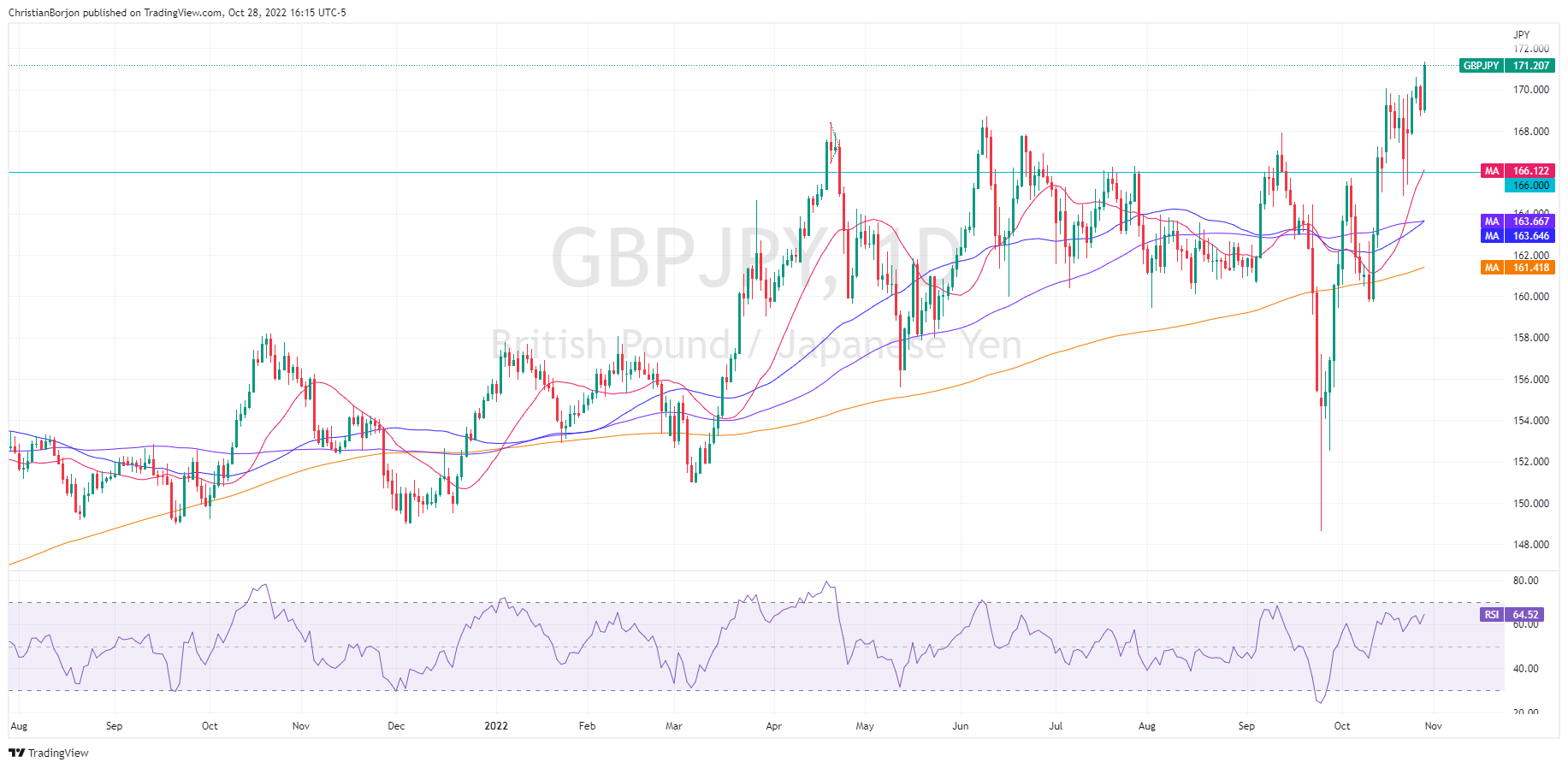
GBP/JPY Key Technical Levels
-
22:00
Mexico Fiscal Balance, pesos fell from previous -30.88B to -111.252B in September
-
21:18
Mexico Fiscal Balance, pesos: -111.25B (September) vs previous -30.88B
-
21:00
Colombia Interest rate in line with expectations (11%)
-
20:45
GBP/CAD's rally from 1.5655 reaches three-month highs above 1.5800
- The pound bounces up on Friday to retest the 1.5800 support area.
- Lower oil prices and a dovish BoC have hit the CAD.
- GBP/CAD: Above 1.5800, the pair eyes 1.6000 area.
The British pound has performed a surprising comeback against the Canadian dollar on Friday, bouncing up from the 1.5655 area to reverse Thursday’s decline and explore levels past 1.5800 for the first time since late June.
The CAD remains under pressure after BoC’s dovish hike
The Bank of Canada surprised the markets on Wednesday, hiking rates by "only" 50 basis points, against expectations of a 0.75% move. Furthermore, the bank's statement signaled the end of the tightening path on the back of the gloomy global economic prospects, which sent the Canadian dollar lower across the board.
Beyond that, the sluggish performance of crude prices, Canada’s main export, has increased pressure on the loonie. The US benchmark WTI oil is trading about 0.5% lower on the day, nearing $88.00 after having peaked at $89.70 on Thursday.
In the UK, the appointment of Rishi Sunak as the UK’s Prime Minister has kept the GBP moderately bid over the past few days. The pledge to restore economic stability at his first speech has calmed investors, spooked as they were by his predecessor’s economic plan.
GBP/CAD: Above 1.5800, the pair might reach the 1.60 area
A confirmation above 0.5800 is likely to strengthen the bullish bias and push the pair toward 1.5970 (the 200-day SMA) ahead of the 1.6000 psychological level and June’s peak.
The pair, however, might take a breather after a nearly 400-pip rally this week. Immediate support lies at 1.5645 (October 27 low) and then, the 100-day SMA at 1.5435. A reversal below this level would cancel the positive bias and open the path toward October 21 low at 1.5315.
Technical levels to watch
-
20:34
United States CFTC Oil NC Net Positions down to 249.1K from previous 251.5K
-
20:33
Japan CFTC JPY NC Net Positions: ¥-102.6K vs previous ¥-94.3K
-
20:33
United Kingdom CFTC GBP NC Net Positions climbed from previous £-51.2K to £-47.8K
-
20:33
Australia CFTC AUD NC Net Positions fell from previous $-35.4K to $-51.4K
-
20:33
European Monetary Union CFTC EUR NC Net Positions climbed from previous €48.1K to €74.9K
-
20:33
United States CFTC S&P 500 NC Net Positions climbed from previous $-223.2K to $-219.1K
-
20:33
United States CFTC Gold NC Net Positions down to $68K from previous $77K
-
20:11
EUR/JPY Price Analysis: Fluctuates around the 200-DMA subdued amid the lack of catalyst
- EUR/JPY is set to finish the week with decent gains of 0.88% after being down 2.40%.
- Short term, an EUR/JPY break above 147.00 will expose the YTD high; otherwise, a fall toward 146.00 is on the cards.
The EUR/JPY rebounds from a one-month-old upslope trendline and climbs back above 146.00, following the European Central Bank (ECB) monetary policy decision, which ended with the ECB lifting rates and laying the ground for subsequent hikes. However, the markets perceived a dovish hike, as the Euro dived against most G8 currencies. At the time of writing, the EUR/JPY is trading at 146.81, gaining 0.76%.
EUR/JPY Price Analysis: Technical outlook
The EUR/JPY daily chart illustrates the pair as upward biased, even though the Bank of Japan (BoJ) intervention was fruitful with the USD/JPY, dragging alongside some other Japanese Yen (JPY) crosses, including the EUR/JPY. However, since reaching a weekly low at 143.72, the cross-currency pair rallied 300 pips, set for weekly gains of almost 1%.
However, it should be noted that the Relative Strength Index (RSI), albeit in bullish territory, it has a downward slope. So, as price action registers successive series of higher highs, the RSI does the opposite, setting the pair for a negative divergence.
Short term, the EUR/JPY hourly chart portrays the pair as range-bound, with risks skewed to the upside due to the Exponential Moving Averages (EMAs) lying below the spot price, except for the 100-EMA, which sits around 146.93, a difficult resistance level to hurdle. But once it’s cleared, the next resistance would be 147.00, followed by the October 25 daily high at 147.72, ahead of the YTD high at 148.40.
On the flip side, if the EUR/JPY tumbles below the 200-EMA, the next demand area would be the confluence of the 20 and 50-EMAs around 146.55/60, once cleared, could lay the way towards the daily pivot at 146.32, ahead of the 146.00 figure.

EUR/JPY Key Technical Levels
-
19:53
EUR/GBP dives to 0.8575 after rejection at the 0.8650 area
- The euro extends losses after failing to regain 0.8650.
- Sunak's appointment as British PM has buoyed the GBP.
- EUR/GBP: Below 0.8585, the next targets are 0.8530 and 0.8490.
The euro depreciated against the pound for the fourth consecutive day on Friday, to test the support area at 0.8570 after having failed to breach the 0.8650 resistance area earlier today.
The GBP remains, supported by the Sunak effect
Sterling has remained moderately bid across the board this week, buoyed by the positive impact of the appointment of Rishi Sunak becoming as UK’s Prime minister. His commitment restore economic stability has eased the turmoil caused by his predecessor’s economic plan and has offered a good respite to the GBP.
In the absence of relevant macroeconomic releases in the UK, the Eurozone calendar has failed to provide support to the euro. The preliminary German GDP showed that the first economy of the eurozone has dodged recession, although CPI figures have confirmed that consumer inflation continues growing out of control.
Beyond that, the European Central Bank’s monetary policy decision increased negative pressure on the euro earlier this week. The bank hiked rates by 75 basis points and Christine Lagarde, the ECB chair, reiterated the commitment to continue tightening rates for some time, despite the negative economic projections.
EUR/GBP: Next downside targets are 0.8530 and 0.8490
From a technical point of view, the pair is now struggling to breach support at the 0.8585 area, where the 100-day SMA lies. Below here next downside targets would be the downward trendline support, from mid-November lows, now at 0.8535, and the 200-day SMA at 0.8500.
On the upside, a bullish reaction would have to extend past the mentioned 50-day SMA, at 0.8690 to aim for the October 21 high at 0.8780. A confirmation above the mentioned level would negate the bearish trend and open the path toward October 12 high at 0.8870.
EUR/GBP daily chart

Technical levels to watch
-
19:04
Silver Price Forecast: XAG/USD drops below $19.50 as traders brace for next week’s FOMC decision
- Silver prices tumble at the 100-day Exponential Moving Average (EMA), prolonging its losses to the 50-day EMA at $19.08.
- The US Core PCE expanded by 5.1% YoY, above estimates, paving the path for further tightening.
- Investors focus on November’s Fed monetary policy meeting, with expectations of the US central bank hiking 75 bps.
Silver price stumbles at a key resistance level as the New York session progresses due to US economic data justifying further Federal Reserve’s actions, while a risk-on impulse keeps safe-haven assets pressured, but the US Dollar, which bucked the trend, as the next week’s Federal Reserve monetary policy decision lurks. The XAG/USD is trading at $19.17 a troy ounce, down by 2%, after hitting a daily high at $19.63.
US core PCE justifies further Fed’s aggression
Wall Street extends its gains even though the greenback edges higher. A measurement of inflation revealed by the Commerce Department, which is also the Fed’s favorite inflation gauge, increased 0.5% MoM, above the previous month’s reading, justifying the need for additional rate hikes amidst a Fed pivot narrative circulating in the financial markets. Also, the year-over-year number jumped by 5.1%, exceeding forecasts of 4.9%
In a separate report, the Employment Cost Index (ECI), an indicator used by the Fed in addressing inflation on wages, increased by 1.2% in the July-September period, as reported by the Department of Labor.
Aside from inflation data, the University of Michigan Consumer Sentiment, on its October final reading, remained unchanged at 59.9, while inflation expectations barely moved. According to the survey, one-year horizon inflation is estimated at 5% from 5.1%, while for 5-years is estimated at 2.9%.
Of late, the Dallas Fed Trimmed Mean PCE for September edged lower from 6% to 4.3%. At the same time, the Atlanta Fed GDPNow Forecast for Q4 is 3.1%.
Silver is on the defensive as US Treasury yields jumped, underpinning the US Dollar
The market’s reaction to the US data was felt in the fixed-income markets, as treasuries sold off, which was positive news for bond yields. The US 10-year Treasury bond yield is gaining nine bps, up at 4.01%, a headwind for the precious metals segment.
In the meantime, the US Dollar Index, a gauge of the buck’s value vs. a basket of its rivals, advances 0.30% at 110.895, underpinned by
Now market participants turn to the next week’s Federal Reserve Open Market Committee (FOMC), in which most analysts expect the Fed to hike rates by 75 bps, as reported by the CME FedWatch Tool, with odds at an 84.5% chance. However, December’s meeting is split between 50 or 75 bps, with the majority of the investors
Silver Key Technical Levels
-
18:57
NZD/USD, capped at 0.5870, consolidates losses around 0.5800
- The kiwi extends losses after failure at 0.5870.
- The US dollar picks up amid a cautious market mood.
- NZD/USD expected to depreciate further over the coming weeks – Credit Suisse.
The New Zealand dollar is heading south for the second consecutive day on Friday, after having failed to break resistance at 0.5870 earlier today. The pair dives 0.5% on the day, although it remains on track to close a two-week recovery from the 2, ½ year low at 0.5510.
The kiwi loses steam as risk appetite fades
The positive price action witnessed in the first half of the week, lost traction on Thursday with the pair unable to find acceptance above 0.5870 as risk appetite ebbed and the US dollar started to regain lost ground.
US dollar bulls, however, have remained subdued with the investors on a cautious mood ahead of next week’s Fed monetary policy meeting. The market has priced in a 0.75% hike on Wednesday, although the odds for a shorter hike in December have increased substantially over the last few days, which is holding back US dollar longs.
Regarding the macroeconomic data, a set of US indicators has failed to provide a clear direction for the US dollar. US personal spending beat expectations, confirming that consumption, one of the main contributors to US GDP, has remained resilient in spite of the soaring inflation levels.
On the other hand, private wage growth has slowed down in the third quarter, suggesting that inflation might be nearing its peak, which would be consistent with the idea of the Federal Reserve softening its rate hike path.
NZD/USD expected to trend lower in the near term – HSBC
In a bigger picture, FX analysts at HSBC are expecting the pair to extend losses over the coming weeks: “NZD/USD is expected to go lower in the coming weeks on risk aversion (…) With a series of positive spending, migration, and inflation data in New Zealand, the market is not seeing hard-landing risks as pronounced as before. That said, the market is currently priced for an additional increase of 200 bps in policy rate by mid-2023, so damage to the economy may emerge over time.”
Technical levels to watch
-
18:23
AUD/USD attempting to bottom at 0.6390 after a two-day reversal from 0.6500
- The aussie is attempting to bounce up from 0.6390 after a reversal from the 0.6520 high.
- The cautious market mood has weighed on the AUD.
- AUD/USD could extend losses toward the 2020 low at 0.5506.
The Australian dollar is attempting to regain the 0.6400 area on Friday’s afternoon US session. The pair has found support at 0.6390 after having depreciated from the 0.6520 high on Thursday.
The aussie loses ground in a cautious market mood
The pair has given away most of the week’s gains over the last two days, with risk appetite fading and the investors adopting a more cautious stance, awaiting the outcome of the Federal Reserve’s monetary policy meeting due next week.
The Fed is widely expected to hike rates by 75 basis points for the fourth consecutive time, although the market is pricing in a lower rate hike in December, which has kept US dollar bulls subdued.
Friday’s US data has failed to provide a clear direction for the USD. The consumer spending figures have shown an unexpectedly high increase in September, showing that Americans continue going shopping despite the historical inflation levels.
On the other hand, private wage growth decelerated in the third quarter, which might be one of the first indicators suggesting a peak in inflation. Furthermore, Personal Consumption Expenditures remained flat at a 6.2% annual rate while the Core PCE, accelerated less than expected.
AUD/USD could revisit the 2020 low at 0.5506 – Credit Suisse
On the longer-term, FX analysts at Credit Suisse contemplate a sustained aussie depreciation: “With medium-term momentum staying bearish, we look for a fall to the 78.6% retracement of the 2020/21 uptrend and the low from April 2020 at 0.6041/5978 after the pause. Whilst we would not rule out another short pause here, a convincing break lower would raise a prospect for a move all the way to 0.5506 – the low of 2020.”
Technical levels to watch
-
18:22
United States Baker Hughes US Oil Rig Count: 610 vs previous 612
-
17:33
USD/CHF Price Analysis: Testing the key 200-hour EMA, as bulls eye the parity
- USD/CHF advances sharply, eyeing a break of the 200-hour EMA, which could expose parity.
- During the last two days, the USD/CHF has advanced more than 1% after bouncing from the weekly lows of around 0.9841.
- Further upside is expected as November’s Fed meeting looms.
The USD/CHF is gaining some traction in the North American session, surpassing the 20-day Exponential Moving Averages (EMA) at 0.9949, courtesy of positive fundamental data, opening the door for a re-test of parity ahead into the weekend. At the time of writing, the USD/CHF is trading at 0.9970, above its opening price by 0.63%.
USD/CHF Price Analysis: Technical outlook
From a technical perspective, the USD/CHF remains upward biased following the pullback from the YTD high at 1.0147 towards October’s 27 low at 0.9841 due to sellers failing to extend the USD/CHF losses below the 50-day EMA at 0.9809, which, could have exacerbated a fall towards the 100-day EMA at 0.9722. Instead, buyers stepped in, reclaimed the 20-day EMA, and are posing a threat of finishing the week above parity for back-to-back weeks. If that scenario plays out, the USD/CHF would be under upward pressure, and with the Federal Reserve’s meeting looming, a challenge of the YTD high could be on the cards.
Short term, the USD/CHF 1-hour chart depicts buyers are testing the 200-hour EMA at the confluence of the R1 daily pivot at 0.9980, which, if broken, could open the door to test the October 25 high and the R3 daily pivot level at 1.0031. It should be noted that the Relative Strength Index (RSI) is still in bullish territory, so buyers have some room to spare. On the downside, the R1 daily pivot at 0.9940 could cap any losses if the CHF strengthens at a specific time of the New York session, which is unlikely to happen as traders brace for the weekend. If it happens, then the confluence of the 100 and the 20-hour EMAs, around 0.9934/30, would be difficult to surpass, ahead of the 0.9900 figure.
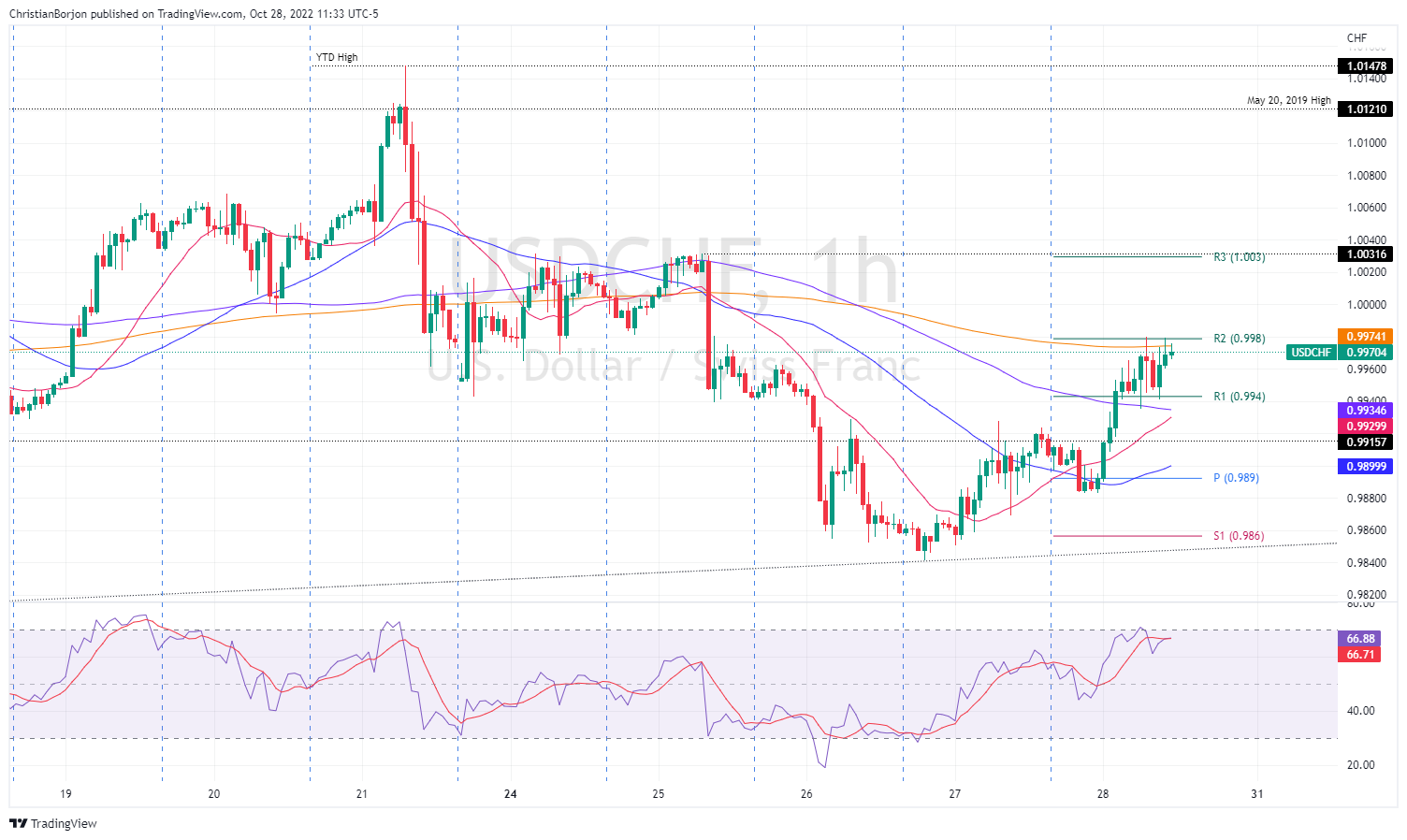
USD/CHF Key Technical Levels
-
17:32
GBP/USD erases daily losses and returns to the 1.1600 resistance area
- The pound reverses its previous downtrend and returns to the 1.1600 area.
- Rumors of Fed pivoting are keeping USD bulls on a leash.
- GBP/USD remains firm, likely to retest 1.1760 – UOB.
The pound bounced up right above 1.1500 earlier on Friday to regain lost ground during the European and US trading sessions and reach the 1.1600 resistance area. In a bigger picture, the pair remains trading in a range for the second consecutive day, consolidating gains after a two-day rally from levels below 1.1300 earlier this week.
Expectations of a softer Fed stance are weighing on USD bulls
Market expectations that the Federal Reserve might start softening its monetary tightening pace over the next months are keeping USD bulls in check.
Investors have already priced in a 0.75% hike in December, but the increasing rumors about the possibility of scaling down monetary tightening in December are curbing demand for the dollar.
Beyond that, the myriad of US macroeconomic data released on Friday has failed to provide a clear direction for the USD.
US personal spending has grown beyond expectations in September (0.6% against the consensus 0.4%) confirming that Americans have continued shopping, despite the soaring inflation, which maintains the US economy in good shape and clears the Fed’s path for another aggressive hike in December.
On the other hand, wage growth slowed down in the third quarter, according to data from the Labor Department, which suggests that inflation might have peaked or is close to doing so.
Furthermore, the US Personal Consumption Expenditures remained flat at a 6.2% yearly pace in September, while the Core PCE, the Fed’s preferred inflation gauge increased below expectations.
GBP/USD might appreciate to test 1.1760 resistance – UOB
FX analysts at UOB see the pair on a firm tone, and likely to test the 1.1760 area over the next weeks: Our expectation for GBP to ‘rise further’ yesterday did not materialize as it traded between 1.1550 and 1.1645 (…) “Yesterday (27 Oct, spot at 1.1630), we held the view that GBP is still strong and is likely to strengthen further. We indicated that the next level to monitor is at 1.1760.”
Technical levels to watch
-
17:28
BoE: Looking for a 75 bps rate hike next week – Rabobank
Next week, the Bank of England will have its monetary policy committee meeting. Analysts at Rabobank look for a 75 basis points rate hike to 3.00% from 2.25%. They explain that it would still be the largest rate hike of this cycle. They expect to see rates peaking at 4.75%.
Key Quotes:
“After the mini-Budget disaster of late-September, we shifted our call for the November MPC from +50 to +100 bps. We have dialled back our forecast to +75 bps, as most of the political and financial market upheaval has subsided. This is also the consensus among economists.”
“The central bank needs to show markets that it is cognizant that confidence in the UK’s institutional framework has been damaged, but there is no need for crisis management anymore. Still, a 75 bps hike would still be Britain’s largest of this cycle. We think it will also be a one-off, allowing the central bank to move back to a more gradual pace of 50 bps and then 25 bps rate increases this winter.”
“While inflation should remain around 10% in upcoming months, the outlook for growth has weakened markedly. Even as the August Monetary Policy Report was already sombre, forecasting a fifteen-month recession, we expect more of this gloominess rather than less.”
-
17:23
Canada: We still have at least some growth in the economy – CIBC
In Canada, August's GDP rose by 0.1% according to data released on Friday, slightly above market consensus for a flat reading, while the advance estimate for September pointed to a 0.1% increase. Analysts at CIBC point out that while growth was fairly modest during the third quarter, it will need to slow further in the fourth quarter and early 2023 to help bring inflation back down to target. The need for a further deceleration supports the notion that while the Bank of Canada is close to the end of its rate hiking cycle, it isn't done quite yet, they conclude.
Key Quotes:
“Including revisions, today's data is a little stronger than we had expected and puts the third quarter growth roughly in line with the Bank of Canada forecast, but slightly above our estimate. While we will be revising our overall 2022 growth expectation to be a tad higher, this does not alter our view that the economy will stall in the months ahead, and the lack of momentum late in Q3 is aligned with that.”
“With these latest growth figures only slightly below estimates of potential growth, we will need to see this further slowing of the economy to bring inflation back to target. This supports the notion that while we are getting closer to the end of the hiking cycle, there is still a little left to do. We continue to expect that the Bank of Canada will hike by a further 50bps before pausing.”
-
17:11
USD/CAD back above 1.3600 after another rebound from 1.3500
- USD/CAD about to end flat a volatile week.
- US dollar gains momentum on Friday despite risk appetite.
- Critical week ahead with FOMC and employment reports.
The USD/CAD is up for the second day in a row and moved further away from the one-month low it reached on Thursday below 1.3500. The pair is holding firm above 1.3600, about to end the week flat.
Loonie fails to break 1.3500 and retreats
Near the end of the week, USD/CAD is hovering around 1.3620/30, at the highest level in two days. The rebound from under 1.3500 reflects difficulties for the loonie to rise further and at the same time, that the dollar is not ready yet for a deeper correction, ahead of a critical week.
For the second time in October, USD/CAD managed to remain above 1.3500. The rebound so far has been limited. The next resistance stands at 1.3650 and above attention would turn to the 20-day Simple Moving Average at 1.3697.
After BoC, now FOMC and job data
Monthly GDP data in Canada came in above expectation with an expansion of 0.1% (consensus: 0%). “GDP registered slightly above expectations in August with a one tick increase. This rise was led by the services industry with gains stemming in part from retail and wholesale trade. The increase in retail outlays is likely to be short‑lived as consumers contend with a decline in purchasing power and rising interest bills”, explained analysts at the National Bank of Canada.
After the surprise dovish rate hike from the Bank of Canada on Wednesday, attention is back on economic numbers. Next week, the Canadian employment report is due on Friday. Also, the US will release employment numbers for October.
The key event in the US will be the FOMC meeting. On Wednesday, the central bank is expected to announce a 75 basis points rate hike. Market participants will look for clues about the next steps of the Fed and those expectations will likely define the direction of the US dollar.
Technical levels
-
16:45
USD/JPY’s rally from 146.00 loses steam above the 147.50 area
- The US dollar stalls around 147.50 after rallying from session lows near 146.00.
- The pair appreciates 0.8% on the day following a two-day reversal.
- US macroeconomic data has left the USD looking for direction.
The sharp greenback rally witnessed during Friday’s Asian and early European trading sessions, has lost steam after hitting 147.85. The pair, however, is consolidating gains above the 100-hour SMA, after a 0.8% daily appreciation.
The dollar treads water after the release of US data
The greenback has lost bullish momentum in the early US trading session, following the release of a set of first-tier US macroeconomic indicators. US consumer spending increased at a 0.6% pace in September, according to data released by the Department of Commerce, which shows that the US economy remains in good health and paves the Fed’s path for another jumbo hike in December.
On the other hand, wage growth slowed down to a 1.2% pace in the third quarter from 1.3% in the previous one, suggesting the possibility that inflation pressures might have peaked.
Furthermore, the Core Personal Consumption Expenditures, the Fed’s preferred gauge to measure inflationary trends, accelerated to a 5.1% annual rate in September, (from 4.9% in August) but below market expectations of a 5.2% reading. The overall PCE remained flat at a 6.2% yearly pace.
A dovish BoJ sends the yen tumbling
Before that, the Japanese yen had pared some of the previous days’ gains, hammered by the dovish rhetoric of the Bank of Japan’s monetary policy decision. The BoJ has confirmed its accommodative policy, as widely expected, leaving its target for short-term rates at -0.1% and reaffirming their commitment to keeping the 10-year bond yield near 0%.
Beyond that, BoJ President Kuroda stated that the bank is not planning “to raise interest rates or head for an exit (from the current policy) any time soon,", which has triggered a broad-based yen reversal.
Technical levels to watch
-
16:33
Yields: Pressure to ease as central bank approach a turning point – Danske Bank
The pressure on long yields is set to ease as central bank rates and inflation approach a turning point, explained analysts at Danske Bank. They expect markets to increasingly price inflation to come under control, amid a deteriorating growth outlook. Therefore they continue to see yields peaking in 2022 (if they don’t have already in October) and long yields declining slightly in 2023.
Key Quotes:
“10Y US Treasury yields last week briefly touched 4.30% and German Bunds 2.5%, meaning we had in fact passed our previous 3-month estimate. However, recent days have seen yields decline again, not least, following the ECB meeting. Hence, the big question is whether we have seen the peak in long yields for now.”
“We tentatively conclude that peak yield was probably reached in October and that long yields could retreat in 2023 as inflation expectations fall slightly and the anticipated recession unfolds. However, the trend is still likely to be up for central bank rates from both the ECB and the US Federal Reserve. In the coming months, we expect long yields to be particularly dependent on how inflation figures develop. We will also be keeping and ear open for announcements from the ECB about any upcoming halt to reinvestments (QT).”
“Much indicates we are now entering a period when the market is beginning to price a peak in inflation and at the same time beginning to glimpse the top of central bank rates. The ECB is expected to deliver its last rate hike in February and the Fed as early as December.”
-
16:32
Gold Price Forecast: XAUUSD pressured as core PCE jumps, justifying further Fed action
- Gold price records a fresh three-day low spurred by a strong US Dollar.
- The Fed’s preferred gauge for inflation, the Core PCE, smashed estimates, justifying additional action.
- US Treasury bond yields jumped, with the 10-year eyeing to recoup the 4% threshold.
Gold price slides and extends its losses below $1650 due to stubbornly high US inflation reported namely the Core Personal Consumption Expenditures (PCE), the Federal Reserve’s favorite gauge of inflation, which increased more than estimates, bolstering the US Dollar. Therefore, the XAUUSD is trading at $1641.62, diving 1.23%, eyeing the weekly lows of around $1638.
The Fed’s gauge of inflation justifies additional tightening
On Friday, the US Commerce Department revealed that September’s US inflation, as measured by the Core PCE, which strips volatile items like food and energy, jumped 0.5% MoM, higher than the previous reading, while annually based, escalated by 5.1%, above 4.9% forecasts by street’s analysts. In a separate report, the Employment Cost Index (ECI), an indicator used by the Fed in addressing inflation on wages, increased by 1.2% in the July-September period, as reported by the Department of Labor.
Given the backdrop, the so-called Fed pivot narrative could be tossed away as inflation remains stubbornly high and salaries are rising, despite the Federal Reserve’s effort to tame inflation.
Of late, additional US economic data was reported, with the University of Michigan (UoM) Consumer Sentiment unchanged at 59.9. Consumer’s inflation expectations for the 1-year horizon easied from 5.1% to 5%, and for a 5-years and beyond, were unchanged at 2.9%.
US Dollar bolstered on PCE data, Federal Reserve meeting eyed
After the data was released, the XAU remained on the defensive, as the reasons above will justify further Fed tightening. The US Dollar Index, a measure of the buck’s value against six currencies, is up 0.20%, at 110.78, while US Treasury yields, namely the 10-year benchmark rate, recover five bps up at 3.973%.
In the meantime, Wall Street holds to gains amidst a decent earnings season, keeping US equities in the green.
Now market participants turn to the next week’s Federal Reserve Open Market Committee (FOMC), in which most analysts expect the Fed to hike rates by 75 bps, as reported by the CME FedWatch Tool, with odds at an 84.5% chance. However, December’s meeting is split between 50 or 75 bps, with the majority of the investors
Gold Key Technical Levels
-
16:31
US: Consumers keep spending more than they earned – Wells Fargo
Data released on Friday showed real spending increased by 0.3% in September and August numbers were revised higher from 0.1% to 0.3%; the core PCE climbed to 5.1%. Analysts at Wells Fargo, point out that for the eighth time in nine months, consumers spent more money than they earned after adjusting for inflation in September. They argue that this spending is driven by an unsustainable draw-down of savings and over-reliance on credit, and they suspect it will not end well unless real disposable income picks up.
Key Quotes:
“The core PCE deflator, the teacher’s pet of inflation gauges for Fed policymakers, came in at 5.1% in September, up from 4.9% previously and echoing a similar rise in core CPI inflation. The key distinction is that today’s data do not mark a new cycle high for core PCE inflation. That milestone was reached in February when it hit 5.4%. Still, the quickening pace of core inflation more or less makes another 75 bps hike all but assured at the FOMC meeting this coming Wednesday, Nov. 2. That could mark the last 75 bps hike of this cycle if inflation slows markedly as we expect it to, which would allow for a more gradual pace of tightening.”
“The one caveat is if real disposable personal income growth continues to recover, households will receive a more sustainable source of purchasing power. Our baseline expectation is that while inflation is rolling over, it will be a long and bumpy way down, which will again exert some downward pressure on real disposable income growth in coming months. Furthermore, with most measures of labor demand beginning to top out, wage growth should soon moderate, and with this representing the largest source of income for most households, lower wage gains will bite into nominal personal income growth. Households thus will likely continue to save less of their monthly income to consume.”
-
15:59
USD/CAD: Close above 1.3650 may add to short-term upward momentum – Scotiabank
USD/CAD has rebounding from 1.35 support. The pair needs to surpass the 1.3650 zone to see further gains, economists at Scotiabank report.
USD/CAD finds additional support in the low-1.36s hard to come by
“USD/CAD pressured key support at 1.3505 on Thursday but failing to achieve a sustained break under the figure leaves the market prone to a rebound.”
“USD gains, have, however, been limited and there are signs in early trade here that USD is finding additional support in the low 1.36s hard to come by.”
“Gains through 1.3650 are needed for the USD recovery to extend intraday. A high close today for the USD may add to short-term upward momentum.”
-
15:58
EUR/USD back to the 0.9950 zone, up for the week but not that strong
- EUR/USD heads for weekly gains, but off highs.
- US Dollar without a clear direction on Friday ahead of Fed’s week.
- Wall Street posts important gains.
The EUR/USD is hovering around 0.9950, flat for the day and higher for the week. The euro climbed recently to 0.9990 but quickly pulled back, approaching daily lows as the US dollar moves sideways across the board.
The dollar trades without a clear direction, even after US data on Friday and ahead of a critical week. The DXY is up by 0.25% (mostly due to the USD/JPY rally) and US yields are off highs. In Wall Street, equity prices are up by more than 1.25% on average.
On a weekly basis, EUR/USD is about to end with a 100-pip gain but the fact that is has pulled back more than 150 pips from the high, is a negative sign for euro bulls. The pair peaked near the 20-week Simple Moving Average and then started to move to the downside.
Inflation vs growth
Data released on Friday, showed a new record high inflation reading in Germany during September with the annual rate reaching 10.4%. “There is no relief in sight, and the inflation rate is only likely to fall in the coming year because energy prices are unlikely to rise as strongly as they have this year, also due to government intervention. However, the underlying price pressure is likely to remain strong. Today's price data confirm our expectation of a double-digit euro area inflation rate in October”, said analysts at Commerzbank.
In the US, the Core PCE deflactor came in at 5.1% in September, slightly below the 5.2% of market consensus. It is not a fresh high but still remains elevated. Market participants continue to price in a 75 basis points at next week’s FOMC meeting.
The economic calendar for next week also includes Eurozone inflation and the US official employment report. Volatility appears to be warranted.
Technical levels
-
15:35
A major house price correction could be in the offing, implications for growth and inflation – ABN Amro
A potentially toxic cocktail for the housing market is emerging. Economists at ABN Amro judge that both the price correction as well as the implications for growth and inflation will be more moderate this time.
How vulnerable is the economy to a sharp fall in house prices?
“Falling real incomes and fast rising interest rates are marking an abrupt end to the housing boom – aggravated by looming recessions. Our base case is for a moderate correction, but house prices could ultimately drop by 20-30 percent.”
“The growth impact of deep housing market corrections would be strongest for the UK but milder in the eurozone and US. The drag on inflation would be biggest in the US.”
“Even if there is a major correction, strong financial buffers would prevent this from being systemic. A notable exception is in China, with its mainly self-inflicted problems that are of a different nature.”
-
15:07
EUR/USD and EUR/CHF to decline by a similar level – HSBC
EUR/CHF is set to shrug off developments in Switzerland. Thus, the direction of the EUR/USD pair will determine the next EUR/CHF move, economists at HSBC report.
USD/CHF could move sideways in the coming weeks
“EUR/CHF is set to be driven by EUR/USD, with little scope for Swiss-related drivers to get traction.”
“The Swiss National Bank (SNB) may be mindful of CHF weakness, but the recent moves have been modest and not enough to suggest action. The next SNB policy meeting is on 15 December, where the market is fully priced for a 50 bps hike and the 3 November release of Switzerland October CPI will be worth watching.”
“We expect both EUR/USD and EUR/CHF to decline by a similar level, so this means USD/CHF could move sideways in the coming weeks.”
-
15:03
US: Pending Home Sales decline by 10.2% in September vs -5% expected
- Pending Home Sales in the US fell at a stronger pace than expected in September.
- US Dollar Index trades flat on the day below 111.00 following earlier rally.
Pending Home Sales in the US declined by 10.2% on a monthly basis in September, the data published by the National Association of Realtors showed on Friday. This reading followed August's decrease of 1.9% and came in much worse than the market expectation for a contraction of 5%.
On a yearly basis, Pending Home Sales plunged by 31%, compared to analysts' estimate for a decline of 10.5%.
Market reaction
The dollar stays under modest bearish pressure after this data and the US Dollar Index was last seen trading virtually unchanged on the day at 110.62.
-
15:01
United States UoM 5-year Consumer Inflation Expectation remains at 2.9% in October
-
15:01
United States Michigan Consumer Sentiment Index came in at 59.9, above forecasts (59.8) in October
-
15:00
United States Pending Home Sales (YoY) came in at -31%, below expectations (-10.5%) in September
-
15:00
United States Pending Home Sales (MoM) came in at -10.2%, below expectations (-5%) in September
-
14:47
USD Index trims gains and slips back below 111.00
- The index loses momentum just above 111.00 on Friday.
- US Core PCE rose less than expected 5.1% YoY in September.
- Final Michigan Consumer Sentiment print comes next in the docket.
The USD Index (DXY), a measure of the greenback vs. its main competitors, deflates from the area of 2-day highs past the 111.00 yardstick at the end of the week.
USD Index capped by 111.00
Despite coming under pressure just above 111.00, the index maintains the bullish mood for the second session in a row amidst some recovery in the risk complex on Friday.
The corrective decline in the dollar remained unchanged after US inflation figures tracked by the PCE (the Fed’s favourite gauge) rose 6.2% in the year to September and 5.1% YoY when it comes to the Core PCE.
Additional releases for September saw Personal Income expand 0.4% MoM and Personal Spending increase 0.6% vs. the previous month. Later in the session, the final Michigan Consumer Sentiment and Pending Home Sales will close the weekly calendar.
Moving forward, the greenback should start trading in a prudent stance ahead of the FOMC event on November 2, where consensus remains almost fully favoured to a ¾ point rate raise of the Fed Funds Target Range (FFTR).
What to look for around USD
The dollar’s late recovery appears to have met some initial resistance in the area beyond the 111.00 barrier so far.
In the meantime, the firmer conviction of the Federal Reserve to keep hiking rates until inflation looks well under control regardless of a likely slowdown in the economic activity and some loss of momentum in the labour market continues to prop up the underlying positive tone in the index.
Looking at the more macro scenario, the greenback also appears bolstered by the Fed’s divergence vs. most of its G10 peers in combination with bouts of geopolitical effervescence and occasional re-emergence of risk aversion.
Key events in the US this week: PCE/Core PCE Price Index, Personal Income/Spending, Pending Home Sales, Final Michigan Consumer Sentiment (Friday).
Eminent issues on the back boiler: Hard/soft/softish? landing of the US economy. Prospects for further rate hikes by the Federal Reserve vs. speculation of a recession in the next months. Geopolitical effervescence vs. Russia and China. US-China persistent trade conflict.
USD Index relevant levels
Now, the index is gaining 0.07% at 110.64 and faces the immediate up barrier at 113.88 (monthly high October 13) seconded by 114.76 (2022 high September 28) and then 115.32 (May 2002 high). On the flip side, the breakdown of 109.53 (monthly low October 27) would open the door to 109.35 (weekly low September 20) and finally 107.68 (monthly low September 13).
-
14:45
GBP/USD to regain the 1.20 zone on hopes to re-establish fiscal credibility – Scotiabank
GBP/USD consolidates as government tries to re-establish fiscal credibility. Economists at Scotiabank believe that the pair could regain the 1.20 area.
Firm support on dips to the low/mid-1.14s area
“We still rather think the GBP has seen the worst of the recent turmoil and restoring credibility to government finances could help the pound regain the 1.20 zone after its recovery through the 1.14 area. But the delayed fiscal update is still a long way off, leaving the GBP subject to swings in the broader USD tone in the meantime.”
“We are bullish on the broader outlook for the GBP above the 1.14 level and expect firm support on dips to the low/mid 1.14 area from here.”
“Intraday gains through 1.1610 should cue renewed GBP gains.”
-
14:26
EUR/USD: Regaining 1.01 should allow gains to develop for a push on to 1.03 – Scotiabank
EUR/USD has bounced from the low-0.99s. The surpass of the 1.0100 zone could open up further gains, economists at Scotiabank report.
The undertone remains positive
“Despite the EUR’s late week drift from the 1.01 area, the undertone here remains positive.”
“Intraday losses have retested key support in the low 0.99s – former trend resistance, now support at – and held above it.”
“The EUR still has its work cut out to rally but regaining 1.01+ in the next few days should allow gains to develop for a push on to 1.03.”
-
13:43
Canada: Real GDP grows by 0.1% in August vs. 0% expected
- Canadian economy grew by 0.1% on a monthly basis in August.
- USD/CAD clings to modest daily gains above 1.3600 after the data.
Real Gross Domestic Product (GDP) in Canada grew by 0.1% on a monthly basis in August, Statistics Canada reported on Thursday. This reading followed July's expansion of 0.1% and came in slightly better than the market expectation of 0%.
"Advance information indicates that real GDP increased 0.1% in September," the publication further read. "Increases in the oil and gas extraction subsector, the manufacturing sector and the public sector were partially offset by declines in construction."
Market reaction
This data failed to help the loonie gather strength and USD/CAD was last seen trading in positive territory slightly above 1.3600.
-
13:31
United States Personal Consumption Expenditures - Price Index (YoY) came in at 6.2%, above forecasts (5.8%) in September
-
13:31
Breaking: US annual Core PCE inflation rises to 5.1% in September vs. 5.2% expected
Inflation in the US, as measured by the Personal Consumption Expenditures (PCE) Price Index, stayed unchanged at 6.2% on a yearly basis in September, the US Bureau of Economic Analysis announced on Friday.
The Core PCE Price Index, the Federal Reserve's preferred gauge of inflation, edged higher to 5.1% on a yearly basis from 4.9% in August, compared to analysts' estimate of 5.2%, and was up 0.5% in September.
Further details of the publication revealed that Personal Spending was up 0.6% in September and Personal Income rose by 0.4%.
Market reaction
The US Dollar Index retreated from daily highs with the initial reaction and was last seen rising 0.15% on the day at 110.76.
-
13:31
United States Core Personal Consumption Expenditures - Price Index (MoM) meets forecasts (0.5%) in September
-
13:31
United States Personal Income (MoM) came in at 0.4%, above expectations (0.3%) in September
-
13:31
United States Employment Cost Index meets forecasts (1.2%) in 3Q
-
13:31
Canada Gross Domestic Product (MoM) above forecasts (0%) in August: Actual (0.1%)
-
13:30
United States Personal Consumption Expenditures - Price Index (MoM) below forecasts (0.5%) in September: Actual (0.3%)
-
13:30
United States Core Personal Consumption Expenditures - Price Index (YoY) registered at 5.1%, below expectations (5.2%) in September
-
13:30
United States Personal Spending came in at 0.6%, above expectations (0.4%) in September
-
13:14
Gold Price Forecast: XAU/USD would benefit from the prospect of less aggressive Fed rate hikes – Commerzbank
Gold is trading at just shy of $1,660. If the market prices out future rate hikes to some extent, the yellow metal could thrive, strategists at Commerzbank report.
Eventful week for gold
“We envisage virtually no recovery potential for the gold price for as long as there is no end in sight to the aggressive rate hikes. Next week’s Fed meeting is therefore likely to have an important bearing on the gold price trend.”
“Another pronounced rate hike of 75 bps is generally anticipated after US inflation remained stubbornly high again in September, core inflation climbing to a 40-year high of 6.6%. That said, if the central bankers were to hint that they will raise their key rate at a less aggressive pace in future – in response to the cooling economy, for instance – the gold price could be lent some tailwind.”
-
13:04
Germany: Annual CPI rises to 10.4% in October vs. 10.1% expected
- Inflation in Germany rose at a stronger pace than expected in October.
- EUR/USD trades in negative territory at around 0.9950 after hot German CPI data.
Annual inflation in Germany, as measured by the Consumer Price Index (CPI), climbed to 10.4% in October from 10% in September, Germany's Destatis reported on Friday. This reading came in higher than the market expectation of 10.1%.
Meanwhile, the Harmonised Index of Consumer Prices (HICP), the European Central Bank's (ECB) preferred gauge of inflation, jumped to 11.6% from 10.9%, compared to analysts' estimate of 10.9%.
On a monthly basis, the CPI and the HICP arrived at 0.9% and 1.1%, respectively, surpassing market forecasts.
Market reaction
The EUR/USD pair showed no immediate reaction to these figures and was last seen losing 0.08% on the day at 0.9955.
-
13:01
Chile Industrial Production (YoY): -1.6% (September) vs -5%
-
13:01
Germany Harmonized Index of Consumer Prices (YoY) came in at 11.6%, above expectations (10.9%) in October
-
13:01
Germany Harmonized Index of Consumer Prices (MoM) registered at 1.1% above expectations (0.6%) in October
-
13:01
Germany Consumer Price Index (YoY) above expectations (10.1%) in October: Actual (10.4%)
-
13:01
Chile Unemployment rate in line with forecasts (8%) in September
-
13:00
Germany Consumer Price Index (MoM) registered at 0.9% above expectations (0.6%) in October
-
12:42
USD Index to challenge the top end of its recent trading range of 110-115 – HSBC
The USD has long led from the front and has not yet hit the “wall.” Economists at HSBC expect the US Dollar Index (DXY) to test the 115 level.
Fed to deliver a widely expected 75 bps hike
“We look for the USD uptrend to extend, with DXY likely to challenge the top end of its recent trading range of 110-115.”
“The key US-centric pinch-point for the USD is the 1-2 November Federal Open Market Committee (FOMC) meeting. The Federal Reserve (Fed) is likely to deliver a widely expected 75 bps hike and is expected to argue a data-dependant outcome in its forward guidance, with the market currently priced in an 88% chance of a 75 bps follow-up hike in December (Bloomberg, 20 October 2022).”
“We think that the tightness in the labour market (likely reflected in the US employment report for October to be released on 4 November) will continue to foster concerns about service-driven inflation pressures even as core goods inflation slows. The renewed pick-up in gasoline prices since mid-September, together with food prices and other energy prices, is putting upward pressure on US CPI. The inflation for October will be released on 10 November.”
-
12:27
EUR/USD Price Analysis: Next on the upside comes 1.0100
- EUR/USD comes under renewed downside pressure well below parity.
- The resumption of the bid bias targets the October top near 1.0100.
EUR/USD extends the corrective downside to the 0.9930/25 band on Friday.
In case bulls regain the upper hand, the surpass of the 1.0100 zone could spark a more serious recovery in the short-term horizon. That said, the immediate barrier is now expected at the September top at 1.0197 (September 12) ahead of the August peak at 1.0368 (August 10).
In the longer run, the pair’s bearish view should remain unaltered while below the 200-day SMA at 1.0502.
EUR/USD daily chart
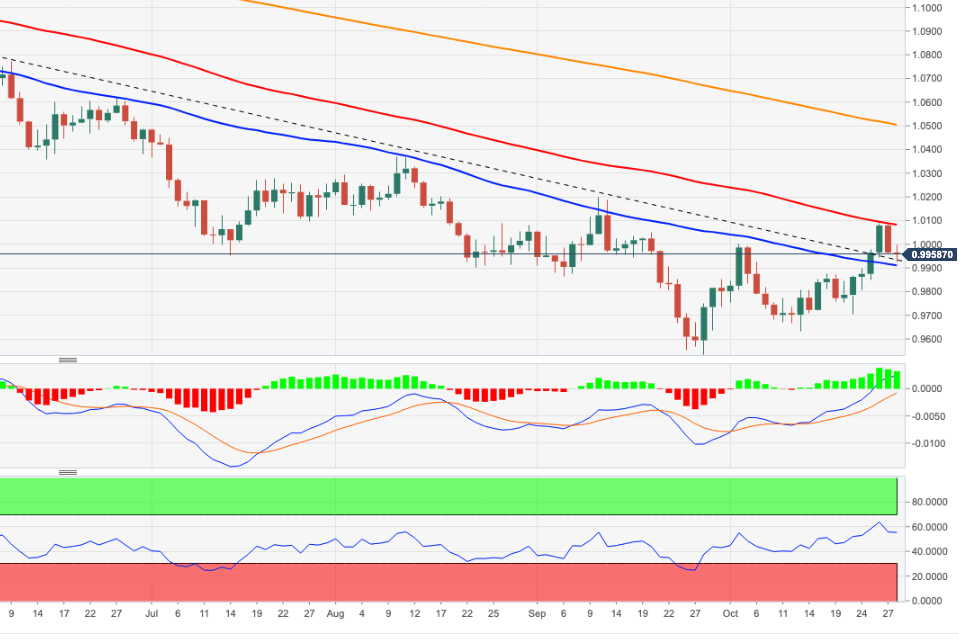
-
12:21
EUR/USD to trade at parity by year-end – ABN Amro
EUR/USD has come above parity. Still, economists at ABN Amro expect the pair to end the year at 1.00.
Euro to remain under pressure versus the US dollar this year
“An energy crisis and a recession in the eurozone combined with a more aggressive path of rate hikes in the US compared to the eurozone will probably keep the euro under pressure versus the US dollar this year.”
“When financial markets calm down somewhat again, lower safe haven demand for the dollar could result in a recovery of EUR/USD.”
“Our forecasts for EUR/USD for end 2022 stands at 1.00.”
-
12:07
Australia: RBA seen raising the OCR further in November – UOB
Economist at UOB Group Lee Sue Ann suggests the RBA would keep the tightening bias well in place at the November 1 meeting.
Key Quotes
“The latest Federal Budget, unveiled on 25 Oct, displayed strong fiscal discipline, which is crucial and consistent with RBA’s efforts to curb inflation. Notably, both headline and underlying inflation for 3Q22 came in higher than expectations. But we believe inflation will likely peak in 4Q22, in the absence of further significant global shocks.”
“We are penciling in a 25bps hike in the official cash rate (OCR) to 2.85% at this meeting.
-
12:00
Brazil Inflation Index/IGP-M below expectations (-0.8%) in October: Actual (-0.97%)
-
11:53
USD Index Price Analysis: Focus is now on 114.00 and above
- DXY adds to Thursday’s important advance and revisits 111.00.
- The continuation of the recovery should target 114.00.
DXY climbs to 3-day highs just above the 111.00 barrier at the end of the week.
Despite the dollar remains under pressure, the likelihood of further gains remains on the table while above the 8-month support line near 108.50. The proximity of the 100-day SMA also reinforces this area of contention. Against that, the next hurdle of relevance aligns at the October highs around 114.00.
In the longer run, DXY is expected to maintain its constructive stance while above the 200-day SMA at 104.07.
DXY daily chart
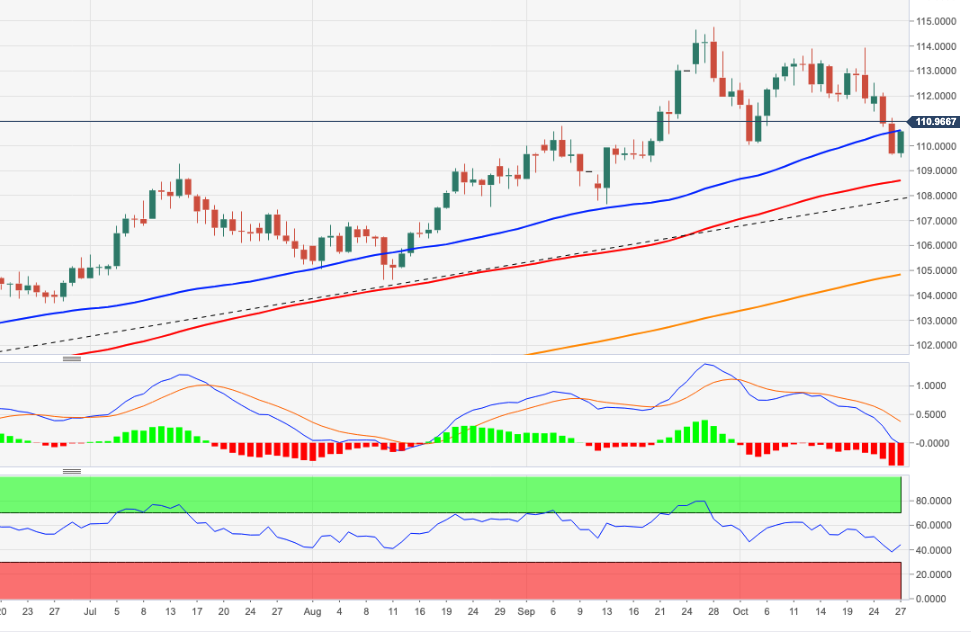
-
11:40
EUR/JPY Price Analysis: Upside target remains at the 2022 high
- EUR/JPY regains poise and reclaims part of the ground lost on Thursday.
- Immediately to the upside comes the YTD high at 148.40.
EUR/JPY resumes the upside and surpasses the 147.00 barrier at the end of the week.
Considering the current price action, there is still chances for the cross to advance further in the short-term horizon. That said, the immediate up barrier now emerges at the 2022 high at 148.40 (October 21) ahead of the December 2014 top at 149.78 (December 8).
In the short term the upside momentum is expected to persist while above the October lows near 141.00.
In the longer run, while above the key 200-day SMA at 137.27, the constructive outlook is expected to remain unchanged.
EUR/JPY daily chart
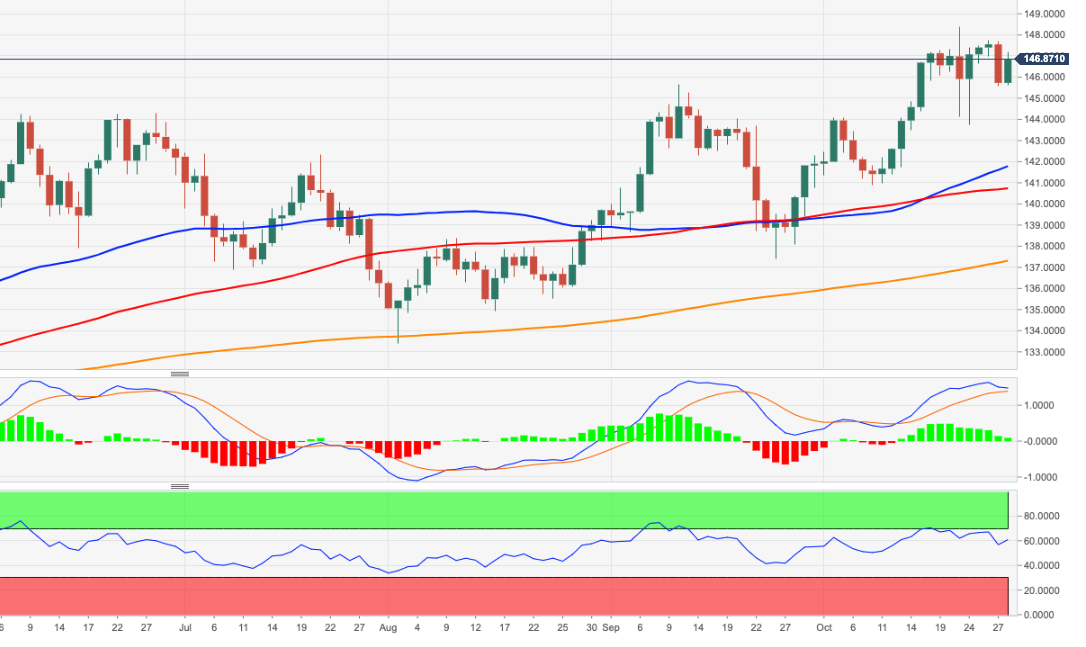
-
11:39
USD Index to stage a stronger rally if Fed disappoints expectations for a slowdown in the pace of hikes – MUFG
The US dollar is staging a modest rebound following the heavy sell-off. Market participants are becoming more confident that the Fed will at least slow the pace of hikes. The Fed needs to disappoint these expectations to provide further fuel to the greenback, economists at MUFG Bank report.
All eyes on next week’s FOMC meeting
“The US Dollar Index has found support at the bottom of its recent trading range between 110.00 and 115.00. However, the scope for the US dollar to extend its rebound ahead of next week’s FOMC meeting should remain limited given that market participants will still be nervous over a potential dovish shift in Fed policy guidance that could quickly pull the rug from under a dollar rebound.”
“For the US dollar to stage a stronger rally, the Fed will need to disappoint market expectations for a slowdown in the pace of hikes later this year.”
-
11:31
South Korea: GDP surprised to the upside in Q3 – UOB
Economist at UOB Group Ho Woei Chen reviews the recently published GDP figures in South Korea.
Key Takeaways
“South Korea’s advance GDP for 3Q22 outperformed market’s expectations at 3.1% y/y and picked up pace from 2.9% in 2Q22. On a seasonally-adjusted q/q basis, GDP expanded by 0.3% in 3Q22 compared to 0.7% in 2Q22, in line with Bloomberg’s consensus forecast. This is the 9th straight quarter of sequential growth. All the major expenditure components registered positive growth momentum.”
“Factoring in the stronger-than-expected 3Q22 GDP, South Korea’s full-year 2022 growth could be marginally better than our forecast of 2.7%. Assuming GDP growth moderates to 2.2% y/y in 4Q22, the full-year growth will be around 2.8%. We retain our forecast for the economy to ease more evidently to 1.7% in 2023 due to the multitude of downside risks. We will review our estimates following the release of the final 3Q22 GDP data on 1 Dec.”
“As for the monetary policy, our ‘terminal rate’ forecast remains at 3.50% as guided by the BoK in the Oct monetary policy meeting. A 50bps rate hike to 3.50% in Nov remains on the table for now as we think that the central bank may see merits to frontload its rate hikes given the high domestic inflation. The BoK made it clear that US Fed rate trajectory does hold some sway over its rate decision due to the impact on the currency market. Ahead of the 24 Nov rate meeting, South Korea’s Oct CPI data on 02 Nov and 01/02 Nov FOMC as well as sentiment towards the KRW could potentially affect the outcome.”
-
11:30
Russia Interest rate decision meets forecasts (7.5%)
-
11:15
Falling OPEC+ supply should lend support to oil prices – Commerzbank
Reuters and Bloomberg will be publishing their surveys of OPEC production in October at the beginning of next week. Falling supply is set to underpin oil prices, with Brent Crude Oil trading around $96, strategists at Commerzbank report.
Oil market is likely to tighten
“Output is likely to have fallen marginally, in line with the OPEC+ decision, before it is reduced considerably more sharply in November. The deviation from the agreed production target will probably remain sizeable given that many OPEC countries have already been falling significantly short of their targets for months now.”
“The oil market is likely to tighten as a result, especially since the EU’s oil embargo that will come into force in early December should likewise drive down the supply of oil from Russia.”
“We see Brent well supported at its current level of around $96 per barrel.”
-
11:07
Ireland Retail Sales (YoY) declined to -7% in September from previous -5.6%
-
11:07
Ireland Retail Sales (MoM) dipped from previous 2% to -3.1% in September
-
11:01
Portugal Consumer Price Index (YoY) increased to 10.2% in October from previous 9.3%
-
11:01
Portugal Consumer Price Index (MoM) climbed from previous 1.2% to 1.3% in October
-
10:52
Belgium Consumer Price Index (YoY) up to 12.27% in October from previous 11.27%
-
10:52
Belgium Consumer Price Index (MoM): 2.37% (October) vs 0.96%
-
10:50
EUR/USD eyes a fresh challenge of 0.95 over the coming months – HSBC
EUR/USD is trading slightly below parity. Economists at HSBC expect the world’s most popular currency pair to challenge the 0.95 level.
Risk aversion could pull the euro lower
“We expect the EUR to weaken against the USD, with a fresh challenging of 0.95 over the coming months.”
“The increased risk of a recession in the region that this inflation battle creates may also see the EUR struggle. Risk aversion is another force that could pull the EUR lower.”
See: EUR/USD to decline towards the low-0.90s – Danske Bank
-
10:34
Japan’s Suzuki: Govt continues to expect BOJ to conduct appropriate monetary policy
The “goverment continues to expect the Bank of Japan (BOJ) to conduct appropriate monetary policy,” Japanese Finance Minister Shunichi Suzuki said on Friday.
Additional quotes
Must be mindful of adhering to fiscal discipline.
Learned lesson from british experience that once trust in fiscal management is lost, govts could come under attack from markets.
Important to consider exit strategy from fiscal stimulus in future.
Securing stable funding sources is important to increase defence budget.
Govt has topped up budget reserves in order to respond to uncertainties such as risk of global economic slowdown.
Govt, BOJ share basic stance on economy.
-
10:31
Italy 10-y Bond Auction down to 4.24% from previous 4.7%
-
10:31
Italy 5-y Bond Auction declined to 3.48% from previous 4.12%
-
10:20
USD/JPY rallies towards 148.00 on BOJ’s dovish rhetoric, Japan’s stimulus news
USD/JPY extends its relentless rally in the European session this Thursday, as the Bank of Japan’s (BOJ) status-quo on its monetary policy settings combined with the dovish rhetoric from Governor Haruhiko Kuroda revived the yen selling.
Meanwhile, the extended recovery in the US dollar across its major peers, in the wake of the upbeat American advance Q3 GDP and end-of-the-week flows, also aids the renewed upside the pair.
The pair is rallying 1% on the day to trade at 147.71, looking to recapture the 148.00 level. In doing so, the major is staging a solid comeback from the 146.00 support zone, tested on the central bank’s policy announcements.
Meanwhile, Japanese Prime Minister Fumio Kishida said on Friday, “with the package, govt will aim to push down Japan's CPI by 1.2% or more.”
Additional quotes
“Will take steps so Japan doesn't experience the kind of 10% inflation seen in the US, European countries.”
“Will seek cooperation of business lobby Keidanren, union umbrella rengo to ensure wages rise enough to compensate accelerating inflation.”
The country’s Finance Minister Shunichi Suzuki said that they are aiming to enact extra budget by the year-end.
He added that “Japan's fiscal situation has become more severe due to rounds of stimulus to cope with covid.”
USD/JPY technical levels
-
10:17
USD/JPY: Dovish BoJ underpins a weaker yen, but a peak in global risks eases pressure – MUFG
USD/JPY has moved back up closer to the 147.00 level after it hit a low yesterday of 145.11 after the Bank of Japan (BoJ) announced that it left its policy settings unchanged. Nonetheless, the pullback in yields outside of Japan provides some relief to the yen, economists at MUFG Bank report.
BoJ sticks to loose policy
“The continuation of the BoJ’s loose policy settings leaves the yen vulnerable to further weakness and keeps the onus on direct intervention to dampen the pace of yen selling.”
“The Japanese authorities are at least getting some temporary relief from the pullback in yields outside of Japan over the past week which is helping to discourage speculative yen selling alongside the risk of intervention. After peaking at the end of last week, yields outside of Japan have dropped back sharply driven in part by building speculation over a dovish pivot for central bank policies amidst intensifying fears over a sharper slowdown/hard landing for the global economy.”
“The BoJ’s dovish policy stance continues to encourage a weak yen but downside risks are beginning to ease as global yields are beginning to peak in the near-term.”
-
10:10
European Monetary Union Business Climate dipped from previous 0.81 to 0.76 in October
-
10:06
Eurozone Final Consumer Confidence improves to -27.6 in October, meets estimates
Eurozone's Final Consumer Confidence Index came in at -27.6 in October vs. -28.8 recorded previously, according to the latest data release from the European Commission. The data m the market expectations of -27.6.
Meanwhile, the bloc’s Economic Sentiment Indicator for October dropped to 92.5 vs. 92.5 expected and 93.6 previous.
Sentiment in the industry worsened to -1.2 points from -0.3 in October and for services, the economy's biggest sector, to 1.8 from 4.4 n September.
Market reaction
EUR/USD is keeping its range around 0.9950, paying little heed to the mixed Eurozone sentiment data. The pair is shedding 0.10% on the day, at the press time.
-
10:01
Italy Consumer Price Index (YoY) came in at 11.9%, above forecasts (9.6%) in October
-
10:01
Italy Consumer Price Index (EU Norm) (YoY) came in at 12.8%, above forecasts (9.9%) in October
-
10:01
Italy Consumer Price Index (EU Norm) (MoM) came in at 4%, above expectations (1.4%) in October
-
10:01
Italy Consumer Price Index (MoM) above expectations (1.2%) in October: Actual (3.5%)
-
10:00
European Monetary Union Consumer Confidence meets forecasts (-27.6) in October
-
10:00
European Monetary Union Industrial Confidence registered at -1.2 above expectations (-1.8) in October
-
10:00
European Monetary Union Services Sentiment came in at 1.8 below forecasts (3.3) in October
-
10:00
European Monetary Union Economic Sentiment Indicator meets expectations (92.5) in October
-
09:54
GBP/USD to face further downward pressure in the coming weeks – HSBC
Despite policy U-turns, the GBP still faces structural and cyclical challenges. Therefore, economists at HSBC expect GBP/USD to head lower in the coming weeks.
Further tough fiscal decisions will be required
“A series of fiscal policy U-turns, alongside temporary support for the UK government bond (known as ‘gilt’) market from the Bank of England (BoE), have provided relief for the GBP for now. However, with the UK’s fiscal, monetary and political challenges, the GBP is likely to face further downward pressure in the coming weeks.”
“For the British government, further tough fiscal decisions will be required, as debt-to-GDP ratios are set to rise and the fiscal deficit could land at about 6% of GDP.”
“For the 3 November BoE meeting, the GBP could suffer from a BoE tone that suggests the economic outlook may be even weaker than previously expected and that the market is too hawkish on rate hikes.”
-
09:32
Portugal Business Confidence down to 1.3 in October from previous 1.6
-
09:31
Portugal Consumer Confidence down to -35.2 in October from previous -32.7
-
09:22
USD Index: Maybe 110 does prove support after all – ING
The dollar holds its ground against its rivals early Friday. For today, the highlight will probably be US price data, including the Q3 Employment Cost Index (ECI) release. Any upside surprise would lift the greenback, economists at ING report.
Dollar to remain bid on dips
“The hot story will be US price data. We get to see the Q322 ECI. Consensus expects the Q3 ECI to soften to the 1.2% QoQ area in today's release. Any upside surprise could push the pricing of the Fed terminal rate (now 4.75% and off a recent high at 5.00%) higher. This would be dollar positive.”
“Maybe 110 does prove support for DXY after all.”
-
09:14
EUR/USD: Bears remain in control around 0.9940 ahead of key data
- EUR/USD sheds further ground and revisits 0.9940/35.
- Germany Flash GDP Growth Rate comes in at 1.2% YoY in Q3.
- PCE, Personal Income/Spending, U-Mich Index due later in the NA session.
The selling bias persists around the European currency and drags EUR/USD back to the 0.9940/35 band at the end of the week.
EUR/USD now looks at data
EUR/USD drops to 3-day lows and extends the pessimism into the second half of the week amidst the continuation of the rebound in the greenback and the generalized loss of momentum in the risk-linked galaxy.
The recovery in the pair lies in contrast to the rebound in the German 10-year bund yields, which manage to regain the 2.05% hurdle following the recent drop to the sub-2.00% area.
In the meantime, investors continue to digest the dovish tone at the ECB meeting on Thursday, after the central bank hiked the refi rate by 75 bps, matching consensus. Staying with the ECB, board member Villeroy suggested that there is no obligation to raise rates by another 75 bps at the next gathering. In addition, his colleague Simkus added that inflation projections are expected to be increased in December.
On the euro docket, flash GDP results see the German economy expanding 1.2% YoY in Q3 and 0.3% QoQ. Additionally, advanced inflation figures in France see the CPI rising 6.2% in the year to October. Later in the session, preliminary figures in Germany are also due along with EMU’s Consumer Confidence and Economic Sentiment.
In the US, the focus of attention will be on the release of the PCE and Core PCE along with Personal Income/Spending, the final October Consumer Sentiment and Pending Home Sales.
What to look for around EUR
EUR/USD remains on the defensive and leaves the door open to further retracement to the 0.9900 neighbourhood in the near term.
In the meantime, price action around the European currency is expected to closely follow dollar dynamics, geopolitical concerns and the Fed-ECB divergence. The resurgence of speculation around a potential Fed pivot seems to have removed some strength from the latter, however.
Furthermore, the increasing speculation of a potential recession in the region - which looks propped up by dwindling sentiment gauges as well as an incipient slowdown in some fundamentals – adds to the fragile sentiment around the euro in the longer run.
Key events in the euro area this week: France/Italy/Germany Flash Inflation Rate, German Preliminary Q3 GDP Growth Rate, EMU Final Consumer Confidence, Economic Sentiment
Eminent issues on the back boiler: Continuation of the ECB hiking cycle vs. increasing recession risks. Impact of the war in Ukraine and the persistent energy crunch on the region’s growth prospects and inflation outlook.
EUR/USD levels to watch
So far, the pair is retreating 0.27% at 0.9936 and the breakdown of 0.9908 (55-day SMA) would target 0.9704 (weekly low October 21) en route to 0.9631 (monthly low October 13). On the upside, there is an initial hurdle at 1.0093 (monthly high October 27) followed by 1.0197 (monthly high September 12) and finally 1.0368 (monthly high August 10).
-
09:08
Italy Producer Price Index (YoY) registered at 41.8%, below expectations (44.2%) in September
-
09:08
Italy Producer Price Index (MoM) below forecasts (4.4%) in September: Actual (2.8%)
-
09:02
German Preliminary GDP expands 0.3% QoQ in Q3 vs. -0.2% expected
- German GDP arrives at 0.3% QoQ in Q3 vs. -0.2% expected.
- Annualized German GDP stands at 1.1% in Q3 vs. 0.7% expected.
- EUR/USD remains unfazed by the upbeat German Q3 growth figures.
The German economy expanded 0.3% inter-quarter in the third quarter of 2022 when compared to the expectations of -0.2% and 0.1% reported in Q2, the preliminary report published by Destatis showed on Friday.
Meanwhile, the annualized GDP rate rose by 1.1% in Q3 against the previous reading of 1.8% and matched the market expectations of a 0.7% figure.
FX implications
EUR/USD remains unimpressed by the above forecast German growth numbers, as the sentiment remains sour, which revives the US dollar’s safe-haven demand.
The major was last seen trading at 0.9940, down 0.20% on the day.
About German Prelim GDP
The Gross Domestic Product released by the Statistisches Bundesamt Deutschland is a measure of the total value of all goods and services produced by Germany. The GDP is considered as a broad measure of German economic activity and health. A high reading or a better-than-expected number has a positive effect on the EUR, while a falling trend is seen as negative (or bearish).
-
09:01
Norway Registered Unemployment n.s.a meets expectations (1.6%) in October
-
09:01
Norway Registered Unemployment s.a declined to 58.38K in October from previous 59.16K
-
09:01
Italy Producer Price Index (MoM) came in at 1.6%, below expectations (4.4%) in September
-
09:01
Germany Gross Domestic Product (QoQ) above expectations (-0.2%) in 3Q: Actual (0.3%)
-
09:01
Germany Gross Domestic Product w.d.a (YoY) came in at 1.1%, above expectations (0.7%) in 3Q
-
09:01
Germany Gross Domestic Product (YoY) registered at 1.2% above expectations (0.8%) in 3Q
-
08:49
USD/CNH risks a deeper pullback near term – UOB
According to UOB Group’s Markets Strategist Quek Ser Leang and Rates Strategist Victor Yong, USD/CNH could grind lower to the 7.1500 region in the short term.
Key Quotes
24-hour view: “The strong rebound in USD to 7.2686 came as a surprise (we were expecting USD to weaken further). We view the price movement as part of an on-going consolidation and expect USD to trade within a range of 7.2150/7.2650.”
Next 1-3 weeks: “We continue to hold the same view as yesterday (27 Oct, spot at 7.1870). As highlighted, the recent USD strength has ended. The large pullback on Wednesday has room to extend to 7.1500, possibly 7.1300. However, a break of 7.2850 (no change in ‘strong resistance’ level) would indicate that the pullback is not extending lower.”
-
08:48
NZD/USD to go lower in the coming weeks on risk aversion – HSBC
NZD/USD has established above 0.58. However, economists at HSBC expect the pair to edge lower in the coming weeks.
Damage to the economy may emerge over time
“NZD/USD is expected to go lower in the coming weeks on risk aversion.”
“With a series of positive spending, migration, and inflation data in New Zealand, the market is not seeing hard-landing risks as pronounced as before. That said, the market is currently priced for an additional increase of 200 bps in policy rate by mid-2023, so damage to the economy may emerge over time.”
-
08:45
USD Index extends the upside momentum and targets 111.00 ahead of data
- The index adds to Thursday’s advance and approaches 111.00.
- The risk complex remains on the defensive following the ECB event.
- Core PCE, Final Consumer Sentiment next on tap in the docket.
The greenback picks up extra pace in the second half of the week and approaches the key 111.00 region when measured by the USD Index (DXY) on Friday.
USD Index now looks to data
The index advances for the second session in a row and extends the bounce off Thursday’s lows in the 109.50 zone, always on the back of the sour mood surrounding the risk-associated universe.
Indeed, the riskier assets shed further ground as market participants continue to digtest Thursday’s dovish hike by the ECB and the steady stance from the BoJ at its event earlier in the Asian trading hours.
The recovery in the dollar comes in tandem with the rebound in US yields across the curve, partially leaving behind several sessions trading in the negative territory.
Later in the NA session, inflation figures tracked by the PCE and Core PCE will take centre stage seconded by Personal Income/Spending, the final Michigan Consumer Sentiment gauge for the month of October and Pending Home Sales.
What to look for around USD
The dollar extends the rebound from multi-week lows and now shifts the focus to the 111.00 hurdle.
In the meantime, the firmer conviction of the Federal Reserve to keep hiking rates until inflation looks well under control regardless of a likely slowdown in the economic activity and some loss of momentum in the labour market continues to prop up the underlying positive tone in the index.
Looking at the more macro scenario, the greenback also appears bolstered by the Fed’s divergence vs. most of its G10 peers in combination with bouts of geopolitical effervescence and occasional re-emergence of risk aversion.
Key events in the US this week: PCE/Core PCE Price Index, Personal Income/Spending, Pending Home Sales, Final Michigan Consumer Sentiment (Friday).
Eminent issues on the back boiler: Hard/soft/softish? landing of the US economy. Prospects for further rate hikes by the Federal Reserve vs. speculation of a recession in the next months. Geopolitical effervescence vs. Russia and China. US-China persistent trade conflict.
USD Index relevant levels
Now, the index is gaining 0.27% at 110.87 and faces the immediate up barrier at 113.88 (monthly high October 13) seconded by 114.76 (2022 high September 28) and then 115.32 (May 2002 high). On the flip side, the breakdown of 109.53 (monthly low October 27) would open the door to 109.35 (weekly low September 20) and finally 107.68 (monthly low September 13).
-
08:31
EUR/USD to tick down toward the 0.9910/20 area – ING
EUR/USD stays relatively quiet below parity. Economists at ING expect the pair to edge lower towards the 0.9910/20 zone.
A dovish 75 bps hike?
“The ECB hiked rates by 75 bps, but in some ways, it could have been described as a dovish hike. Certainly, interest rate markets took note of the reference to 'substantial progress being made in withdrawing monetary accommodation' and took 30 bps off the pricing of the terminal ECB rate, which is now priced at 2.50%. We still think that it is too high.”
“For today, EUR/USD might bounce around a little as ECB hawks brief the media that the central bank's statement was not quite as dovish as the market has interpreted. But we think the dollar should stay supported into next week's FOMC meeting and would favour EUR/USD edging down today to the 0.9910/20 area – marking the top of a bear trend channel which was recently broken.”
-
08:04
AUD/USD Price Analysis: Bears seek validation from 0.6430 support
- AUD/USD holds lower ground near intraday bottom, keeps latest pullback from three-week high.
- Bearish MACD signals, clear U-turn from the key resistance lines keep sellers hopeful.
- 100-SMA could probe bears on the way to yearly low.
AUD/USD sellers poke the weekly support line near the intraday low surrounding 0.6430. In doing so, the Aussie pair prints the second consecutive intraday loss during early Friday morning in Europe.
Given the bearish MACD signals, as well as the pair’s sustained pullback from the six-week-old and three-week-long resistance lines near 0.6500, the AUD/USD prices are likely to break the immediate support line near 0.6430.
Following that, the 100-SMA support level near the 0.6330 and the 0.6300 round figure may test the AUD/USD bears before directing them to the yearly low surrounding 0.6170.
Alternatively, a confluence of the aforementioned resistance lines around 0.6500 appears a tough nut to crack for the AUD/USD buyers, a break of which could quickly propel the prices towards the monthly high near 0.6550.
In a case where AUD/USD buyers keep the reins past 0.6550, the mid-September highs near 0.6770 could gain the market’s attention ahead of the previous monthly peak of 0.6915. If the quote remains firmer past 0.6915, the 0.7000 psychological magnet will be crucial to track.
Overall, AUD/USD remains on the bear’s radar even as a short-term rebound can’t be ruled out.
AUD/USD: Four-hour chart

Trend: Further downside expected
-
08:02
BoE could hike only 50 bps, pounding the pound – ING
Sterling will be settling into ranges ahead of next week's event risks in the form of both the Fed and Bank of England (BoE) rate meetings. Economists at ING are closely monitoring a possible break below 1.15 in the GBP/USD pair.
Taking stock ahead of next week's BoE meeting
“Intriguingly, the pricing for next week's BoE rate meeting is starting to drift below a 75 bps hike to 3.00%. Remember that at the height of the fiscal fiasco, the market had briefly priced the bank rate being taken to 3.90% at next week's meeting.”
“We think the chances of a 50 bps hike from the BoE are greater than the market currently prices – and that is a sterling negative.”
“Let's see whether GBP/USD can break back under 1.1500 today, while the softer euro probably defines the EUR/GBP range somewhere in the 0.8600-0.8700 region.”
-
08:02
Spain Consumer Price Index (MoM) came in at 0.4% below forecasts (0.95%) in October
-
08:01
Austria Producer Price Index (YoY) increased to 22.1% in September from previous 21.3%
-
08:01
Spain HICP (YoY) below expectations (8.1%) in October: Actual (7.3%)
-
08:01
Austria Producer Price Index (MoM): 1.9% (September) vs 1.4%
-
08:01
Spain Consumer Price Index (YoY) came in at 7.3%, below expectations (8%) in October
-
08:01
Spain Gross Domestic Product - Estimated (YoY) below forecasts (3.9%) in 3Q: Actual (3.8%)
-
08:01
Spain Gross Domestic Product - Estimated (QoQ) registered at 0.2%, below expectations (0.3%) in 3Q
-
08:01
Spain HICP (MoM) came in at 0.1%, below expectations (0.3%) in October
-
08:00
Switzerland KOF Leading Indicator came in at 90.9, below expectations (93.2) in October
-
08:00
BOJ’s Kuroda: Don't think yield curve control is causing yen weakening
Bank of Japan (BOJ) is speaking at a post-policy conference on Friday, commenting on the exchange rate value and inflation outlook.
Additional quotes
Hard to tell how govt's stimulus steps will affect currencies.
Think govt stimulus steps will weigh on prices, but boost growth.
Don't think yield curve control is causing yen weakening.
Will continue to pay heed to lowering of bond market functioning.
Slowdown in overseas economy will weigh on Japanese exports, industrial output.
Expect Japan economy to continue to growth despite slowdown in overseas economy.
Current interest rates are far below neutral level of interest rates.
Not thinking of interest rate hike, exit of easing for time being.
Price pass-through from rising import prices is necessary and favourable, but does not warrant sustainable, stable inflation unless coupled with wage growth.
Related reads
- BOJ’s Kuroda: Rapid yen moves are negative, undesirable for Japan’s economy
- Forex Today: Dollar clings to recovery gains ahead of inflation data
-
07:55
EUR/DKK to tise towards 7.4450 as the interest rate spread widens – Danske Bank
Danmarks Nationalbank (DN) hiked its key policy rate 60 bps to 1.25%. The spread to ECB’s key policy rate is now -0.25%, which economists at Danske Bank think will be enough to weaken DKK and end the need for FX intervention.
DN ‘only’ hikes 60bp to end DKK strength
“As we expected, Danmarks Nationalbank (DN) opted for a smaller rate hike than ECB – ECB hiked its key policy rate 75bp today, but DN only 60bp. It widens the spread to ECB’s key policy rate to -0.25%. The decision comes after large-scale FX intervention.”
“We expect the adjustment is enough to send EUR/DKK higher and end the need for further FX intervention selling and more adjustments of the interest rate spread.”
“We look for EUR/DKK to rise towards the top end of this year’s trading range, i.e. to around 7.4450, and for DN to follow ECB 1:1 from here, i.e. to hike to 2.25% in February.”
-
07:54
Forex Today: Dollar clings to recovery gains ahead of inflation data
Here is what you need to know on Friday, October 28:
The dollar holds its ground against its rivals early Friday with the US Dollar Index consolidating Thursday's strong recovery gains above 110.50. German Q3 Gross Domestic Product and October inflation data will be featured in the European economic docket alongside consumer and business sentiment surveys for the euro area. In the second half of the day, the Personal Consumption Expenditures (PCE) Price Index, the Fed's preferred gauge of inflation, and September Pending Home Sales data from the US will be looked upon for fresh impetus.
On Thursday, the US Bureau of Economic Analysis' first estimate revealed that the US economy expanded at an annualized pace of 2.6% in the third quarter, compared to the market expectation of 2.4%, and helped the dollar gather strength. Meanwhile, the European Central Bank (ECB) decided to raise its key rates by 75 basis points as expected. During the press conference, ECB President Christine Lagarde refrained from committing to another over-sized rate increase but said that they were not finished with policy normalization. The ECB also noted in its policy statement that the depreciation of the euro has been adding to inflation but EUR/USD ended up snapping a five-day winning streak. Early Friday, the pair stays relatively quiet below parity.
ECB Quick Analysis: Five dovish things that down the euro, more may be in store.
During the Asian trading hours on Friday, the Bank of Japan (BoJ) announced that it left its policy settings unchanged, holding rates at -0.1% while maintaining the 10-year JGB yield target at 0.00%. In its Quarterly Outlook Report, the BoJ noted that risks to the economic outlook were skewed to the downside amid heightened concerns over developments in exchange rates and international commodity prices. Commenting on the JPY movements, BoJ Governor Kuroda reiterated that they won hesitate to ease the monetary policy further if necessary. USD/JPY failed to make a decisive move in either direction and was last seen trading little changed on the day at around 146.50.
Although the British pound managed to stay relatively resilient against the greenback, GBP/USD closed in negative territory on Thursday. Early Friday, the pair trades with modest daily losses above 1.1500.
Gold staged a rebound despite the broad dollar strength during the American trading hours on Thursday as the benchmark 10-year US Treasury bond yield fell below 4%. XAU/USD, however, failed to build on Thursday's gains early Friday and was last seen trading in negative territory below $1,660.
The souring market mood weighed on Bitcoin and BTC/USD lost more than 2% before going into a consolidation phase slightly above $20,000 early Friday. After having gained more than 10% earlier in the week, Ethereum turned south and fell 3.4% on Thursday. At the time of press, ETH/USD was fluctuating in a narrow range at around $1,500.
-
07:50
ECB’s Villeroy: No obligation to raise rates by 75bps at December meeting
European Central Bank (ECB) policymaker and the Bank of France's head Francois Villeroy de Galhau said on Friday that there is “no obligation to raise rates by 75bps at the December meeting.”
Additional quotes
“Central Bank will bring inflation back to 2% in 2-3 years’ time.”
“Must be quick with normalization of rates but careful on QT.”
Market reaction
EUR/USD was last seen trading at 0.9970, modestly flat on the day.
-
07:47
Everything points to higher interest rates in the eurozone than in the US – Natixis
To achieve the same disinflation as the Federal Reserve, the European Central Bank (ECB) would have to raise interest rates much more than the Fed, in the opinion of analysts at Natixis.
Five reasons to expect higher interest rates in the eurozone than in the US
“Higher headline (and, in the future, core) inflation in the eurozone ; the high level of core inflation shows that eurozone inflation is endogenous and no longer linked only to commodity prices.”
“Stronger wage growth in the eurozone than in the United States, due to greater pressure on the labour market.”
“Much higher energy prices in the eurozone than in the United States, a consequence of the war in Ukraine.”
“A much greater rise in import prices in the eurozone than in the United States, in particular, due to the depreciation of the euro.”
“A far more expansionary fiscal policy in the eurozone than in the United States, thanks to spending to boost purchasing power.”
-
07:46
France Consumer Price Index (EU norm) (YoY) came in at 7.1%, above forecasts (6.4%) in October
-
07:46
France Consumer Price Index (EU norm) (MoM) registered at 1.3% above expectations (0.6%) in October
-
07:45
France Producer Prices (MoM) down to 1% in September from previous 2.7%
-
07:45
Gold Price Forecast: XAU/USD slides below $1,670 hurdle ahead of Fed’s preferred inflation gauge
- Gold price takes offers to refresh intraday low, pares weekly gains.
- DXY traces yields to extend previous day’s rebound ahead of US Core PCE Inflation data for September.
- Risk remains sour amid inflation/growth fears even as central bank policy hawks retreat.
Gold price (XAU/USD) consolidates the second weekly upside as bears poke the $1,658 level heading into Friday’s European session. In doing so, the yellow metal traces the recent downside in commodities and Antipodeans amid the US dollar’s rebound.
That said, the US Dollar Index (DXY) picks up bids to extend the previous day’s gains to 110.65 as the US 10-year Treasury yields rebound to 3.94%. Even so, the benchmark bond coupons snap a 10-week uptrend, which in turn favored equities and gold prices earlier in the week.
While seeking clarifications, the market’s anxiety ahead of the US Core PCE Price Index for September, expected to rise to 5.2% versus 4.9% prior, could be considered important due to the recent retreat in the hawkish Fed bets. The inflation number and the market’s wagers on the Fed’s next move become all the more important as the chatters surrounding the Fed’s easy rate hike in December grow stronger.
Other than the DXY rebound, economic fears surrounding China, one of the world’s biggest commodity user, join the geopolitical fears about Ukraine to exert downside pressure on the XAU/USD prices. “The International Monetary Fund (IMF) cut Asia's economic forecasts on Friday as global monetary tightening, rising inflation blamed on the war in Ukraine, and China's sharp slowdown dampened the region's recovery prospects, “ said Reuters.
Amid these plays, the stock futures are red following the downbeat performance of Wall Street while the bond markets pare recent gains.
Moving on, the US inflation data and the pre-Fed jitters could entertain XAU/USD bears amid a likely active session.
Technical analysis
Gold price remains downbeat inside a three-day-old bearish channel as sellers poke the $1,657 intermediate support comprising the 100-HMA.
Given the downbeat RSI (14), not oversold, coupled with the bearish chart formation, the XAU/USD weakness is likely to persist. That said, the stated channel’s lower line, near $1,653, precedes the 200-HMA level of $1,649 to restrict the short-term downside.
Meanwhile, a convergence of the stated bearish channel and the previous support line from the last Friday offers a tough nut to crack for the gold buyers around $1,670.
Following that, the recent swing high near $1,675 can act as an extra filter to the north before directing buyers towards the monthly peak of $1,730.
Gold: Hourly chart
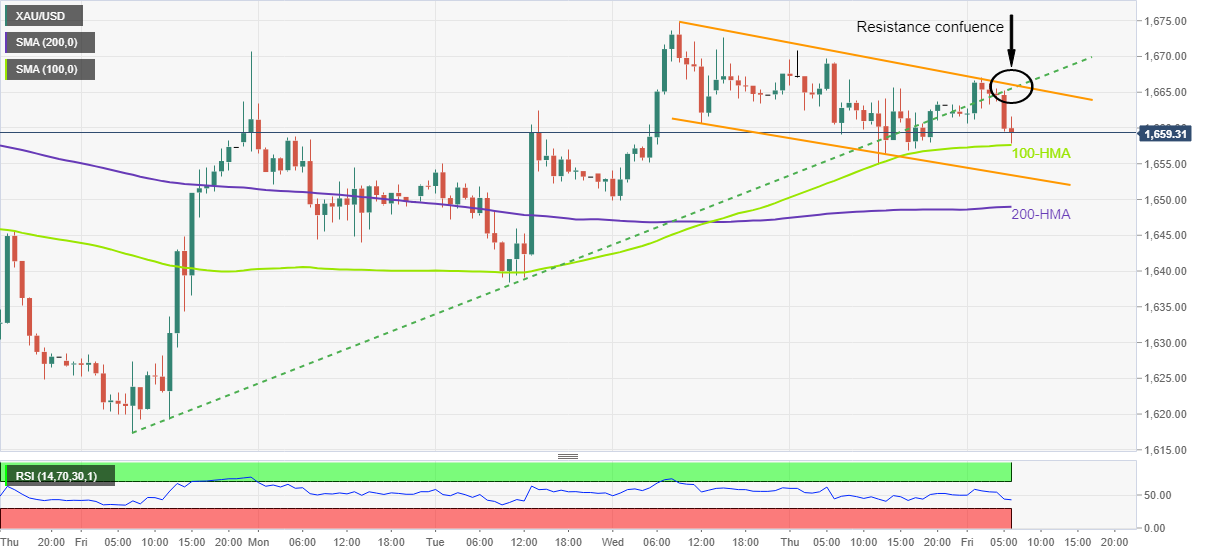
Trend: Limited downside expected
-
07:43
Core PCE Preview: Forecasts from six major banks, hovering around elevated levels
The Fed’s preferred inflation gauge, the Core Personal Consumption Expenditure (Core PCE), will be published on Friday, October 28 at 12:30 GMT and as we get closer to the release time, here are the forecasts of economists and researchers of six major banks.
The market expectation is for the monthly core PCE inflation to rise by 0.5% in September following August’s 0.6% increase. On a yearly basis, the PCE inflation and the core PCE inflation, which excludes volatile food and energy prices, are forecast to rise to 5.8% and 5.2%, respectively.
ING
“The core personal consumer expenditure deflator is expected to broadly match what happened to core CPI so we look for the annual rate to rise to 5.2% from 4.9%. With the economy growing and inflation heading in the wrong direction, the Fed cannot slow the pace of hikes just yet.”
NBF
“Still in September, the annual core PCE deflator may have moved up from 4.9% to a five-month high of 5.1%.”
BBH
“Consensus sees 5.2% YoY vs. 4.9% in August. If so, it would be the second straight month of acceleration to the highest since March. Shelter is likely to post another big rise, similar to what we saw in the September CPI data. Of note, shelter makes up around 16% of the PCE basket vs. nearly 33% of the CPI basket. In September, the shelter component in CPI rose 0.7% MoM and 6.6% YoY, with the YoY rate the highest since August 1982. We believe another big rise in core PCE this week would shatter the market’s recent complacency in a big way.”
Citibank
“Core PCE MoM – Citi: 0.4%, prior: 0.6%; Core PCE YoY – Citi: 5.1%, prior: 4.9%. Despite a strong 0.6% MoM increase in core CPI in September, we expect a more modest 0.4% increase in core PCE inflation based on elements of CPI and PPI. Strong shelter prices that helped offset weakness in goods prices in CPI will receive a smaller weight in PCE inflation.
TDS
“We expect core PCE inflation to have eased from a super-strong 0.6% MoM in Aug to a still-strong 0.4% MoM in Sep.”
Danske Bank
“We expect an unchanged high MoM 0.6% increase in the US PCE core index, which leaves core inflation at 5.3% in September, up from 4.9% in August.”
-
07:42
BOJ’s Kuroda: Rapid yen moves are negative, undesirable for Japan’s economy
Bank of Japan (BOJ) is speaking at the post-policy conference on Friday, reiterating that they “won't hesitate to ease monetary policy further if necessary.”
Additional quotes
Must be vigilant to financial, currency market moves and their impact on Japan's economy, prices.
Declines to comment on FX intervention as it’s under MOF’s jurisdiction.
Yen weakening has been one-sided.
Rapid yen moves are negative, undesirable for Japan’s economy as it makes companies’ business planning difficult.
Necessary to achieve 2% inflation target in tandem with wage growth.
No comment on fx intervention.
Very important for currencies to move stably reflecting fundamentals.
CPI growth due to rise in import prices driven by commodity inflation and weak yen.
Will strive to achieve stable, sustainable inflation involving wage growth.
Cost-push inflation will be weakening after new year.
Wages are rising gradually and expected to rise further next year.
But even considering that, CPI growth likely to be limited to around 1.6% next year and year after that.
Expect next spring's wage talks to bring higher wage growth on factors including rising price inflation.
Not in condition where 2% price growth can be achieved next FY.
Japan’s economy still on path towards recovery from pandemic.
Appropriate to continue monetary easing to support economic recovery.
Acknowledges forex market players are paying attention to interest rate differentials.
Won't be right to explain dollar strength only based on interest rate differential.
Market reaction
USD/JPY is defending bids above 146.00, unimpressed by Kuroda’s comments. The spot is trading at 146.38, up 0.05% on the day, as of writing.
-
07:38
FX option expiries for Oct 28 NY cut
FX option expiries for Oct 28 NY cut at 10:00 Eastern Time, via DTCC, can be found below.
- EUR/USD: EUR amounts
- 0.9800 918m
- 1.0000 1.86b
- 1.0200 912m
- GBP/USD: GBP amounts
- 1.1210 758m
- USD/JPY: USD amounts
- 147.00 630m
- 151.00 540m
- AUD/USD: AUD amounts
- 0.6720 438m
- USD/CNY: USD amounts
- 7.00 3.95b
- 7.20 1.23b
-
07:35
EUR/USD to decline towards the low-0.90s – Danske Bank
EUR/USD is trading only just below parity. Economists at Danske Bank expect the pair to head lower towards the low-0.90s.
Inflation risks are to the upside, growth risks are on the downside
“The ECB’s hike of 75 bps and its public acknowledgment of the stagflationary risks (risks to the downside for growth and to the upside for CPI), the market is likely to maintain a negative view about EUR/USD spot.”
“This stagflation theme and that higher European interest rates remain negative for the currency are well in line with our long-held USD-positive view and we have repeatedly seen such market reaction. Thus, we continue to forecast EUR/USD in the low 0.90’s.”
-
07:28
ECB’s Simkus: The next rate increase needs to be substantial
European Central Bank (ECB) policymaker Gediminas Simkus hints at a potential 75 bps rate hike at the next policy meeting.
Additional quotes
“We're moving closer towards the neutral-rate territory.”
“It is not the case that 75 basis points is the new norm.”
“Expect inflation forecasts to be revised up.”
“I expect ECB inflation projections to be raised in December.”
“QT discussion in December should be about the start date and amounts.”
Market reaction
EUR/USD remains unfazed by the above comments, trading around 0.9970, up 0.06% on the day.
-
07:18
USD/JPY: Further decline appears in the pipeline – UOB
USD/JPY could see its downside pressure gather some traction in the short term, comment UOB Group’s Markets Strategist Quek Ser Leang and Rates Strategist Victor Yong.
Key Quotes
24-hour view: “Yesterday, we held the view that ‘USD weakness is likely to extend but a sustained drop below 145.00 is unlikely’. While our view was not wrong as USD dropped to 145.10, we did not expect the strong rebound from the low (high has been 146.92). The rebound appears to be running ahead of itself and USD is unlikely to advance much further. For today, USD is more likely to trade sideways within a range of 145.55/147.05.”
Next 1-3 weeks: “We highlighted yesterday (27 Oct, spot at 146.05) that downward momentum is building tentatively and that USD could edge lower but the odds of a sustained decline below 144.00 are not high. There is no change in our view. On the upside, a break of the ‘strong resistance’ at 148.80 (no change in level from yesterday) would indicate the build-up in momentum has fizzled out.”
-
07:09
EUR/USD Price Analysis: Pullback remains elusive beyond golden ratio around 0.9950
- EUR/USD retreats towards intraday low during two-week uptrend, mildly bid after falling the most in three weeks.
- Clear downside break of weekly bullish channel directs bears towards 200-SMA.
- Fresh upside needs validation from 1.0040 before aiming for September’s top.
EUR/USD pares the consecutive second weekly gain as it slides to 0.9970 heading into Friday’s European session.
In doing so, the major currency pair justifies the previous day’s downside break of a one-week-old bullish channel to direct bears toward the 61.8% Fibonacci retracement level of the quote’s fall in September.
It’s worth noting that the bearish MACD and mostly steady RSI (14) keep the sellers hopeful of breaking the immediate Fibonacci retracement level, also known as the golden ratio near 0.9950, which in turn could direct prices towards the 50% Fibonacci retracement level of 0.9870. However, the 200-SMA level surrounding 0.9830 could challenge the EUR/USD bears afterward.
In a case where the quote remains weak past 0.9830, a one-month-old ascending trend line precedes the five-week-long horizontal region to challenge the pair’s further downside around 0.9720 and 0.9670 in that order.
Meanwhile, recovery moves need to cross the previous support line of the aforementioned channel, around 1.0050 at the latest.
Even so, the monthly high near 1.0095 and the 1.0100 threshold could test the EUR/USD bulls before directing them to the previous monthly peak of 1.0198.
EUR/USD: Four-hour chart
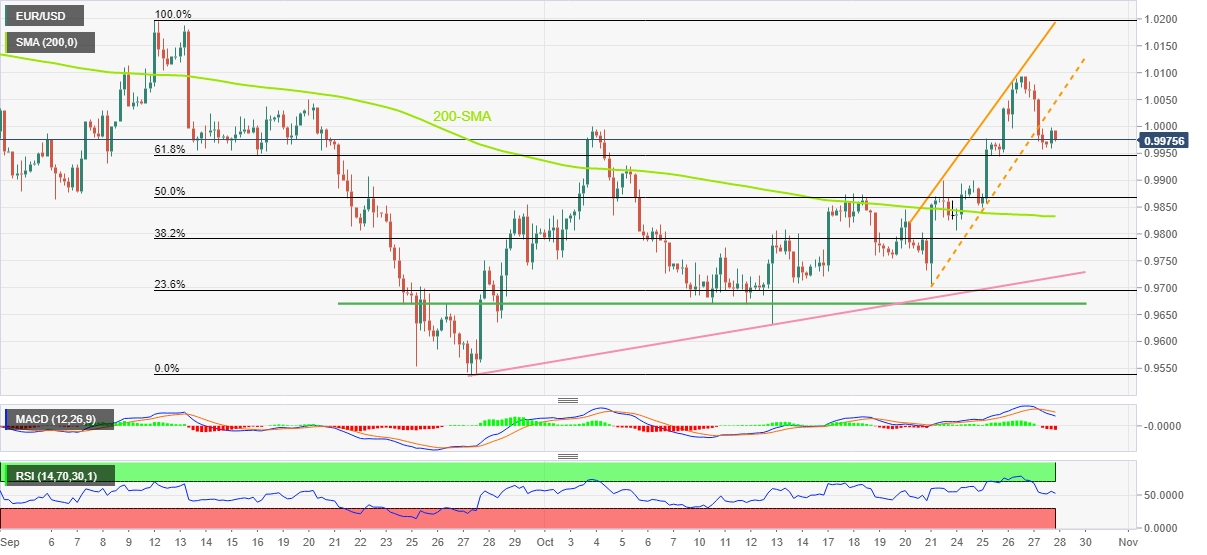
Trend: Limited downside expected
-
07:09
Natural Gas Futures: Extra gains look likely near term
Considering advanced prints from CME Group for natural gas futures markets, open interest rose for the third session in a row on Thursday, this time by just 54 contracts. On the other hand, volume went down for the second consecutive day, now by nearly 25K contracts.
Natural Gas remains capped by the 200-day SMA
Thursday’s strong advance in prices of natural gas was on the back of a small uptick in open interest, which suggests that further upside could be in store for the commodity in the very near term. Against that, the 200-day SMA around $6.73 per MMBtu continues to cap the upside for the time being.
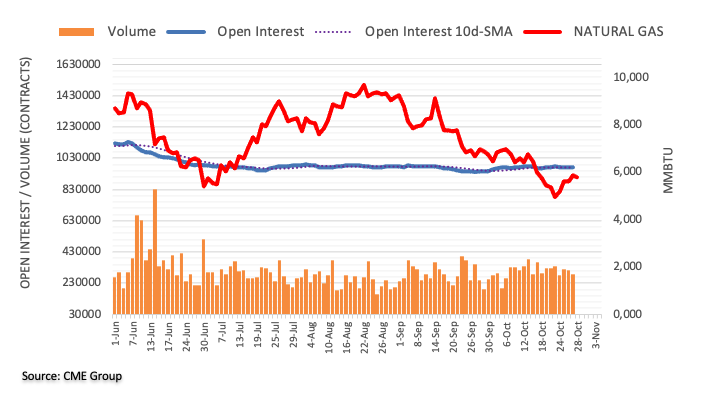
-
07:04
NZD/USD faces barricades around 0.5870 as DXY recovers, Fed policy eyed
- NZD/USD has sensed selling pressure at around 0.5870 as the DXY has rebounded.
- Risk sentiment is turning averse as S&P500 futures have extended their morning losses.
- A slowdown in consumer spending has trimmed hawkish Fed bets.
The NZD/USD pair has witnessed a corrective move after facing hurdles around the critical resistance of 0.5870 in the early European session. The asset has failed to cross Thursday’s high decisively as the US dollar index (DXY) has rebounded after sensing buying interest around 110.30.
Meanwhile, risk sentiment is turning averse as S&P500 futures have extended their morning losses. Bleak growth projections presented by US tech companies are weighing pressure on the US 500-stock basket. The 10-year US Treasury yields have resurfaced firmly despite declining bets for a hawkish Federal Reserve (Fed). At the press time, the 10-year yields are trading at 3.95%, 0.29% higher than their prior release.
The CME FedWatch tool is displaying the odds of 75 basis points (bps) rate hike at 84.8%. A slowdown in consumer spending has triggered chances of exhaustion in inflationary pressures. For the third quarter, consumer spending expanded by 1.4% vs. a prior expansion of 2.0%. A decline in household demand may restrict further price growth for goods and services.
Going forward, investors will go busy with the monetary policy event by the Federal Reserve (Fed), which is scheduled for Wednesday.
On the NZ front, a significant decline in China’s GDP projections could weigh on kiwi bulls as New Zealand is a leading trading partner of China. Global institution International Monetary Fund (IMF) has slashed Gross Domestic Product (GDP) forecast for China, citing Covid-19 lockdowns and the real estate crisis as responsible for a decline in economic activities.
The latest review from IMF dictates that "Risks to the banking system from the real estate sector are rising because of substantial exposure." Projections for GDP have been trimmed to 3.2% vs. prior estimations of 4.4%.
-
07:01
Sweden Retail Sales (YoY) below expectations (-5.4%) in September: Actual (-5.9%)
-
07:01
Sweden Retail Sales (MoM) registered at -0.4%, below expectations (0.5%) in September
-
07:00
Norway Retail Sales came in at 0.1%, below expectations (0.7%) in September
-
07:00
Denmark Industrial Outlook declined to -16 in October from previous -9
-
06:58
Gold Price Forecast: XAU/USD remains under pressure as 21DMA continues to cap
Nothing seems to have changed technically for gold price, as it continues to extend its struggle below the 21-Daily Moving Average (DMA) at $1,669. Will the yellow metal close above the latter? FXStreet’s Dhwani Mehta analyzes XAU/USD’s technical picture.
21DMA appears a tough nut to crack for XAU/USD bulls
“The 14-day Relative Strength Index (RSI) remains flatlined below the 50.00 level, suggesting that bears will likely retain control.”
“Bulls need a weekly close above the 21DMA to revive the recovery momentum from monthly troughs. Monday’s high at $1,671 will then come into play. The next relevant barriers are seen at the October 13 high of $1,683 and the $1,700 mark.”
“Rejection at 21DMA once again will reopen the downside towards Wednesday’s low at $1,650, below which the weekly low at $1,638 will be retested. The last line of defense for buyers is envisioned at the monthly low of $1,617.”
-
06:44
Asian Stock Market: Bears keep the reins amid inflation, growth woes
- Asia-Pacific shares remain pressured amid firmer inflation data, downbeat growth forecasts and central bank inaction.
- Japan, Australia print strong inflation numbers, IMF cuts Asia growth outlook.
- BOJ defends status quo despite upwardly revising inflation forecasts.
Asian shares hold lower ground while tracking global cues as fears surrounding inflation and growth prevail during early Friday.
While portraying the mood, the MSCI’s index of Asia-Pacific shares outside Japan drops nearly 1.0% as bears attack the lowest levels since March 2020 whereas Japan’s Nikkei 225 loses 0.73% intraday heading into the European session. It’s worth noting, however, that the downbeat yields have earlier favored the equity buyers but the hawkish ECB and strong US Gross Domestic Product (GDP) drowned the stocks afterward.
A 33-year high Tokyo inflation data joined strong Australia Producer Price Index (PPI) to keep bears hopeful as the International Monetary Fund (IMF) cut Asia's economic forecasts. “The IMF cut Asia's economic forecasts on Friday as global monetary tightening, rising inflation blamed on the war in Ukraine, and China's sharp slowdown dampened the region's recovery prospects,” said Reuters. The news also adds that the IMF cut Asia's growth forecast to 4.0% this year and 4.3% next year, down 0.9% point and 0.8 points from April, respectively. The slowdown follows a 6.5% expansion in 2021. Further details suggest that the Washington-based institute expects China's growth to slow to 3.2% this year, a 1.2-point downgrade from its April projection, after an 8.1% rise in 2021. The world's second-largest economy is seen growing 4.4% next year and 4.5% in 2024, the IMF said as per Reuters.
On a broader front, Thursday’s US data weighed on the Fed wagers even as the headline US Gross Domestic Product (GDP) rose 2.6% on an annualized basis, more than expected, in the third quarter (Q3). The reason could be linked to a fifth consecutive fall in private consumption that challenged the Fed hawks as it showed the policymakers are gradually nearing the target of slowing down private domestic demand, which in turn might favor the easy rate hike talks for December in the next week’s Federal Open Market Committee (FOMC) meeting.
That said, the sluggish US Treasury yields and the risk-off mood could also be held responsible for the Asia-Pacific market’s sour conditions. That said, the US Dollar Index (DXY) retreats to 110.50, following Thursday’s recovery from the five-week-low, whereas commodities are slightly red amid the market’s indecision.
Moving on, the US Core PCE Price Index for September, expected to rise to 5.2% versus 4.9% prior, will be crucial for traders to watch for clear directions. A firmer print of the Fed’s preferred inflation gauge could add strength to the yields and hawkish Fed bets, which in turn will be favorable for the risk-safe assets ahead of the next week’s FOMC.
-
06:36
AUD/USD faces some consolidation ahead of potential gains – UOB
AUD/USD could enter a consolidative phase ahead of a probable climb to the 0.6550 region, note UOB Group’s Markets Strategist Quek Ser Leang and Rates Strategist Victor Yong.
Key Quotes
24-hour view: “We highlighted yesterday that ‘the rapid rise appears to be overdone and AUD is unlikely to advance much further’ and we expected AUD to ‘trade in a range between 0.6440 and 0.6520’. Our view was not wrong even though AUD traded within a wider range than expected (0.6428/0.6522). Further range trading appears likely today, expected to be between 0.6405 and 0.6505.”
Next 1-3 weeks: “There is not much to add to our update from yesterday (27 Oct, spot at 0.6480). As highlighted, overbought short-term conditions could lead to 1 to 2 days of consolidation first. As long as the ‘strong support’ at 0.6470, (no change in level from yesterday) is not breached, AUD is likely to strengthen further to 0.6555 later on.”
-
06:33
Crude Oil Futures: Rising odds for further consolidation
CME Group’s flash data for crude oil futures markets noted traders extended the uptrend in open interest for the 4th session in a row on Thursday, this time by around 12.4K contracts. Volume followed suit and rose for the thirds straight session, now by around 63.1K contracts.
WTI remains focused on $90.00 and above
Prices of the WTI extended the weekly recovery on Thursday. The small uptick was in tandem with increasing open interest and volume and opens the door to some consolidation in the very near term and with the immediate target at the $90.00 mark per barrel and beyond.
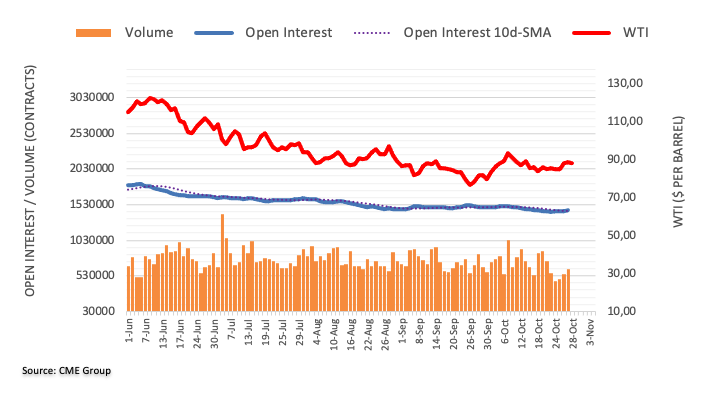
-
06:30
France Consumer Spending (MoM) above expectations (1.1%) in September: Actual (1.2%)
-
06:27
GBP/JPY eyes more weakness below 169.00 despite a dovish BOJ policy
- GBP/JPY is expected to deliver a steep fall below 169.00 despite an ultra-loose BOJ policy.
- The BOJ will continue policy easing to achieve pre-pandemic growth rates.
- Next week, the BOE could announce a rate hike by 75 bps to combat mounting price pressures.
The GBP/JPY pair has surrendered its entire intraday gains after facing barricades around 169.80 in the early European session. The cross has witnessed selling pressure from the market participants despite a continuation of the dovish stance by the Bank of Japan (BOJ) on interest rates.
BOJ Governor Haruhiko Kuroda kept the policy rates unchanged citing weaker growth prospects and external demand shocks responsible. The central bank will continue easing policy further in order to match the current growth rate with pre-pandemic growth levels.
The continuation of ultra-dovish monetary policy could terminate the recent pullback in Japanese yen as policy divergence will continue to heat up further as other G-7 central banks are bound to hike their rate cycle amid a historic surge in inflationary pressures.
Going forward, Japanese officials could announce a stimulus package. Japan’s Finance Minister Shunichi Suzuki said on Thursday that “tomorrow, a stimulus package will be decided.” Japan’s national broadcaster, NHK, reported that a stimulus package of more than JPY 29 trillion is in consideration.
On the UK front, pound investors are preparing ahead of the interest rate decision by the Bank of England (BOE). To bring price stability to the UK economy, BOE policymakers will steer their rate hike mechanism. November’s monetary policy carries more importance as it will be first after the appointment of Rishi Sunak as UK Prime Minister.
18 of 30 economists surveyed by Reuters said that they expect the BOE Governor Andrew Bailey to hike its policy rate by 75 basis points (bps) at a policy meeting on November 3. The BOE is projected to reach the terminal policy rate of 4.25% in the first quarter of 2023. Currently, the BOE’s interest rate stands at 2.25%.
-
06:22
GBP/USD remains firm and could test 1.1760 – UOB
In the opinion of UOB Group’s Markets Strategist Quek Ser Leang and Rates Strategist Victor Yong, further upside in GBP/USD could challenge the 1.1760 region in the next few weeks.
Key Quotes
24-hour view: “Our expectation for GBP to ‘rise further’ yesterday did not materialize as it traded between 1.1550 and 1.1645. The price movement is likely part of a consolidation and we expect GBP to trade within a range of 1.1485/1.1625.”
Next 1-3 weeks: “Yesterday (27 Oct, spot at 1.1630), we held the view that GBP is still strong and is likely to strengthen further. We indicated that the next level to monitor is at 1.1760. There is no change in our view for now but overbought short-term conditions could lead to a couple of days of consolidation first. Overall, only a break of 1.1440 (no change in ‘strong support’ level from yesterday) would indicate that the GBP strength that started earlier this week has ended.”
-
06:18
Gold Futures: Further range bound on the cards
Open interest in gold futures markets rose for the 4th consecutive session on Thursday, this time by nearly 4K contracts according to preliminary readings from CME Group. Volume, instead, shrank by around 4.1K contracts after two daily builds in a row.
Gold poised for extra consolidation
Gold charted an inconclusive session on Thursday on the back of rising open interest, which is supportive of the continuation of the consolidative mood around current levels. So far, the $1,615/20 band should offer decent contention in case of occasional bouts of weakness in the precious metal.

-
06:10
USD/JPY Price Analysis: Dribbles on the way to 143.85-70 support region
- USD/JPY remains volatile but bears keep the reins.
- BOJ failed to impress traders but Kuroda could favor sellers.
- Sustained trading below 21-DMA, two-month-old resistance line favor bears amid downbeat oscillators.
- Convergence of 50-DMA, 38.2% Fibonacci retracement restricts short-term downside.
USD/JPY revisits the day-start levels while bouncing off the intraday low to 146.25 heading into Friday’s European session. It’s worth noting that the yen pair portrays a 100-pip move on the Bank of Japan’s (BOJ) inaction but sustained trading below the short-term key supports, now resistances, keep sellers hopeful ahead of BOJ Governor Kuroda’s speech.
Also read: USD/JPY whipsaws above 146.00 on BOJ’s status quo, focus on Kuroda’s speech, US PCE Inflation
That said, the 21-DMA and 23.6% Fibonacci retracement level of August-October upside, near 146.90, guards the immediate upside of the pair. Following that, an upward-sloping support-turned-resistance line from early August, around 147.35, will be crucial for the pair buyers to watch for further upside.
In a case where the USD/JPY prices remain firmer past 147.35, the 149.20 and the 150.00 round figure may entertain the bulls before directing them to the recently flashed multi-year high near 152.00.
Alternatively, 50-DMA and 38.2% Fibonacci retracement together highlights 143.85-70 zone as the short-term key support.
Following that, the 50% and 61.8% Fibonacci retracement level surrounding 141.20 and 138.60, will be in focus.
It should be observed that the 140.00 threshold may act as an extra downside filter for the USD/JPY traders to track during the pair’s fall past 141.20.
USD/JPY: Daily chart

Trend: Further downside expected
-
06:07
EUR/USD: Diminishing bets for further strength – UOB
UOB Group’s Markets Strategist Quek Ser Leang and Rates Strategist Victor Yong suggest the prospects for extra upside in EUR/USD seems to be losing momentum.
Key Quotes
24-hour view: “Our view for the ‘rally in EUR to continue’ was incorrect as it pulled back sharply from high of 1.0093. The price movement is likely part of a consolidation phase and we expect EUR to trade between 0.9925 and 1.0050 today.”
Next 1-3 weeks: “After the strong surge in EUR, we indicated yesterday (27 Oct, spot at 0.9960) that EUR is likely to rise further and the next level to monitor is at 1.0200. We did not expect the sharp pullback to 0.9956. The pullback has resulted in a quick loss of momentum and the chance of further EUR strength has diminished. However, only a break of 0.9880 (‘strong support’ level adjusted lower from 0.9950) would indicate that the EUR strength that started earlier this week has come to an end.”
-
05:55
AUD/USD extends recovery above 0.6470, DXY turns subdued ahead of Fed policy
- AUD/USD is aiming to sustain its recovery amid a decline in hawkish Fed bets.
- The DXY is struggling to sustain above 110.40 as the risk impulse remains mute.
- The RBA could remain in dilemma whether to return to the 50 bps rate hike pattern or go for frequent small hikes.
The AUD/USD pair has extended its recovery above the intraday hurdle of 0.6470 amid mixed cues from market sentiment. S&P500 futures are holding on to their morning losses amid the absence of a positive trigger while 10-year US Treasury yields have resurfaced after dropping to near 3.93%.
The US dollar index (DXY) is struggling around 110.40 in the early European session after a sheer reversal on Thursday. Robust Gross Domestic Product (GDP) numbers in July to September period brought a relief rally for the DXY.
The US GDP for the third quarter landed at 2.6% and remained upbeat from the projections of 2.4%. Also, a shift into expansion mode after displaying economic contraction in the first half of CY2022 led to a return of investors’ confidence in the economic prospects.
Going forward, investors will focus on the interest rate policy of the Federal Reserve (Fed), which is scheduled for next week. As per the CME FedWatch tool, the chances of 75 basis points (bps) rate hike by the Federal Reserve (Fed) stand at 82.85%.
The odds for a 75 bps rate hike have been trimmed after a slowdown in consumer spending in the third quarter. This indicates that exhaustion in the inflationary pressures is not so far and the market participants will witness a decline in price pressures in the coming months.
On the Aussie front, a historic surge in the inflation rate, released this week, at 7.3%, could weigh on the Reserve Bank of AustraIia (RBA)’s decision-making regarding the extent of the hike in the Official Cash Rate (OCR). RBA Governor Philip Lowe could remain in dilemma whether to return to the 50 bps rate hike pattern or go for frequent small hikes.
-
05:49
USD/CAD Price Analysis: Stays pressured towards three-week-old support near 1.3500
- USD/CAD takes offers to reverse the previous day’s bounce off monthly low.
- RSI, MACD suggests further downside past immediate horizontal support.
- 50-DMA, two-month-old ascending trend line lures bears, fortnight-long resistance line, 21-DMA test buyers.
USD/CAD appears all-set to print a two-week downtrend as sellers approach a short-term key horizontal support during early Friday morning in Europe. In doing so, the Loonie pair slides to 1.3530 as it fades Thursday’s recovery from the lowest levels in a month.
Not only the inability to rebound from the three-week-old region surrounding 1.3500, but the bearish MACD signals and the RSI (14) also keep the sellers hopeful of breaking the nearby support zone.
Following that, a downward trajectory towards the 50-DMA level near 1.3430 and then to the upward-sloping support line from early August, at 1.3280 by the press time, will lure the USD/CAD bears.
In a case where the pair sellers dominate past 1.3280, the early September top near 1.3210 will precede the 1.3200 round figure to restrict the quote’s further downside.
On the flip side, recovery remains elusive below a two-week-old descending resistance line, close to 1.3660 by the press time.
It’s worth noting that the USD/CAD upside past 1.3660 will be challenged by the 21-DMA hurdle of 1.3700, a break of which could convince bulls to attack multiple resistance levels near 1.3840 and the monthly high near 1.3980.
USD/CAD: Daily chart
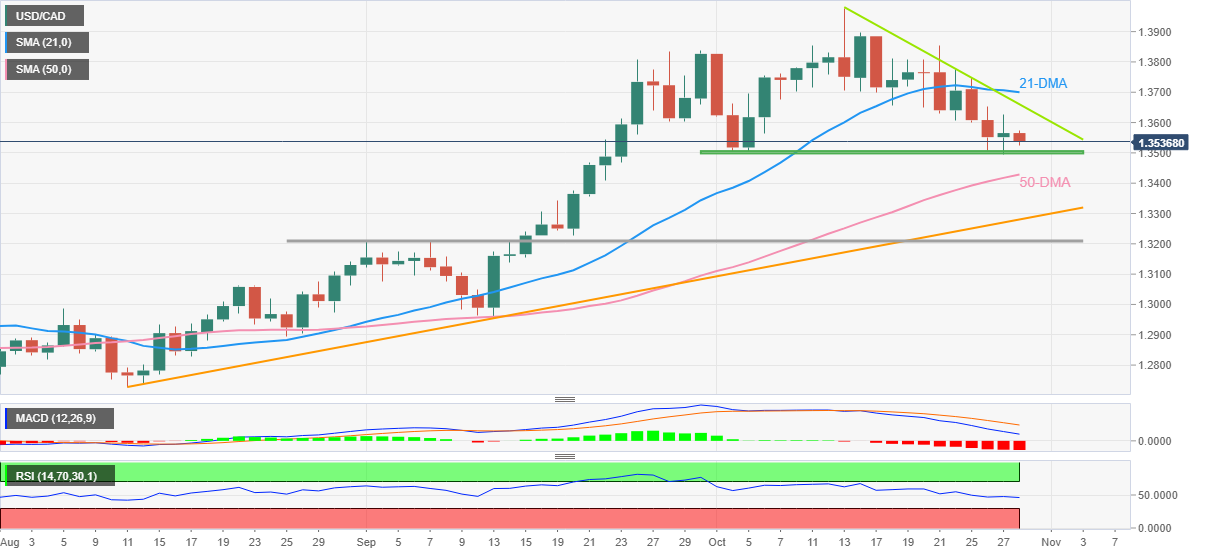
Trend: Further downside expected
-
05:41
Singapore Unemployment rate declined to 2% in 3Q from previous 2.1%
-
05:20
USD/INR Price Analysis: Positive Divergence bolsters a bullish reversal, 83.00 eyed
- The greenback bulls are facing barricades at the downward sloping trendline placed from 83.30.
- A Positive Divergence signals a resumption in the dominant trend after a corrective move.
- The DXY is struggling to sustain above 110.50 amid mixed market sentiment.
The USD/INR pair is struggling to cross the immediate hurdle of 82.40 in the Tokyo session. However, the US dollar index (DXY) has witnessed a minor correction after failing to sustain above the critical resistance of 110.50. Meanwhile, risk sentiment remains quiet as S&P500 futures are holding their morning losses.
USD/INR daily chart

On a daily scale, the major has displayed a Positive Divergence, which indicates a resumption of an uptrend after a corrective move. A bullish positive divergence was recorded after the asset made a higher low at around 81.90 while the momentum oscillator Relative Strength Index (RSI) (14) made a lower low. This dictates an oversold situation in an uptrend which is considered a bargain buy for the market participants.
The 10- and 20-period Exponential Moving Averages (EMAs) at 82.47 and 82.25 respectively are aiming higher, which adds to the upside filters.
USD/INR hourly chart
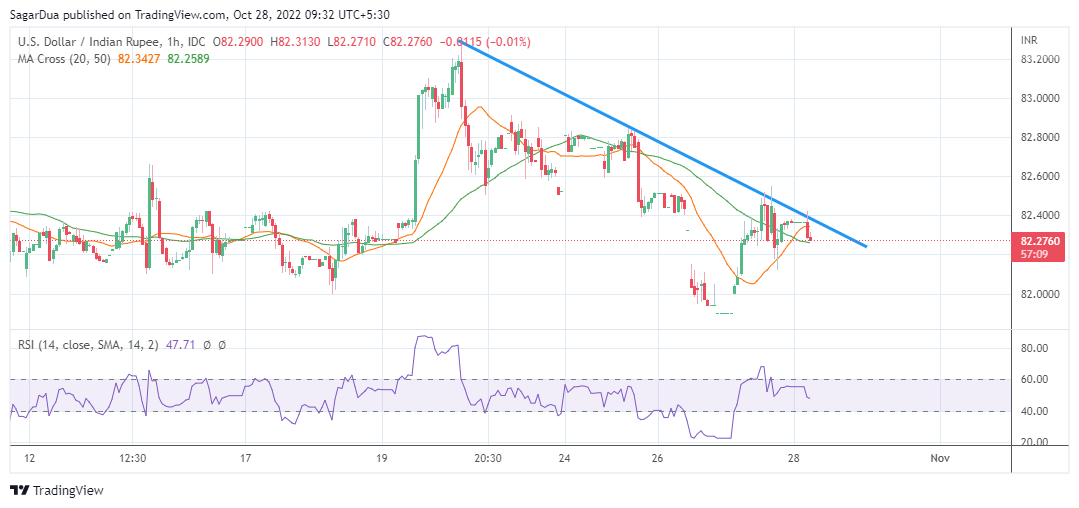
On an hourly scale, the major is facing barricades around the downward-sloping trendline placed from October 20 high at 83.30.
The 20-and-50-period EMAs have delivered a bull cross at 82.34, which indicates more upside ahead.
A decisive move above Thursday’s high at 82.55 will trigger the Positive Divergence and eventually will activate the greenback bulls for an upside move towards October 10 high and all-time high at 82.82 and 83.30 respectively.
Alternatively, the Positive Divergence formation could negate if the asset drops below Thursday’s low at 81.90. This will drag the asset towards October 6 low at 81.51, followed by September 30 low at 81.16.
USD/INR
-
04:48
Gold Price Forecast: XAU/USD battle lines well-defined, with the Fed week ahead – Confluence Detector
- Gold price is wavering in a tight range amid USD weakness, awaits US data, Fed.
- Hopes for a dovish Fed pivot remain intact after the ECB fails to impress.
- XAU/USD looks to extend the range trade above the $1,650 level.
Gold price is keeping its range play intact between the $1,650 and $1,680 price zone heading into the weekly close, as investors continue assessing the recent series of downbeat US economic releases even though the advance Q3 GDP print bettered estimates on Thursday. Expectations of the Fed likely shifting its pivot towards a dovish stance in the months ahead continue weighing on the US dollar and the Treasury yields, especially after the ECB offered a gloomy outlook of the euro area economy. The downside in the yellow metal, therefore, remains cushioned. But bulls stay cautious over the end-of-the-week volatility while the month-end also nears. Positions readjustments ahead of the November 2 Fed rate hike decision could also have a significant impact on the dollar trades and, hence, on the gold price action.
Also read: Gold Price Forecast: 21DMA appears a tough nut to crack for XAU/USD bulls, focus on weekly close
Gold Price: Key levels to watch
The Technical Confluence Detector shows that the gold price is gyrating below the critical resistance at $1,669, which is the convergence of the previous week’s high and Bollinger Band one-day Middle.
Up next, bulls will challenge $1,671, where the previous day’s high coincides with the pivot point one-day R1. A firm break above the latter will trigger a fresh upswing towards $1,677, the confluence of the previous year’s low, pivot point one-week R1 and pivot point one-day R2.
The next point of resistance is placed at the Fibonacci 161.8% one-day at $1,681.
Alternatively, XAU/USD bears are flirting with the SMA100 four-hour support at $1,663, a breach of the latter will expose a powerful cap at $1,661, which is the intersection of the Fibonacci 38.2% one-day and one-month.
The SMA5 one-day at $1,657 could then come to the rescue of buyers, putting the previous day’s low at $1,655 to test again. A fresh drop below that level will call for a test of strong cushion at $1,650. At that level, the Fibonacci 38.2% one-week, SMA200 one-hour and SMA10 one-day merge.
Here is how it looks on the tool

About Technical Confluences Detector
The TCD (Technical Confluences Detector) is a tool to locate and point out those price levels where there is a congestion of indicators, moving averages, Fibonacci levels, Pivot Points, etc. If you are a short-term trader, you will find entry points for counter-trend strategies and hunt a few points at a time. If you are a medium-to-long-term trader, this tool will allow you to know in advance the price levels where a medium-to-long-term trend may stop and rest, where to unwind positions, or where to increase your position size.
-
04:42
EUR/USD braces for second weekly gain around parity ahead of US/German inflation data
- EUR/USD prints mild gains while paring the biggest intraday loss in three weeks.
- Market sentiment remains dicey as Fed hawks retreat after mixed US data, ECB disappoints.
- Softer yields weigh on DXY but buyers remain cautious ahead of US Core PCE Inflation, German Q3 GDP and HICP data.
EUR/USD pares intraday gains around 0.9980, retreating from daily top, as traders await the key inflation data from Germany and the US on Friday. Even so, the major currency pair remains on the way to posting the second consecutive weekly upside while printing mild gains at the latest.
The European Central Bank’s (ECB) disappointment favored the EUR/USD bears the previous day even as the yields eased afterward. That said, the region’s central bank matched wide market forecasts of the announced 75 basis points (bps) rate hike but President Christine Lagarde pushed back the hawkish expectations.
“President Lagarde said inflation will rise further in coming months and that the ECB is data dependent. She then contradicted that guidance by saying the three factors to take into consideration are: the outlook for inflation and growth, the extent to which rates have already risen, and a consideration of the lagged effects of tightening. That list is not so ‘data dependent’. We think the ECB may dial down to 50bp hikes from December,” said the Australia and New Zealand Banking Group (ANZ).
On the other hand, the US Dollar Index (DXY) retreats to 110.50, following Thursday’s recovery from the five-week-low, as Fed hawks get mixed details of the overall strong US data. The US Gross Domestic Product (GDP) rose 2.6% on an annualized basis, more than expected, in the third quarter (Q3). Even so, a fifth consecutive fall in private consumption challenged the Fed hawks as it showed the policymakers are gradually nearing the target of slowing down private domestic demand, which in turn might favor the easy rate hike talks for December in the next week’s Federal Open Market Committee (FOMC) meeting.
It should be noted that the recently grim headlines from the International Monetary Fund (IMF) and geopolitical concerns surrounding Russia challenge the market’s optimists even as the DXY remains downbeat. While portraying the mood, the S&P 500 Futures drop half a percent near 3,800 by the press time.
Moving on, the first readings of Germany’s Q3 GDP and preliminary figures of Harmonized Index of Consumer Prices (HICP) for October, expected -0.2% QoQ and 10.9% YoY respectively versus 0.1% and 10.9% prior, could entertain EUR/USD traders. Following that, the Fed’s preferred inflation gauge, namely the US Core PCE Price Index for September, expected to rise to 5.2% versus 4.9% prior, will be crucial for the USD/CNH pair traders to watch for clear directions.
Given the easing hawkish Fed bets, firmer data from Germany could please EUR/USD buyers ahead of the next week’s Federal Open Market Committee (FOMC) meeting.
Technical analysis
Although the 100-DMA challenges EUR/USD buyers around 1.0085, the downside remains elusive unless the quote stays beyond the previous resistance line from early February 2022, close to 0.9920 by the press time.
-
04:40
GBP/USD marches towards 1.1600 amid a decline in hawkish Fed bets
- GBP/USD is aiming to recapture 1.1600 as DXY struggles amid declining odds for the ultra-hawkish Fed.
- A slowdown in consumer spending has indicated that the inflationary pressures are exhausting.
- UK’s novel leadership is focusing on squeezing liquidity through fiscal policy.
The GBP/USD pair has witnessed a rebound from 1.1550 in the Tokyo session and is aiming to recapture the immediate hurdle of 1.1600. The cable has picked bids as the US dollar index (DXY) has witnessed come correction after failing to sustain above 110.50.
Meanwhile, the 10-year US Treasury yields is stabilizing around 3.93% after a firmer decline. The risk impulse is displaying mixed response as S&P500 futures have carry-forwarded their bearish Thursday sentiment.
The DXY is displaying a subdued performance in Asia as the odds of a bigger rate hike announcement by the Federal Reserve (Fed) have trimmed significantly. As per the CME FedWatch tool, the chances of 75 basis points (bps) rate hike by the Federal Reserve (Fed) have dropped further to 85.5%.
The reason behind a shift in the paradigm of a less-hawkish policy stance is the decline in consumer spending in the third quarter. The third quarter Gross Domestic Product (GDP) report claims that consumer spending has expanded by 1.4%, lower than the prior expansion of 2.0%. A slowdown in consumer spending indicates that inflation will soon peak around led by a fall in consumer demand. It is worth noting that consumer spending accounts for 70% of total economic activity.
On the UK front, novel UK Leadership with PM Rishi Sunak and Chancellor Jeremy Hunt are working on reducing the piled debt of the UK, the highest since 1960, to bring financial stability. Reports from Financial Times claim that Sunak is exploring tax rises and spending cuts of up to GBP 50 billion, which is in line with the agenda of the bank of England (BOE) of bringing price stability.
-
04:14
EUR/JPY Price Analysis: Bulls keep the reins past 146.00 despite BOJ’s inaction
- EUR/JPY pares the biggest daily loss in five weeks, whipsaws after BOJ’s verdict.
- BOJ left benchmark rate, YCC policy unchanged while matching market forecasts.
- Sustained trading beyond 100-SMA, monthly support line keeps buyers hopeful.
- Weekly resistance line holds the key to fresh multi-month high.
EUR/JPY remains mildly bid above 146.00, despite the Bank of Japan (BOJ) induced volatility while bracing for the fifth consecutive weekly run-up during Friday.
The BOJ matched wide market forecasts by keeping its benchmark rate at -0.1% and the Yield Curve Control (YCC) practice to defending the 10-year Japanese Government Bond yields (JGBs) near 0.0%. It should, however, be noted that the Japanese central bank also cited expectations of economic recovery despite mentioning the broad fears, which could have challenged the EUR/JPY buyers.
Also read: BOJ Quarterly Outlook Report: Developments in FX rates, international commodity prices seen as risk to prices
Even so, the EUR/JPY prices remain well above the one-month-old support line and the 100-SMA support amid a recent recovery in the RSI (14) and the receding bearish bias of the MACD.
As a result, the pair buyers are all set to challenge the weekly resistance line, around 147.50, before aiming for the fresh high since December 2014, currently around 148.40. In doing so, the year 2014 peak near 149.80 and the 150.00 psychological magnet will be in focus.
Alternatively, the aforementioned support line and the 100-SMA, close to 145.00 and 144.80 in that order, will precede the early month’s peak around 144.10 and the 144.00 threshold to challenge the bears.
EUR/JPY: Four-hour chart
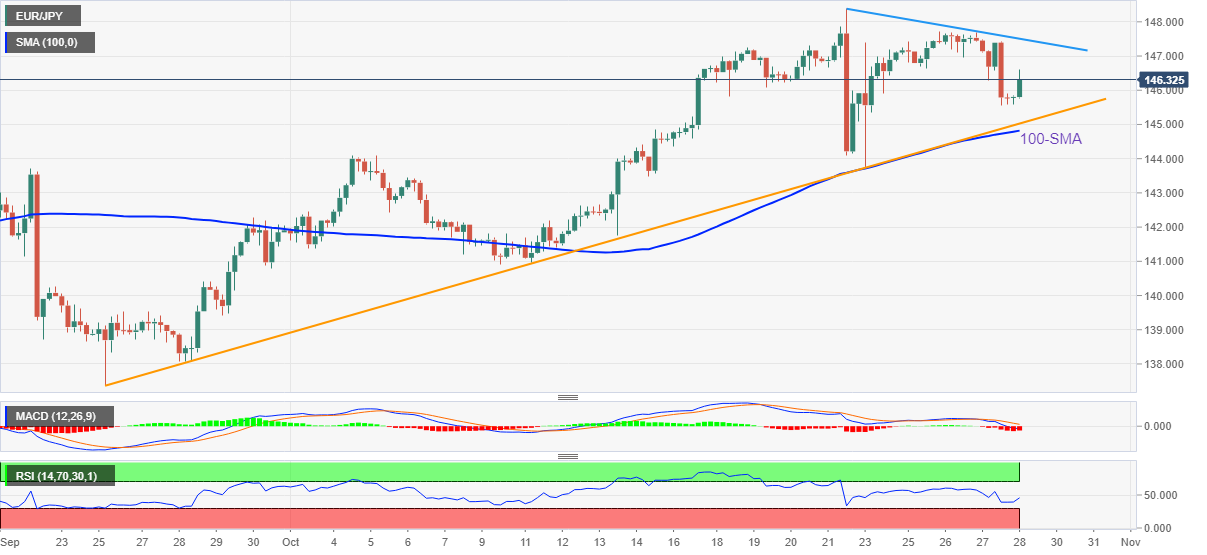
Trend: Further upside expected
-
04:05
AUD/JPY drops to 94.40 as BOJ continues with ultra-loose monetary policy
- AUD/JPY has eased its morning gains and has dropped to 94.40 on BOJ’s unchanged monetary policy.
- BOJ’s Kuroda has continued its ultra-dovish policy stance due to weak inflation and growth prospects.
- The RBA may continue its 25 bps rate hike extent despite a historic surge in inflation.
The AUD/JPY pair has surrendered the majority of its morning gains and has slipped to 94.40 as the Bank of Japan (BOJ) has carry-forwarded its ultra-dovish policy stance. The BOJ has kept interest rates unchanged led by the lower inflation rate and external demand shocks.
Maintenance of status-quo was already expected by BOJ Governor Haruhiko Kuroda as the overall demand has not picked up in the Japanese economy. The nation has been failing in returning to pre-pandemic growth levels, which is compelling the central bank to release helicopter money.
On Thursday, Japanese officials announced that they are planning to release more stimulus to the economy to spurt the overall demand. Japan’s Finance Minister Shunichi Suzuki said that “tomorrow, a stimulus package will be decided.” Japan’s national broadcaster, NHK, reported that a stimulus package of more than JPY 29 trillion is in consideration.
Meanwhile, the global institution International Monetary Fund (IMF) has slashed Gross Domestic Product (GDP) forecast for the world’s second-largest economy, China, citing Covid-19 lockdowns and the real estate crisis as responsible for a decline in economic activities. The latest review from IMF dictates that "Risks to the banking system from the real estate sector are rising because of substantial exposure."
A significant decline in China’s GDP projections could weigh on aussie bulls as Australia is a leading trading partner of China. But majorly, aussie investors will focus on the interest rate decision by the Reserve Bank of Australia (RBA), which is due next week. Escalated inflationary pressures released this week could compel RBA Governor Philip Lowe to return to 50 basis points (bps) rate hike structure.
Economists at ANZ Bank cited that “A 50 bps rise in November is possible, but we think the RBA will prefer to hike more frequently than shift back to 50 bps, given the reasoning behind the decision to go 25 bps in October.”
-
04:00
USD/JPY whipsaws above 146.00 on BOJ’s status quo, focus on Kuroda’s speech, US PCE Inflation
- USD/JPY fades the bounce off a three-week low as BOJ defends easy money policy.
- BOJ keeps monetary policy unchanged, as expected, stays cautiously optimistic on economic outlook
- Easing hawkish Fed bets, downbeat yields also keep pair sellers hopeful ahead of Fed’s preferred inflation data.
- Kuroda’s presser, Japan’s supplementary budget will also be crucial for intraday directions.
USD/JPY marked a volatile move above 146.00 by initially refreshing the daily top before renewing the bottom, staying pressured around 146.35 at the latest, as the Bank of Japan (BOJ) defends its easy money policy in Friday’s meeting. With this, the yen pair braces for the second consecutive weekly loss as the latest reduction in the hawkish Fed bets weigh on the US Treasury yields ahead of the Fed’s preferred inflation gauge, namely the US Core PCE Price Index for September.
BOJ matched wide market forecasts by keeping its benchmark rate at -0.1% and the Yield Curve Control (YCC) practise to defend the 10-year Japanese Government Bond yields (JGBs) near 0.0%. It should, however, be noted that the Japanese central bank also cited expectations of economic recovery despite mentioning the broad fears, which could have drowned the USD/JPY prices.
Also read: BOJ Quarterly Outlook Report: Developments in FX rates, international commodity prices seen as risk to prices
Elsewhere, Thursday’s US data weighed on the Fed wagers even as the headline US Gross Domestic Product (GDP) rose 2.6% on an annualized basis, more than expected, in the third quarter (Q3). Even so, a fifth consecutive fall in private consumption challenged the Fed hawks as it showed the policymakers are gradually nearing the target of slowing down private domestic demand, which in turn might favor the easy rate hike talks for December in the next week’s Federal Open Market Committee (FOMC) meeting.
That said, the sluggish US Treasury yields and the risk-off mood could also be held responsible for the USD/JPY pair’s latest weakness.
Recently, the International Monetary Fund (IMF) cut Asia's growth forecast to 4.0% this year and 4.3% next year, down 0.9% point and 0.8 points from April, respectively. The slowdown follows a 6.5% expansion in 2021, per Reuters.
The US 10-year Treasury yields dropped to a two-week low on Thursday and are bracing for the first weekly loss in 11, which in turn allowed equities to have a nice week despite the latest weakness in numbers.
Looking forward, a speech from BOJ Governor Harushiko Kuroda, Japan’s supplementary budget announcement and the US Core PCE Price Index for September, expected to rise to 5.2% versus 4.9% prior, will be crucial for the USD/JPY pair traders to watch for clear directions. A firmer print of the Fed’s preferred inflation gauge could add strength to the yields and hawkish Fed bets, which in turn will be favorable for the pair buyers.
Technical analysis
A clear downside break of the 12-wee-old ascending trend line, around 147.40, joins the USD/JPY pair’s failure to cross the 21-DMA hurdle of 146.90 during the previous day’s corrective bounce to keep the bears hopeful.
-
03:58
BOJ Quarterly Outlook Report: Developments in FX rates, international commodity prices seen as risk to prices
Must pay due attention to developments in financial, FX markets and their impact on Japan's economy, prices.
On risks: developments in FX rates, international commodity prices seen as risk to prices.
On risks: in baseline scenario, it's expected that global inflation rates will decline gradually and that overseas economies will continue to grow moderately.
On risks: vigilance against a wage-price spiral has heightened mainly in advanced economies.
On risks: there's concern in global financial and capital markets over whether it's possible to contain inflation and maintain economic growth simultaneously.
-
03:54
Breaking: BOJ steers policy on a steady course, lifts USD/JPY
The Bank of Japan (BOJ) board members decided on Friday to leave their monetary policy settings unadjusted at yet another meeting, holding rates at -10bps while maintaining 10yr JGB yield target at 0.00%.
Summary of the statement
BOJ makes decision on YCC by unanimous vote
BOJ leaves unchanged its forward guidance on interest rates, says expects short- and long-term policy rates to remain at 'present or lower' levels.
BOJ leaves unchanged its guidance on policy bias, says it will take additional easing steps without hesitation as needed with eye on pandemic's impact on economy.
Market reaction
USD/JPY catches a fresh bid on the BOJ’s status-quo, as it jumps to test 147.00 in a knee-jerk reaction. The pair is currently trading at 146.32, giving up all of the post-announcement gains.
-
03:53
Japan BoJ Interest Rate Decision meets forecasts (-0.1%)
-
03:30
Commodities. Daily history for Thursday, October 27, 2022
Raw materials Closed Change, % Silver 19.596 0.27 Gold 1662.67 -0.09 Palladium 1943.49 -0.97 -
03:28
USD/CHF Price Analysis: Retreats from weekly resistance line towards 200-SMA retest
- USD/CHF takes offers to reverse the previous day’s recovery from three-week low.
- Sluggish MACD, failure to cross 100-SMA keeps sellers hopeful.
- Bears can aim for monthly low on breaking 200-SMA.
- One-month-old previous support line adds to the upside filters.
USD/CHF bears retake control as prices drop back below 0.9900, around 0.9885 by the press time, as the one-week-old resistance line push back buyers during Friday’s Asian session. It should be noted that the quote bounced off the 200-SMA to tease recovery during the previous day.
Given the sluggish MACD signals and weekly resistance line, as well as the pair’s sustained trading below the 100-SMA, the Swiss currency (CHF) pair is likely to extend the latest weakness towards the 200-SMA level of 0.9865.
However, a clear downside break of the 200-SMA won’t hesitate to refresh the monthly low, currently around 0.9780.
In a case where the USD/CHF bears keep the reins past 0.9780, the 50% and 61.8% Fibonacci retracement levels of September-October upside, respectively near 0.9810 and 0.9735, could challenge the pair sellers.
Meanwhile, recovery remains elusive unless the quote breaks the weekly resistance line near 0.9910.
Following that, the support-turned-resistance line from late September and the 100-SMA, around 0.9930 and 0.9970 in that order, will be crucial to luring the USD/CHF buyers.
To sum up, USD/CHF remains on the bear’s radar unless crossing the 0.9970 hurdle.
USD/CHF: Four-hour chart
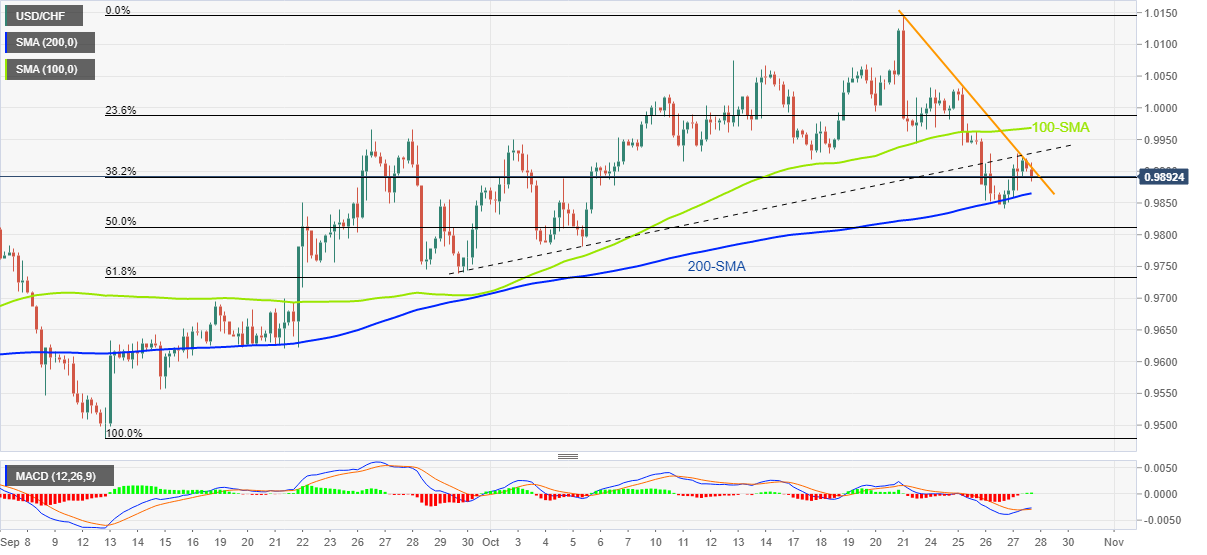
Trend: Further downside expected
-
03:09
USD/CNH slides below 7.2300 even as IMF cuts China’s growth forecasts, US Core PCE Inflation eyed
- USD/CNH consolidates weekly gains while fading the bounce off a fortnight low.
- IMF cuts Asian region economic estimations and holds China responsible.
- Easing hawkish Fed bets exert downside pressure on the DXY.
- Fed’s preferred inflation gauge will be crucial to watch ahead of next week’s FOMC.
USD/CNH takes offers to refresh the intraday low near 7.2260 as it pares the weekly gains during Friday’s Asian session. In doing so, the offshore Chinese yuan (CNH) pair fails to justify the International Monetary Fund’s (IMF) grim outlook for the dragon nation amid a broad weakness in the US dollar.
“The IMF cut Asia's economic forecasts on Friday as global monetary tightening, rising inflation blamed on the war in Ukraine, and China's sharp slowdown dampened the region's recovery prospects, “ said Reuters. The news also adds that the IMF cut Asia's growth forecast to 4.0% this year and 4.3% next year, down 0.9% point and 0.8 points from April, respectively. The slowdown follows a 6.5% expansion in 2021. Further details suggest that the Washington-based institute expects China's growth to slow to 3.2% this year, a 1.2-point downgrade from its April projection, after an 8.1% rise in 2021. The world's second-largest economy is seen growing 4.4% next year and 4.5% in 2024, the IMF said as per Reuters.
Elsewhere, the DXY retreats to 110.50, following Thursday’s recovery from the five-week-low, as Fed hawks get mixed details of the overall strong US data. The US Gross Domestic Product (GDP) rose 2.6% on an annualized basis, more than expected, in the third quarter (Q3). Even so, a fifth consecutive fall in private consumption challenged the Fed hawks as it showed the policymakers are gradually nearing the target of slowing down private domestic demand, which in turn might favor the easy rate hike talks for December in the next week’s Federal Open Market Committee (FOMC) meeting.
That said, the sluggish US Treasury yields and the risk-off mood also challenge the US dollar. The US 10-year Treasury yields dropped to a two-week low on Thursday and are bracing for the first weekly loss in 11, which in turn allowed equities to have a nice week despite the latest weakness in numbers.
Moving on, the US Core PCE Price Index for September, expected to rise to 5.2% versus 4.9% prior, will be crucial for the USD/CNH pair traders to watch for clear directions. A firmer print of the Fed’s preferred inflation gauge could add strength to the yields and hawkish Fed bets, which in turn will be favorable for the pair buyers.
Technical analysis
A failure to cross the one-month-old horizontal resistance area surrounding 7.2700-2675 directs USD/CNH back toward the 21-DMA support near 7.1885.
-
03:03
IMF cuts 2022 China GDP forecast to 3.2% vs. 4.4%
In its latest review of the Chinese economy, the International Monetary Policy Fund (IMF) slashed its GDP forecast for the world’s second-largest economy from 4.4% to 3.2% this year.
Key takeaways
“The Fund expects China’s GDP at 4.4% in 2023 and 4.5% in 2024.”
China's rapid and broad-based economic slowdown blamed on strict COVID-19 lockdowns and its worsening property woes
"With a growing number of property developers defaulting on their debt over the past year, the sector's access to market financing has become increasingly challenging."
"Risks to the banking system from the real estate sector are rising because of substantial exposure."
Market reaction
The aussie shrugs off the IMF report, as AUD/USD Is rebounding 0.38% on the day at 0.6472, as of writing.
-
03:02
When is the BoJ and how might it affect USD/JPY?
Expected at around 0300 GMT, the Bank of Japan meeting will conclude today with the statement being delivered, quarterly forecasts and Governor Kuroda press conference. The meeting is held in high anticipation, for one considering the high volatility in the yen of late that has at times seen ranges of over 500 pips on any given day. There is no fixed time for the announcement but it is widely expected that the central bank will keep the key rates maintained, notably the 0% yield target on the 10-year JGB (+/-0.25%).
As analysts at Westpac explained, ''BoJ officials continue to argue that while headline and CPI ex-fresh food (the official target) have risen to 8-year highs, it is a cost-push move and that without wages picking up, it will not be sustained. Still, there will be tension for JPY around the meeting and the press conference.''
Analysts at Commerzbank note that some observers argue that the MOF's interventions argue for an end to QQE-YCC. ''We argue that this is not necessarily the case. But if the end of QQE-YCC does come at some point, the exit will be tricky. Admittedly, not necessarily for the reasons that are currently commonly cited.''
How might the BoJ affect USD/JPY?
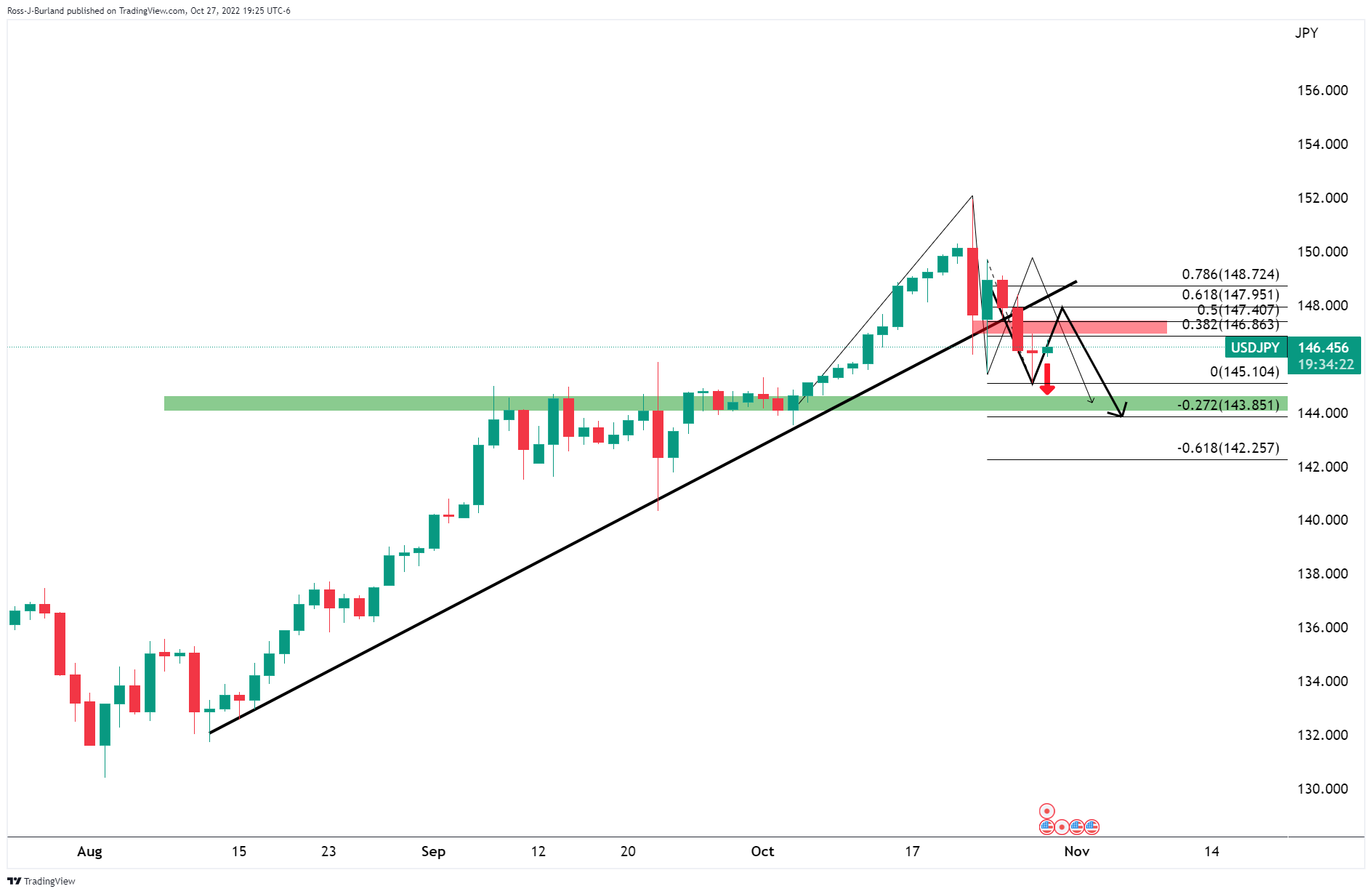
Regardless of the outcome, the price is on the backside of the trendline which leaves the bias bearish for the near to medium term. The price is correcting towards the neckline of the M-formation and the 38.2% Fibonacci of the prior bearish impulse. if this were to hold, then the bias will be on the downside to target the support near 144.00 the figure.
Meanwhile, the hourly chart confirms the move higher considering the break of the symmetrical bounded range's resistance line with near-term resistance guarding 147 the figure and then 147.50.
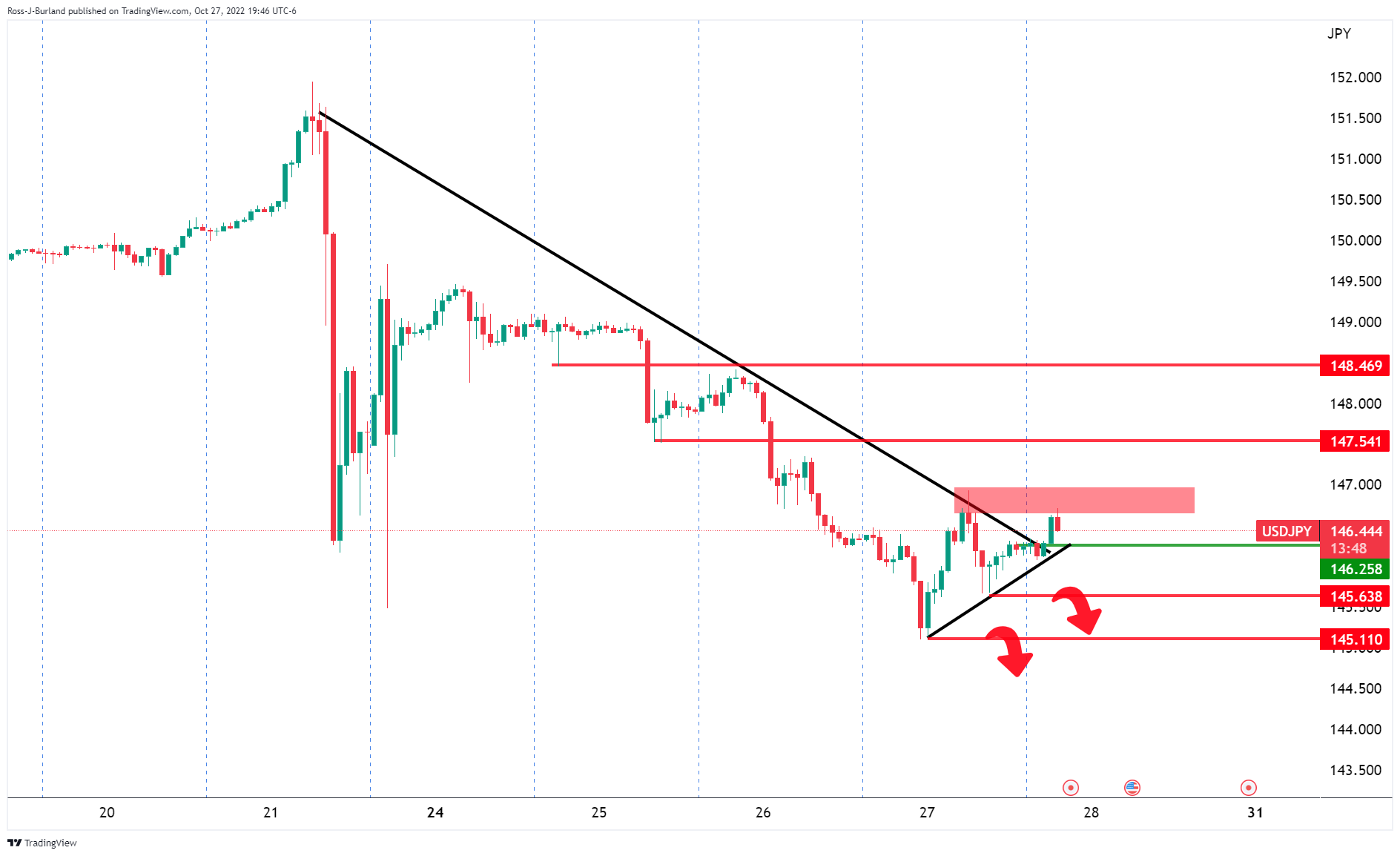
Ultimately, what matters for JPY exchange rates are real yields adjusted for inflation and real interest rates and real returns in Japan will be permanently less attractive for investors in comparison to the US, which will remain problematic for the BoJ. While yield curve control on the BoJ’s terms remains, only a weaker USD is likely to change the dynamic for USD/JPY.
About the BoJ interest rate decision
BoJ Interest Rate Decision is announced by the Bank of Japan. Generally, if the BoJ is hawkish about the inflationary outlook of the economy and rises the interest rates it is positive, or bullish, for the JPY. Likewise, if the BoJ has a dovish view of the Japanese economy and keeps the ongoing interest rate, or cuts the interest rate it is negative, or bearish.
-
02:43
Silver Price Analysis: XAG/USD fades bounce off 200-SMA around mid-$19.00s
- Silver price snaps three-day winning streak but sellers remain cautious of late.
- Firmer RSI, a struggle to break 200-SMA keep buyers hopeful.
- Fortnight-old rising wedge bearish formation teases sellers amid a sluggish session.
Silver price (XAG/USD) prints the first loss-making day in three even as sellers make rounds to $19.50 during Friday’s Asian session.
In doing so, the bright metal fades the previous day’s bounce off the 200-SMA while staying inside a two-week-long rising wedge bearish chart pattern.
Given the gradual recovery of the RSI (14), the metal’s recovery in the last week appears interesting to lure buyers.
However, a clear upside break of the stated wedge’s resistance line, near $19.95, as well as a clearance of the $20.00 threshold, becomes necessary for the XAG/USD’s run-up.
Following that, $20.30 and $20.85 can challenge the silver buyers before directing them to the monthly peak surrounding $21.25.
Alternatively, the downside break of the $19.45 level comprising the immediate support line, forming part of the rising wedge, could lure the XAG/USD bears to challenge the 200-SMA level near $19.30.
In a case where silver bears remain dominant past $19.30, the $18.90 level may test the downside before highlighting the theoretical target of the rising wedge breakdown, close to $17.70.
Overall, the silver price may witness further downside but the bears need a solid trigger to push back the bullish hopes.
Silver: Four-hour chart
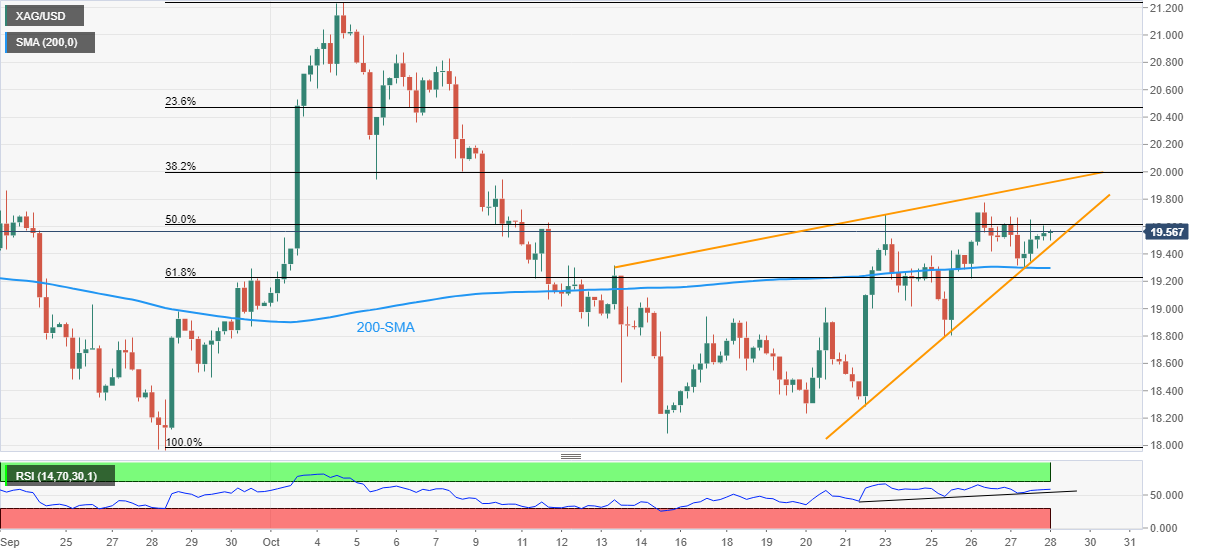
Trend: Further weakness expected
-
02:35
EUR/GBP resurfaces from 0.8600 ahead of German GDP
- EUR/GBP has seen fresh demand around 0.8600 as the impact of less-hawkish ECB policy guidance eases.
- UK PM Rishi Sunak is exploring tax rise and spending cuts of up to GBP 50 billion.
- Investors will shift their focus toward the BOE policy decision scheduled for next week.
The EUR/GBP pair has witnessed fresh demand from 0.8610 in the Tokyo session. The asset delivered a north-side break of the consolidation formed in a narrow range of 0.8610-0.8620 ahead of the German Gross Domestic Product (GDP) data.
The risk profile has sensed a recovery as S&P500 futures have trimmed their gains. Also, the US dollar index (DXY) has witnessed a correction to near 110.35.
On Thursday, the shared currency bulls witnessed an extreme sell-off after the announcement of the monetary policy by the European Central Bank (ECB). ECB President Christine Lagarde announced a consecutive 75 basis point (bps) rate hike and pushed the interest rates to 1.5%, the highest since 2009 to combat the historic surge in inflation and ensure a timely return of the same to 2%.
What weakened the euro bulls is the less-hawkish tone on policy guidance. However, analysts at Commerzbank, point out Christine Lagarde sounded dovish at the press conference but they still see that another big rate hike for the December meeting remains on the table.
Going forward, investors will focus on the German Domestic Product (GDP) data. As per the consensus, the annual GDP growth rate for the third quarter will land at 0.8%, lower than the prior release of 1.7%. On a quarterly basis, the GDP data will display a contraction of 0.2%.
On the UK front, novel UK Prime Minister Rishi Sunak has shifted its entire focus on trimming the pile of debt to bring financial stability. Reports from Financial Times claim that Sunak is exploring tax rises and spending cuts of up to GBP 50 billion, which is in line with the agenda of the bank of England (BOE). Next week, investors will shift their entire focus toward the monetary policy of the BOE. The impact of the monetary policy decision will be extremely higher as it will be the first interest rate decision post-Sunak’s appointment as UK PM.
-
02:24
USD/CAD slides to 1.3550 despite softer oil price, US PCE inflation eyed
- USD/CAD fades the previous day’s rebound from a five-week low.
- US dollar’s struggle to defend bulls ahead of Fed’s preferred inflation gauge tease pair sellers.
- Risk aversion weighs on energy prices even as demand expectations increase.
USD/CAD takes offers to refresh the intraday low near 1.3550, reversing the previous day’s bounce off the monthly bottom, during Friday’s Asian session.
In doing so, the Loonie pair ignores the recent weakness in Canada’s main export item, WTI crude oil, as the US Dollar Index (DXY) consolidates the previous day’s gains amid the recent decline in the hawkish Fed bets.
That said, the DXY retreats to 110.50, following Thursday’s recovery from the five-week-low, as Fed hawks get mixed details of the overall strong US data. The US Gross Domestic Product (GDP) rose 2.6% on an annualized basis, more than expected, in the third quarter (Q3). Even so, a fifth consecutive fall in private consumption challenged the Fed hawks as it showed the policymakers are gradually nearing the target of slowing down private domestic demand, which in turn might favor the easy rate hike talks for December in the next week’s Federal Open Market Committee (FOMC) meeting.
It should be noted that the sluggish US Treasury yields and the risk-off mood also challenge the US dollar. The US 10-year Treasury yields dropped to a two-week low on Thursday and are bracing for the first weekly loss in 11, which in turn allowed equities to have a nice week despite the latest weakness in numbers.
At home, the Bank of Canada’s (BOC) 0.50% rate hike, versus the 0.75% expected, joins the policymakers’ optimism to keep the USD/CAD bears hopeful.
Looking forward, the US Core PCE Price Index for September, expected to rise to 5.2% versus 4.9% prior, will be crucial for the USD/CAD pair traders to watch for clear directions. A firmer print of the Fed’s preferred inflation gauge could add strength to the yields and hawkish Fed bets, which in turn will be favorable for the pair buyers.
Technical analysis
Bearish MACD signals join the pair’ sustained trading below the 21-DMA resistance near 1.3700 to keep sellers hopeful. However, a daily closing below 1.3505-3495 support zone appears necessary to confirm further downside.
-
02:19
USD/CNY fix: 7.1698 vs. prev fix 7.1570
In recent trade today, the People’s Bank of China (PBOC) set the yuan (CNY) at 7.1698 vs. the previous fix of 7.1570 and the previous close of 7.2240.
About the fix
China maintains strict control of the yuan’s rate on the mainland.
The onshore yuan (CNY) differs from the offshore one (CNH) in trading restrictions, this last one is not as tightly controlled.
Each morning, the People’s Bank of China (PBOC) sets a so-called daily midpoint fix, based on the yuan’s previous day's closing level and quotations taken from the inter-bank dealer.
-
02:02
RBA to stick with modest rate hikes despite hot inflation
The Reserve Bank of Australia will raise interest rates by a more modest 25 basis points for a second straight month on Tuesday and is set to do so again in December despite the highest inflation in three decades, a Reuters poll found.
''This puts the RBA - which kicked off its relatively late starting rate-hiking campaign with four straight 50 bp moves - out of step with its global peers, which are mostly still raising rates in larger increments.''
AUD/USD update
The Australian dollar hovers around 0.65, near its highest levels in three weeks vs the greenback. The US dollar was put on the backfoot this week following the Bank of Canada's dovish hike in anticipation that the US Federal Reserve would soon slow down its rate increases.
The Aussie has also found a bid on hotter-than-expected domestic inflation data. For year on year, the consumer price surged 7.3% in the third quarter of 2022 from 6.1% in the second quarter, accelerating at the fastest pace since 1990 and exceeding expectations for a 7% gain.
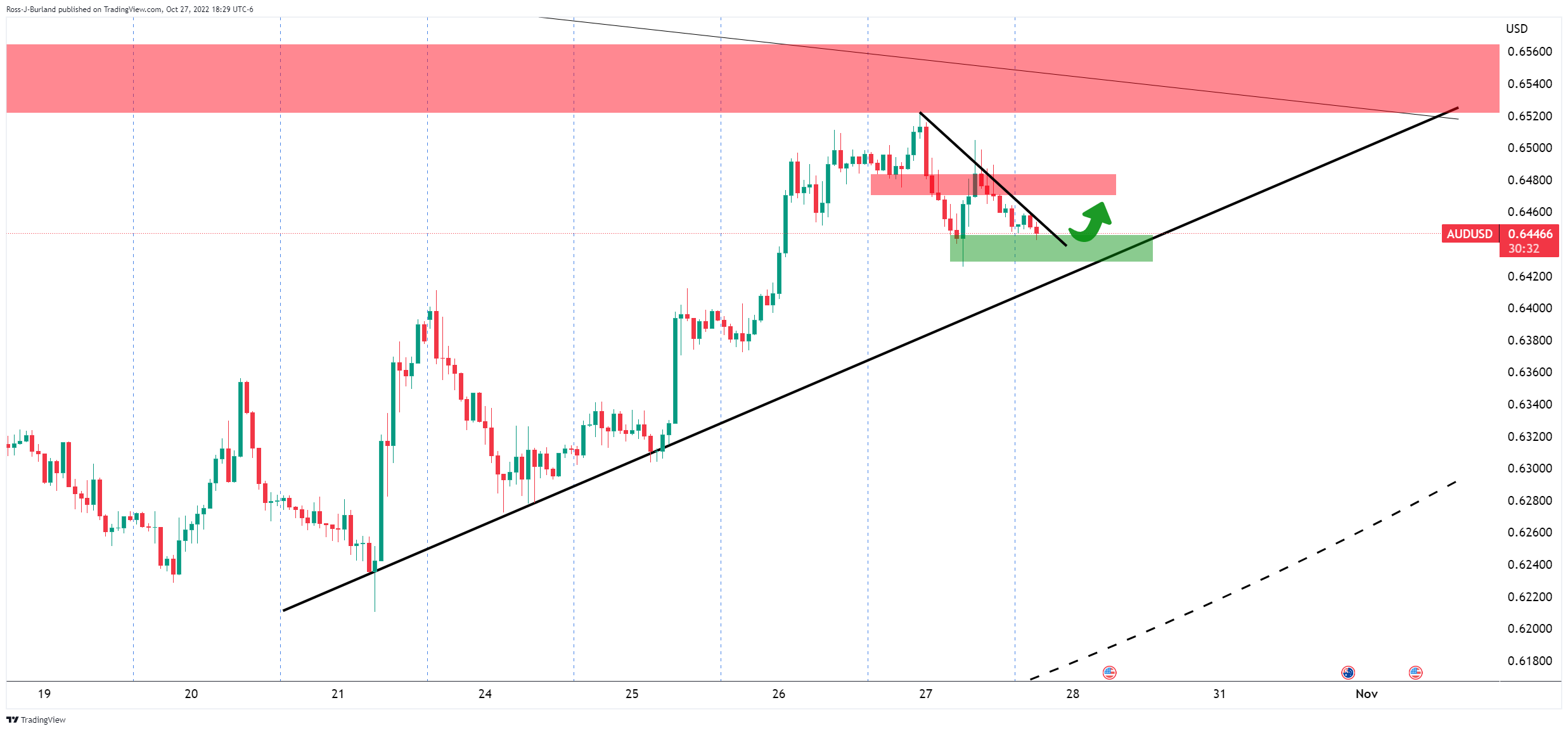
- AUD/USD Price Analysis: Bulls need to hold above 0.6435
-
01:55
GBP/USD Price Analysis: Further downside hinges on 1.1540 break
- GBP/USD broker weekly support line but sellers attack one-month-old previous resistance.
- MACD, RSI suggests further downside towards 200-SMA support.
- Multiple hurdles stand tall to challenge buyers beyond monthly high.
GBP/USD extend the previous day’s pullback from a six-week high, mildly offered at 1.1550 during Friday’s Asian session. In doing so, the cable pair sellers cheer the downside break of a weekly support line, now resistance, to jostle with the resistance-turned-support trend line from September 20.
Given the RSI’s retreat from the overbought territory, as well as the bearish MACD signals and the weekly support break, the GBP/USD pair is likely to extend the latest declines past the immediate support line, around 1.1540.
Following that, the mid-month peak near 1.1440 could act as a buffer during the quote’s likely slump toward the 200-SMA support close to 1.1230.
In a case where GBP/USD remains weak past 1.1230, an upward-sloping support line from September 29 around 1.1140 will be crucial to watch for further downside directions.
Alternatively, the recently broken support line, now resistance around 1.1600, guards immediate recovery of the GBP/USD prices ahead of challenging the monthly high of 1.1645.
It should be noted, however, that September’s top and lows marked during July, respectively near 1.1740 and 1.1760, will be tough challenges for the pair buyers past 1.1645.
GBP/USD: Four-hour chart
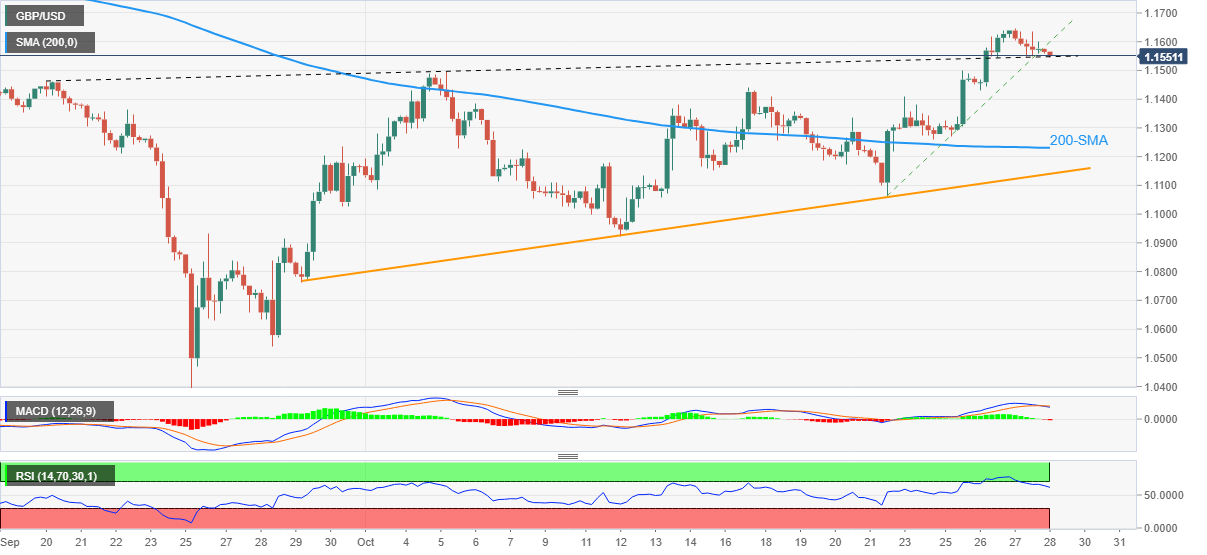
Trend: Further weakness expected
-
01:52
EUR/USD hovers at make or a break around 0.9960, yields drop further
- EUR/USD is on the verge of delivering a break of the 0.9960 support amid negative market sentiment.
- A resurgence Russia-Ukraine war fears and less hawkish policy guidance by the ECB weighed on Euro.
- The US Treasury yields are facing the heat of declining bets for a bigger rate hike by the Fed.
The EUR/USD pair is auctioning on the edge of critical support of 0.9960 in the Tokyo session. The asset could continue Thursday’s downside momentum amid a rebound in the risk-off impulse. Also, ‘Buy on rumor, sell on news’ indicator was triggered on Thursday after the European Central Bank (ECB) tightened its policy and pushed interest rates highest to 9% since 2009.
Meanwhile, the US dollar index (DXY) is oscillating around 110.60 and is looking to remain solid amid the risk-aversion theme. The 10-year US Treasury yields have dropped to 3.93%, at the time of writing.
An announcement of a 75 basis point (bps) rate hike by ECB President Christine Lagarde dragged the euro bulls. The extent of the rate hike remained in line with the estimates as a historic surge in inflation is required to be tamed. The unwinding of gigantic stimulus requires a heap of policy-tightening measures.
ECB’s Lagarde cited Russia's invasion of Ukraine and other global uncertainties responsible for downside risks in the Eurozone, and upward bias for inflation.
For guidance on interest rates, analysts at Commerzbank, point out Christine Lagarde sounded dovish at the press conference but they still see that another big rate hike for the December meeting remains on the table.
The shared currency bulls also witnessed extreme selling pressure on Thursday as market sentiment dampened after the US government announced military aid of $275 million to Ukraine to drive Russian rebels out of key areas.
On the US front, declining odds of a bigger rate hike by the Federal Reserve (Fed) have weighed on the returns generated by US Government bonds. A drop in consumer spending expansion in the third quarter at 1.4% vs. the prior release of 2.0% has indicated that inflationary pressures are exhausting.
-
01:42
AUD/USD Price Analysis: Bulls need to hold above 0.6435
- AUD/USD is meeting a key resistance line with eyes on a break of both hourly and daily trendlines.
- The bulls will be in control if they can hold above 0.6435/50.
As per the prior analysis, AUD/USD Price Analysis: A long squeeze could be in order for the day ahead, the following is a bullish scenario taking into consideration the bottoming pattern, the bullish trend line with the price still on the front side of the trend.
AUD/USD daily chart
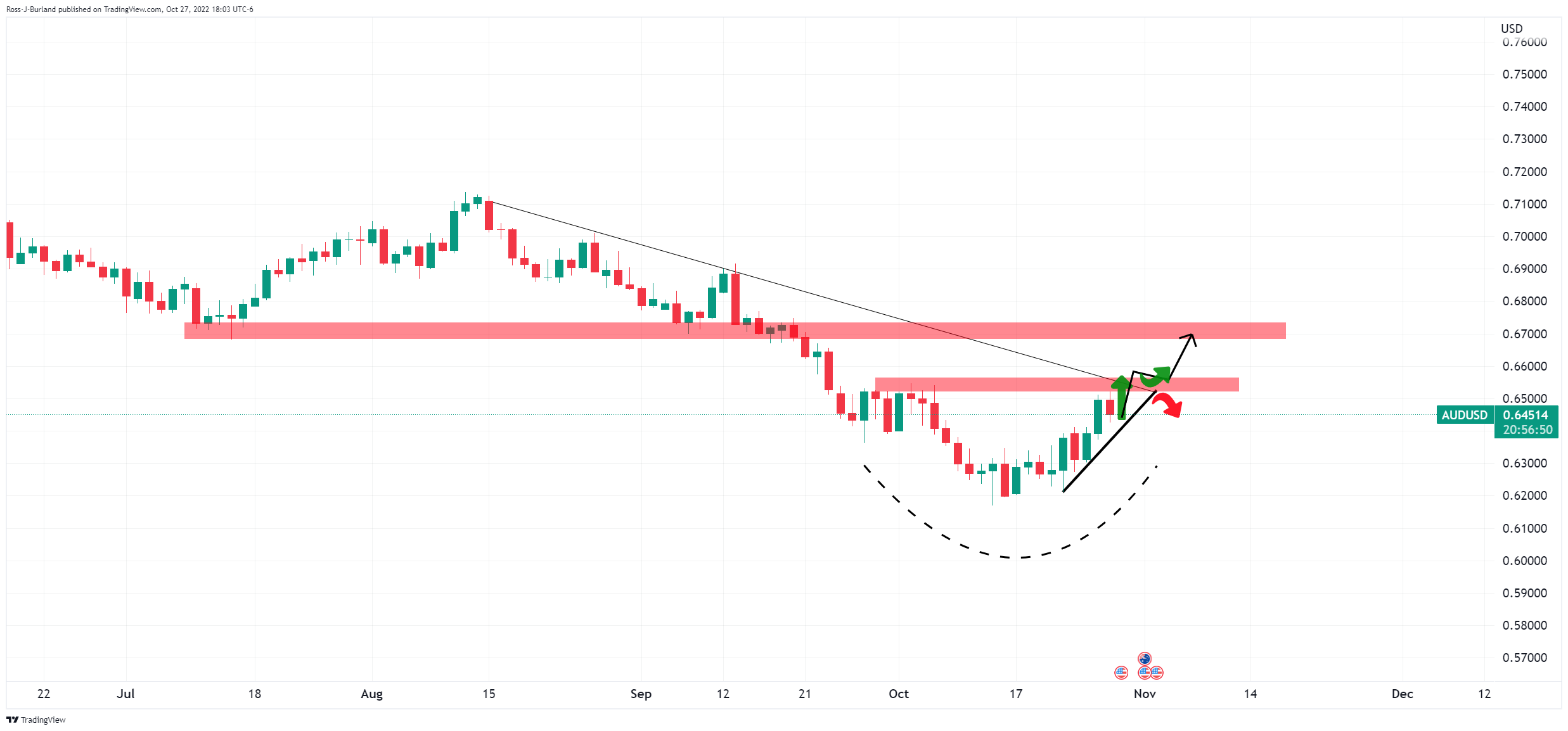
The bulls remain in control despite the risks of rejection at the resistance and a move below the trendline support. 0.6550 is a key level on the daily chart while the bulls hold on 100 pips lower.
AUD/USD H1 chart

The hourly chart shows the price supported at 0.6450 and wedged in against a trendline resistance that could be about to give out. In doing so, the bulls will be in the runnings for a significant run to the upside to test 0.6500 and on the way to the more dominant resistance of the daily bearish trendline.
-
01:31
Gold Price Forecast: XAU/USD retreats towards $1,650 on firmer DXY, focus on US PCE inflation
- Gold price extends the previous day’s downbeat performance, sellers attack weekly support line.
- Markets sentiment soars amid mixed US data, downbeat yields and a firmer DXY.
- XAU/USD bears need validation from Fed’s preferred inflation gauge amid hopes of easing rate hikes.
Gold price (XAU/USD) remains pressured for the second consecutive day as sellers poke short-term key support around $1,660 during Friday’s Asian session. In doing so, the bullion justifies a firmer US dollar amid the risk-off mood. Also exerting downside pressure on the metal could be the anxiety ahead of the Fed’s preferred inflation gauge, namely the US Core PCE Price Index for September.
That said, the US Dollar Index (DXY) recovered from a five-week low after the Gross Domestic Product (GDP) rose 2.6% on an annualized basis, more than expected, in the third quarter (Q3). Even so, a fifth consecutive fall in private consumption challenged the Fed hawks as it showed the policymakers are gradually nearing the target of slowing down private domestic demand, which in turn might favor the easy rate hike talks for December in the next week’s Federal Open Market Committee (FOMC) meeting. As a result, the gold bears struggle to retake control even as the DXY bounces off a multi-day low backed by strong US GDP.
Elsewhere, the US 10-year Treasury yields dropped to a two-week low on Thursday and are bracing for the first weekly loss in 11 amid receding hawkish Fed bets. The same allowed equities to have a nice week despite the latest weakness in numbers, which in turn lured XAU/USD buyers despite the risk-off mood.
Moving on, a fall in the US equities and recently firmer yields help XAU/USD bears amid a sluggish session ahead of the Core PCE Price Index for September, expected to rise to 5.2% versus 4.9% prior. It’s worth mentioning that a firmer print of the Fed’s preferred inflation gauge could add strength to the yields and hawkish Fed bets, which in turn will be favorable for the gold bears.
Technical analysis
Gold extends pullback from 200-SMA as sellers poke a one-week-old support line near $1,660 amid the RSI retreat. That said, the 50-SMA support near $1,650 adds to the downside filters before welcoming the XAU/USD bears targeting the yearly low surrounding $1,614.
It’s worth noting that multiple levels surrounding $1,620 could test the metal sellers while the $1,600 psychological may lure the downside move past $1,614.
Meanwhile, an upside clearance of the 200-SMA, around $1,667 by the press time, could direct the gold buyers towards a 13-day-old descending resistance line surrounding $1,675.
To sum up, gold prices are likely to remain pressured toward a yearly low.
Gold: Four-hour chart
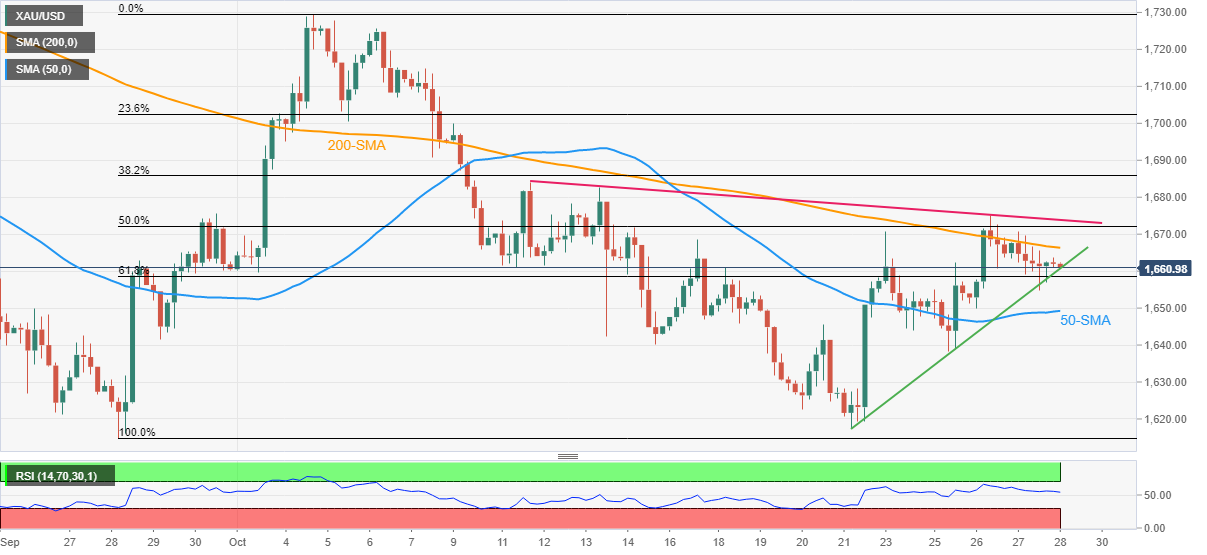
Trend: Further weakness expected
-
01:30
Australia Producer Price Index (QoQ) registered at 1.9% above expectations (1.5%) in 3Q
-
01:30
Australia Producer Price Index (YoY) in line with expectations (6.4%) in 3Q
-
01:30
Stocks. Daily history for Thursday, October 27, 2022
Index Change, points Closed Change, % NIKKEI 225 -86.6 27345.24 -0.32 Hang Seng 110.27 15427.94 0.72 KOSPI 39.22 2288.78 1.74 ASX 200 34.2 6845.1 0.5 FTSE 100 17.59 7073.69 0.25 DAX 15.42 13211.23 0.12 CAC 40 -32.28 6244.03 -0.51 Dow Jones 194.17 32033.28 0.61 S&P 500 -23.3 3807.3 -0.61 NASDAQ Composite -178.32 10792.67 -1.63 -
01:15
Currencies. Daily history for Thursday, October 27, 2022
Pare Closed Change, % AUDUSD 0.64518 -0.55 EURJPY 145.726 -1.24 EURUSD 0.99625 -1.14 GBPJPY 169.146 -0.56 GBPUSD 1.15649 -0.44 NZDUSD 0.5826 -0 USDCAD 1.3565 0.03 USDCHF 0.99066 0.46 USDJPY 146.272 -0.11 -
01:13
US Dollar Index aims to recapture 111.00 amid risk-off mood, hawkish Fed bets dwindle
- The DXY is oscillating in a 110.47-110.62 range, upside remains favored amid the risk-off impulse.
- A robust growth rate of 2.6% in the third quarter cemented a sharp recovery in the DXY.
- Lower consumer spending to 1.4% in Q3CY22 has trimmed bets for a bigger rate hike by the Fed.
The US dollar index (DXY) is displaying a rangebound structure in a narrow range of 110.47-110.62 in the Tokyo session. The DXY witnessed a juggernaut rally on Thursday after market sentiment turned sour as the US promised military aid to Ukraine and the robust US Gross Domestic Product (GDP) report displayed the strength of the US economy.
Robust GDP supported DXY recovery from 109.50
The mighty DXY witnessed a decent buying interest on Thursday after recording a fresh monthly low at 109.54. As the US economy reported a growth rate of 2.6% in the July to September period vs. an economic contraction in the first half of CY2022, investors rushed to channel their funds into the greenback.
Also, risk sentiment dented after the US administration promised military aid of $275 million to Ukraine to drive Russian rebels out of key areas improving safe-haven’s appeal.
Hawkish Fed bets trim on lower consumer spending
The GDP report displayed that consumer spending, which accounts for 70% of the GDP activity has expanded by 1.4%, and remained lower than the 2% growth recorded in the second quarter. A slowdown in consumer spending indicates that mounting inflationary pressures are exhausting after all. As per the CME FedWatch tool, the chances of 75 basis points (bps) rate hike by the Federal Reserve (Fed) have dropped to 88.5%.
This has also weighed pressure on alpha generated by the US government bonds. The 10-year US Treasury yields have slipped to 3.93%.
Adding to that, investment in real estate plunged by 26% amid soaring interest rates, which has forced individuals to postpone their housing demand due to higher EMI obligations.
-
01:03
WTI teases sellers around $88.00 amid mixed concerns over demand-supply matrix
- WTI prints mild losses to pare the first weekly gain in three.
- Hopes of economic recovery battle with China-linked concerns, geopolitical headlines to trouble oil traders.
- DXY rebound adds to the upside filters but record US exports suggest increasing energy demand.
- Risk catalysts are the key for near-term directions, US Core PCE Inflation eyed as well.
WTI crude oil prices extend the previous day’s pullback from a fortnight high while printing mild losses around $88.00 during Friday’s Asian session. In doing so, the black gold snaps the previous three-day uptrend while consolidating the first weekly gain in three.
Although record US oil exports and firmer US Gross Domestic Product (GDP) data tamed the recession fears on Thursday, concerns over China’s economic health and cautious mood in the market weigh on the commodity prices of late. Also, recent headlines suggesting no preparations on the part of Russia to use nuclear weapons in the war with Ukraine seemed to have challenged the oil buyers.
Gross Domestic Product (GDP) rose 2.6% on an annualized basis, more than expected, in the third quarter (Q3). It should also be noted, however, that the details suggesting a fifth consecutive fall in private consumption challenged the Fed hawks as it showed the policymakers are gradually nearing the target of slowing down private domestic demand.
“Data showed record U.S. crude exports, a hopeful sign for demand. Speculation that central banks could be nearing the end of rate-hiking cycles added support, after the European Central bank raised rates by 75 basis points (bps),” stated Reuters.
Also keeping oil buyers hopeful is the Western efforts to jointly cap the Russian energy price, which in turn escalates the political tension between Moscow and the West to suggest further hardships for WTI bears.
On the other hand, China’s zero-covid policy and mixed growth, as well as the recently strong rate hikes from the major central banks, challenge the black gold buyers. On the same line could be the latest talks between Saudi Arabia and the diplomats from Pakistan and France that signal more output.
Looking forward, oil traders may keep their eyes on the risk catalysts for fresh impulse. Also important will be the Core PCE Price Index for September, expected to rise to 5.2% versus 4.9% prior. That said, a firmer print of the Fed’s preferred inflation gauge could add strength to the yields and hawkish Fed bets, which in turn will be favorable for the oil bears.
Technical analysis
Thursday’s Doji challenge WTI buyers but a convergence of the 21-DMA and 50-DMA challenge oil sellers around $86.00.
-
00:41
AUD/JPY advances towards 94.50 amid mix Japan labor data, BOJ policy eyed
- AUD/JPY is marching towards 94.50 after the release of mixed Japan employment data.
- Japan’s jobless rate has expanded to 2.6% while Jobs/Applicant Ration has improved to 1.34.
- The BOJ may announce a stimulus package along with a dovish tone on interest rates.
The AUD/JPY pair is marching towards the immediate hurdle of 94.50 in the early Tokyo session as the Statistics Bureau of Japan has reported mixed employment data. The Unemployment Rate has escalated to 2.6% against expectations and the prior release of 2.5%. While the Jobs/Applicants ratio has improved to 1.34 vs. the projections of 1.33.
Risk sentiment remained negative on Thursday after the US administration announced that it is sending Ukraine a new $275 million package of weapons and other aid, to strengthen the Ukrainian rebels to drive Russian forces out of key areas in the south as the winter closes in, reported AP News. The war headlines restricted the cross from surpassing the critical hurdle of 95.00.
Going forward, the monetary policy of the Bank of Japan (BOJ) will remain in focus.
In order to accelerate inflationary pressures in Japan and to safeguard the economy from the impact of external demand shocks, the BOJ is left with no other option than to continue an ultra-dovish policy stance on interest rates. BOJ Governor Haruhiko Kuroda may also announce a stimulus package along with a softer tone on policy rates.
On Thursday, Japanese officials announced that they are planning to release more stimulus to the economy to spurt the overall demand. Japan’s Finance Minister Shunichi Suzuki said that “tomorrow, a stimulus package will be decided.” Japan’s national broadcaster, NHK, reported that a stimulus package of more than JPY 29 trillion is in consideration.
On the Australian front, investors are shifting their focus toward the interest rate decision by the Reserve Bank of Australia (RBA), which is due next week. As price pressures have escalated to 7.3%, RBA Governor Philip Lowe could return to 50 basis points (bps) rate hike spell.
-
00:38
NZD/USD Price Analysis: Thursday’s Doji teases sellers above 0.5800
- NZD/USD struggles to extend the previous day’s pullback from a five-week high.
- Bearish candlestick, failure to cross 50-DMA keeps sellers hopeful.
- Sellers have a bumpy road to the south unless breaking 0.5680.
NZD/USD stays defensive above 0.5800, taking rounds to 0.5830 during Friday’s Asian session, following a pullback from the monthly top. In doing so, the Kiwi pair struggle to justify the previous day’s bearish Doji candlestick, as well as a failure to cross the 50-DMA hurdle.
It should be noted, however, that a steady rise in the RSI (14) without being near the overbought territory, suggests that the sellers have a tough fight ahead.
That said, a two-week-old ascending trend line and the previous resistance line from August 12, respectively near 0.5720 and 0.5700, could challenge short-term NZD/USD bears.
Following that, the 21-DMA level of 0.5682 could act as the last defense of the buyers, a break of which might not hesitate to challenge the yearly low marked earlier in the month around 0.5510.
Meanwhile, a daily closing beyond the 50-DMA hurdle surrounding 0.5870, appears necessary for the NZD/USD buyer’s return.
The following run-up can face a tough time as the 0.5900 threshold and the 0.6000 psychological magnet will be strong hurdles.
In a case where NZD/USD rises past 0.6000, September’s peak near 0.6165 will be in focus.
NZD/USD: Daily chart
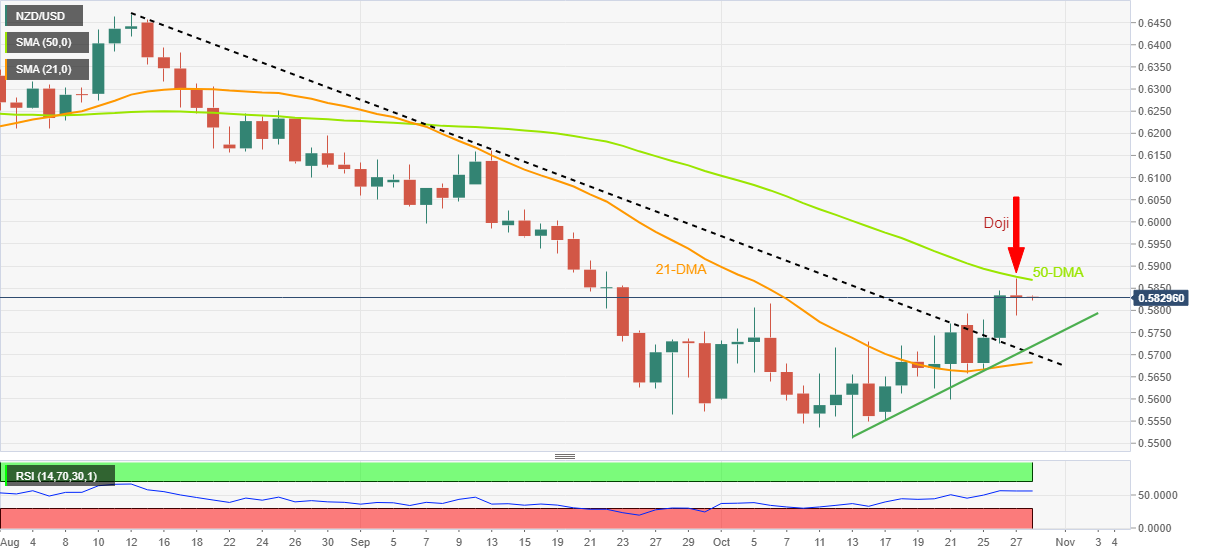
Trend: Pullback expected
-
00:36
USDJPY: The USDJPY consolidates ahead of the BoJ policy decision
- Better-than-expected United States economic growth bolstered the USD against most G8 currencies, except the Japanese Yen.
- The path of the US 10-year Treasury yield dictates the trend of the USDJPY due to its high correlation.
- The Bank of Japan’s (BoJ) monetary policy could rock the boat if the BoJ shifts to a neutral stance.
- USDJPY is still upward biased, though its trend is at the mercy of the US 10-year T-bond yield trend.
The USDJPY barely slumps as the Asian Pacific session begins, following a trading day where a strong US Dollar spurred by positive data from the United States was not enough to derail the Japanese Yen, which held to gains, even though they were minimal, as delineated by the USDJPY sliding 0.04%. Also, a looming monetary policy decision by the Bank of Japan (BoJ) in the docket bolstered the JPY. The USDJPY is trading at 146.20, down by 0.05%.
US data bolstered the USD, but not against the JPY
During the New York session, the US Department of Commerce reported that the United States economy grew faster than estimated. The Gross Domestic Product (GDP) for the third quarter jumped by 2.6%, smashing forecasts of 2.6%. Even though it emphasizes the economy’s resilience, it would not deter Federal Reserve’s officials from tightening monetary conditions.
In the same report, consumer spending weakened, a cheered signal by Fed officials, as they intend to cool down the economy, with data reporting a deceleration from Q2’s 2% to 1.4% in the last quarter.
Additionally, labor market data added to the US Dollar strength, with Initial Jobless Claims for the week ending on October 22 increased by 217K but lower than 220K foreseen and above the previous week’s 214K. Even though US data was positive, it was offset by US Durable Goods Orders for September, which expanded 0.4% MoM, less than 0.6% estimates, showing that inventories are building up.
The USDJPY reaction to US data releases was muted due to the influence of the US Treasury yields.
US Treasury bond yields slide
In the meantime, speculations about a possible Federal Reserve’s pivot are meandering around the financial markets throughout the week, with traders beginning to price in a less hawkish Fed. The US 10-year bond yield plunged 36 bps weekly from its highs at 4.289% to 3.929%, a headwind for the USDJPY. The positive correlation between the USDJPY and the US 10-year bond yield would likely boost or weigh on the US Dollar and the Japanese Yen.
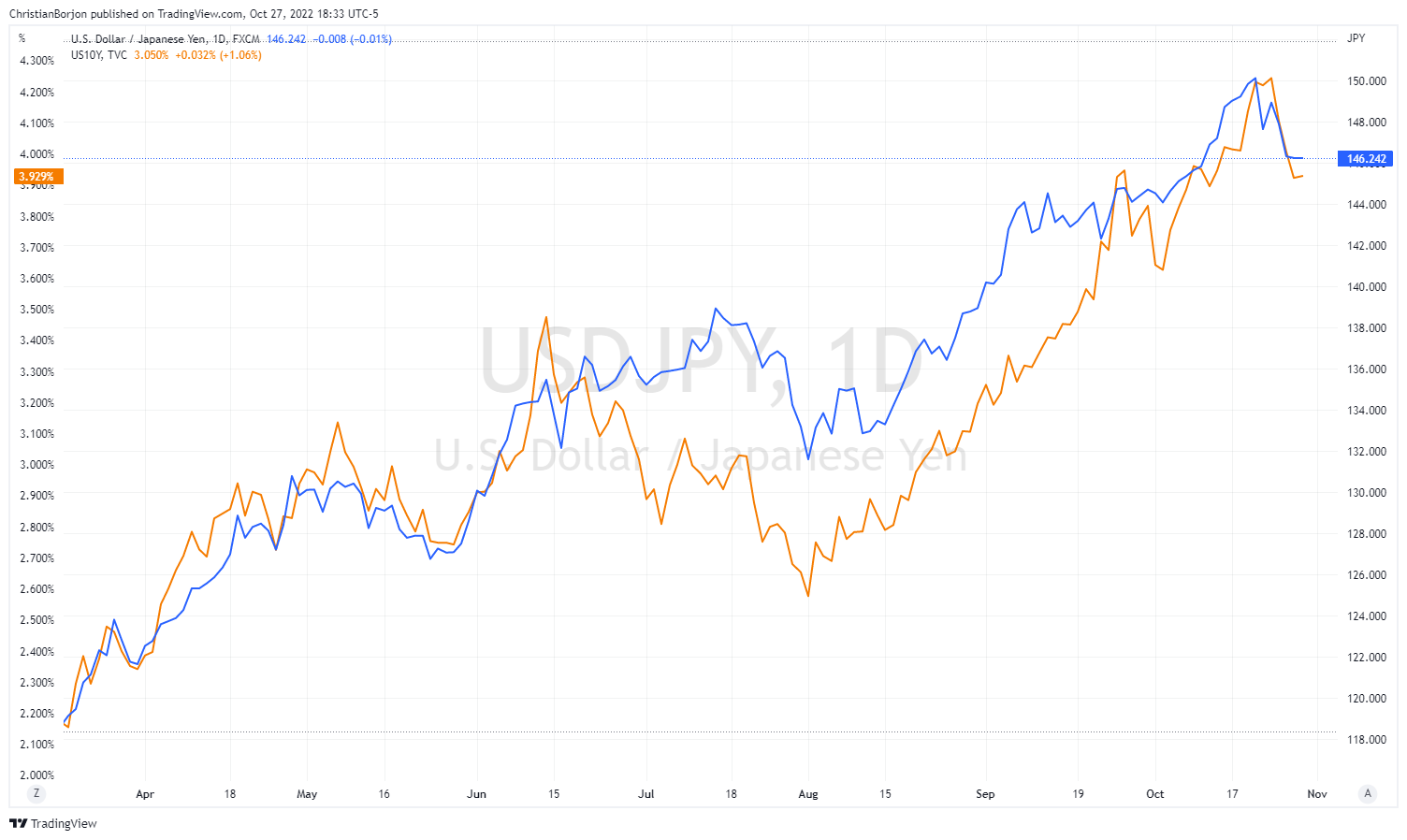
Correlation between the US10-year bond yield and the USDJPY
The Bank of Japan’s monetary decision looming
On Friday, the Bank of Japan (BoJ) would reveal its monetary policy decision. The BoJ is expected to hold rates unchanged at -0.10%, and would likely stick to its Yield Curve Control (YCC) around 0.25%, aimed to keep its ultra-loose monetary policy stance intact.
Such policy was aimed at bringing the Japanese economy out of a deflationary scenario, which so far has been achieved, as shown by the inflation report, namely the Consumer Price Index (CPI) for August, hitting the 3% YoY threshold. But the BoJ Governor Haruhiko Kuroda remains firm in his stance. However, the market has continued to test the JGB 10-year yield during the last month, as investors speculate that the BoJ could pivot from a dovish to a neutral stance sooner rather than later.
USDJPY Price Forecast: Technical outlook
The USDJPY is still upward-biased despite ongoing interventions by the BoJ in the FX markets. If sellers want to regain control, they will need to break below the October 5 daily low at 143.84 so that the USDJPY can challenge the 50-day Exponential Moving Average (EMA). Even though the Relative Strength Index (RSI) dived towards the 50-midline, it remains in positive territory; hence, the buyers are in control.
USDJPY key resistance levels lie at the 20-day EMA at 146.98, followed by 147.00 and the October 26 daily high at 148.41. On the flip side, the USDJPY’s first support would be the 146.00 mark. The break below will expose the weekly low at 145.10, which, once cleared, will expose the previously mentioned 50-day EMA at 143.83.
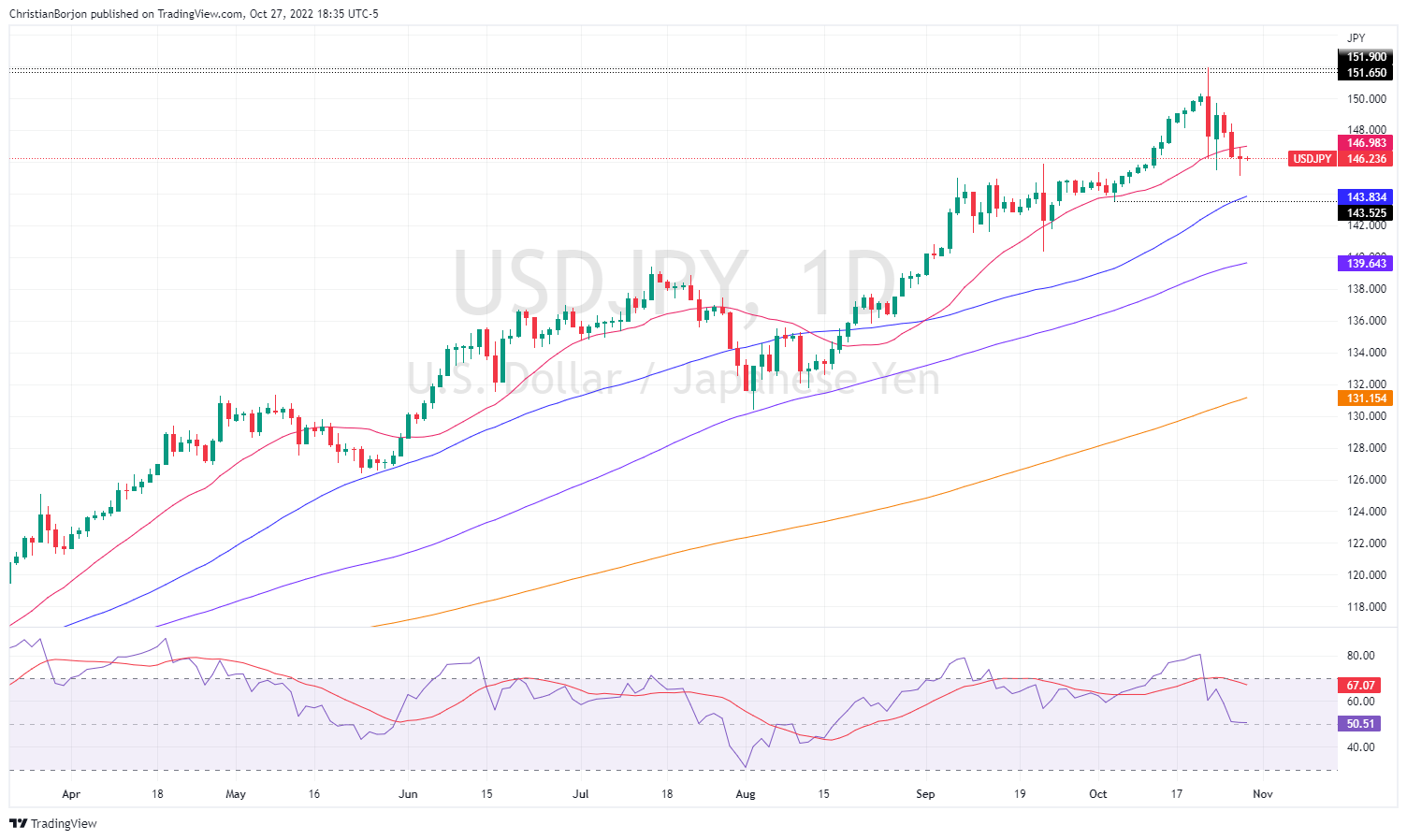
-
00:31
Japan Tokyo CPI ex Food, Energy (YoY) above expectations (2.1%) in October: Actual (2.2%)
-
00:31
Japan Tokyo CPI ex Fresh Food (YoY) came in at 3.4%, above forecasts (2.8%) in October
-
00:31
Japan Tokyo Consumer Price Index (YoY) came in at 3.5%, above expectations (3.1%) in October
-
00:30
Japan Unemployment Rate registered at 2.6% above expectations (2.5%) in September
-
00:30
Japan Jobs / Applicants Ratio came in at 1.34, above forecasts (1.33) in September
-
00:19
GBP/USD sellers remain unconvinced below 1.1600, US PCE inflation eyed
- GBP/USD stalls the previous day’s pullback from six-week high.
- DXY rebounds on strong US GDP, ignored downbeat yields.
- Fading UK’s political optimism adds strength to the pullback move.
- Fed’s preferred inflation gauge will be eyed ahead of next week’s FOMC.
GBP/USD struggles to defend bears while making rounds to 1.1570 Friday’s Asian session, after welcoming them from a monthly top the previous day.
The US dollar’s broad recovery joined an absence of upbeat British headlines to recall the pair sellers. However, the cautious mood ahead of the Fed’s preferred inflation gauge, namely the US Core PCE Price Index for September, seems to restrict the quote’s latest moves.
On Thursday, the US Dollar Index (DXY) recovered from a five-week low after the Gross Domestic Product (GDP) rose 2.6% on an annualized basis, more than expected, in the third quarter (Q3). It should also be noted, however, that the details suggesting a fifth consecutive fall in private consumption challenged the Fed hawks as it showed the policymakers are gradually nearing the target of slowing down private domestic demand, which in turn might favor the easy rate hike talks for December in the next week’s Federal Open Market Committee (FOMC) meeting.
Elsewhere, the newly formed British government is up for tax increases and spending cuts to fetch the UK economy from the recession woes. Even so, the doubts about the measures’ capability to revive the struggling economy and the Bank of England’s (BOE) likely easy stand, now that Rishi Sunak is Prime Minister, might also have favored the GBP/USD bears of late.
It’s worth noting that the US 10-year Treasury yields dropped to a two-week low on Thursday and are bracing for the first weekly loss in 11 amid receding hawkish Fed bets. The same allowed equities to have a nice week despite the latest weakness in numbers.
Moving on, the Core PCE Price Index for September, expected to rise to 5.2% versus 4.9% prior, will be crucial for the GBP/USD pair traders as a firmer print could add strength to the yields and hawkish Fed bets, which in turn will be favorable for the bulls.
Technical analysis
Despite the latest pullback, GBP/USD buyers remain hopeful unless the quote stays beyond the 1.1380-75 support confluence including the 50-DMA and an upward-sloping trend line from September 28.
-
00:09
USD/CAD Price Analysis: Plotting the path of least resistance, down
As per the prior analysis, USD/CAD Price Analysis: Bulls are lurking at key MTF support areas, where it was explained that the loonie firmed from a peak formation vs the greenback, we have seen a turnaround in the greenback and a move up in USD/CAD. However, the following scenario is a bearish thesis for the close this week ahead of the Federal Reserve next week.
USD/CAD prior analysis
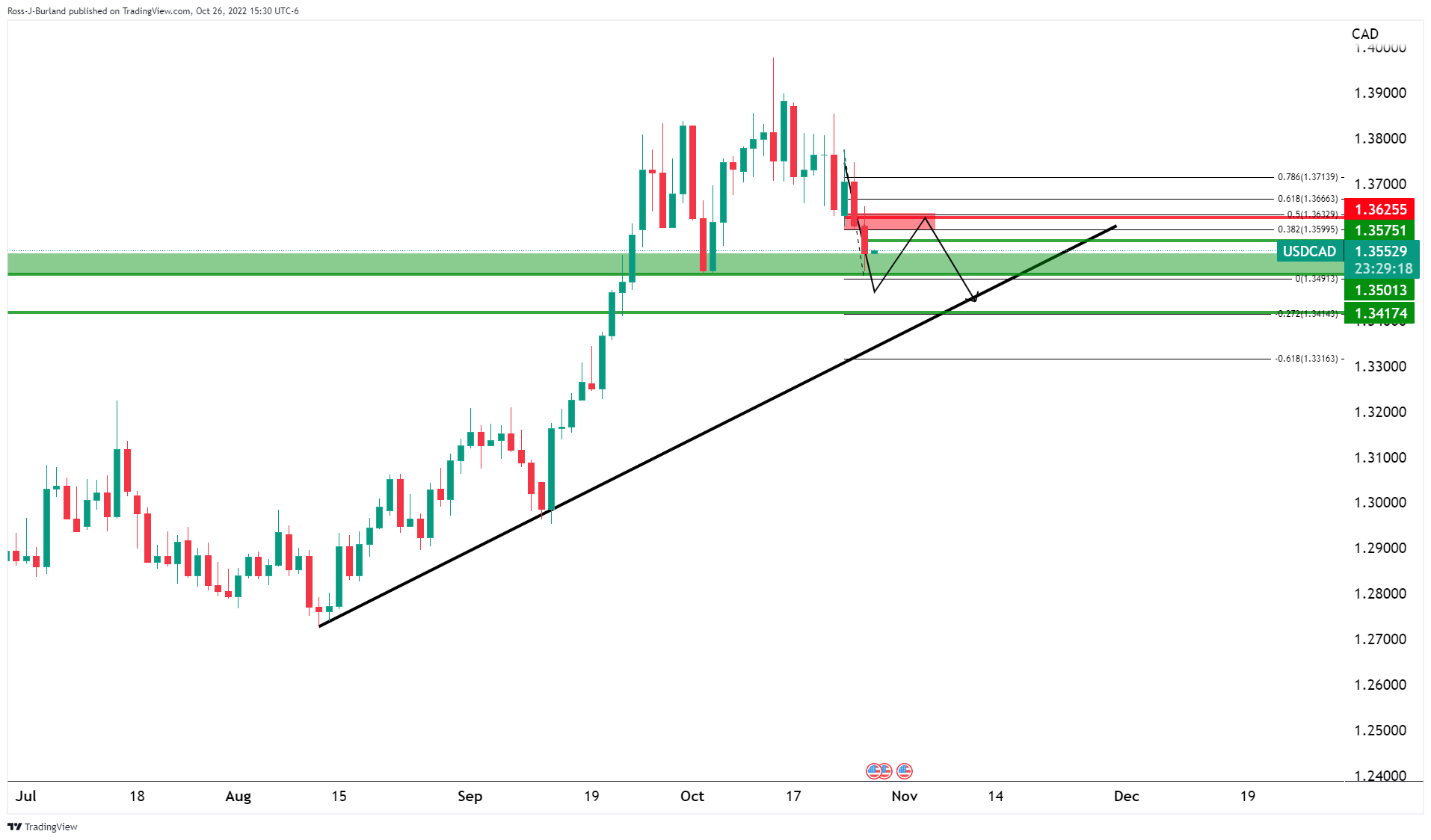
USD/CAD update
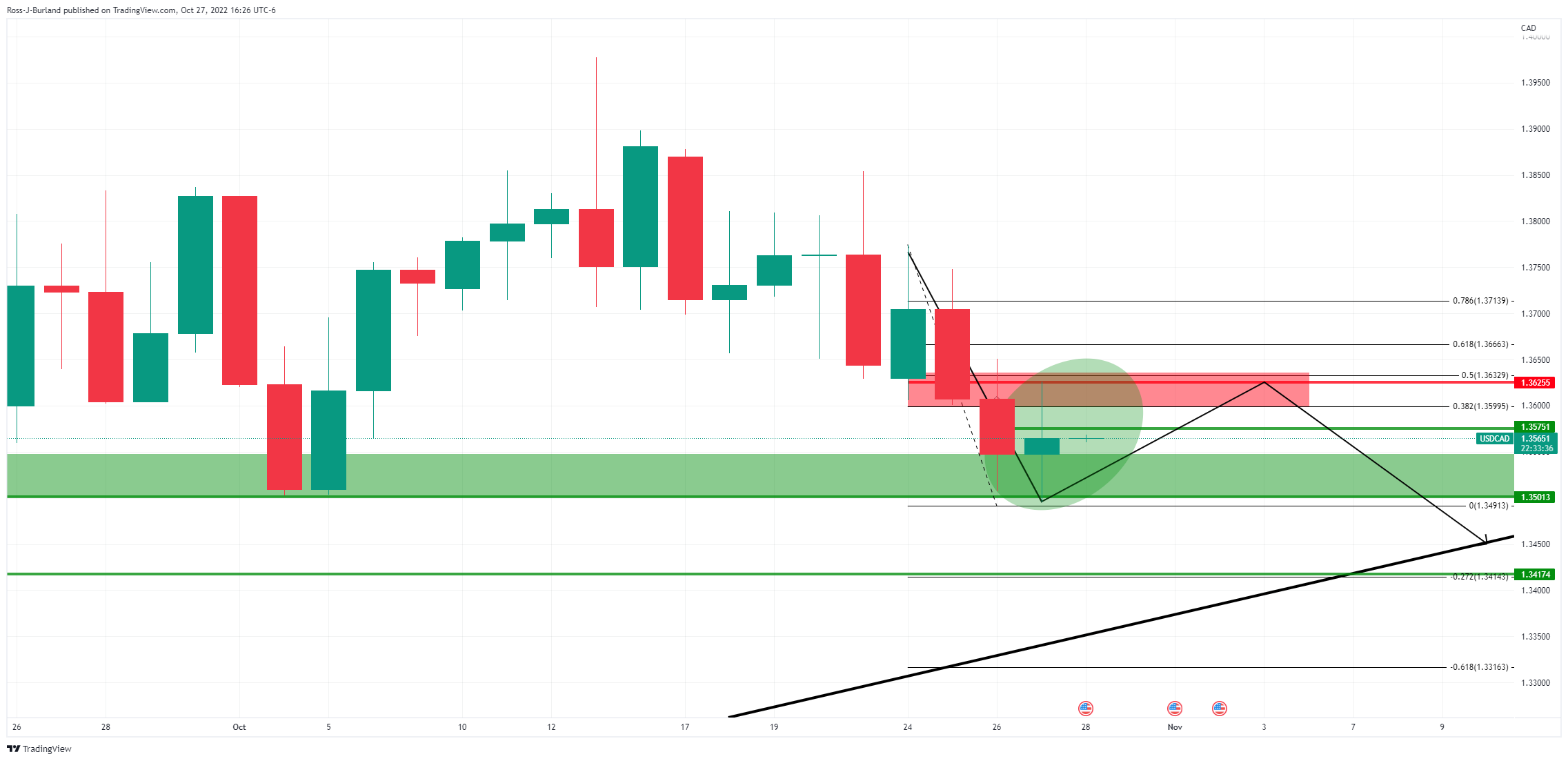
The price has indeed moved into the resistance, but where next?
USD/CAD weekly chart
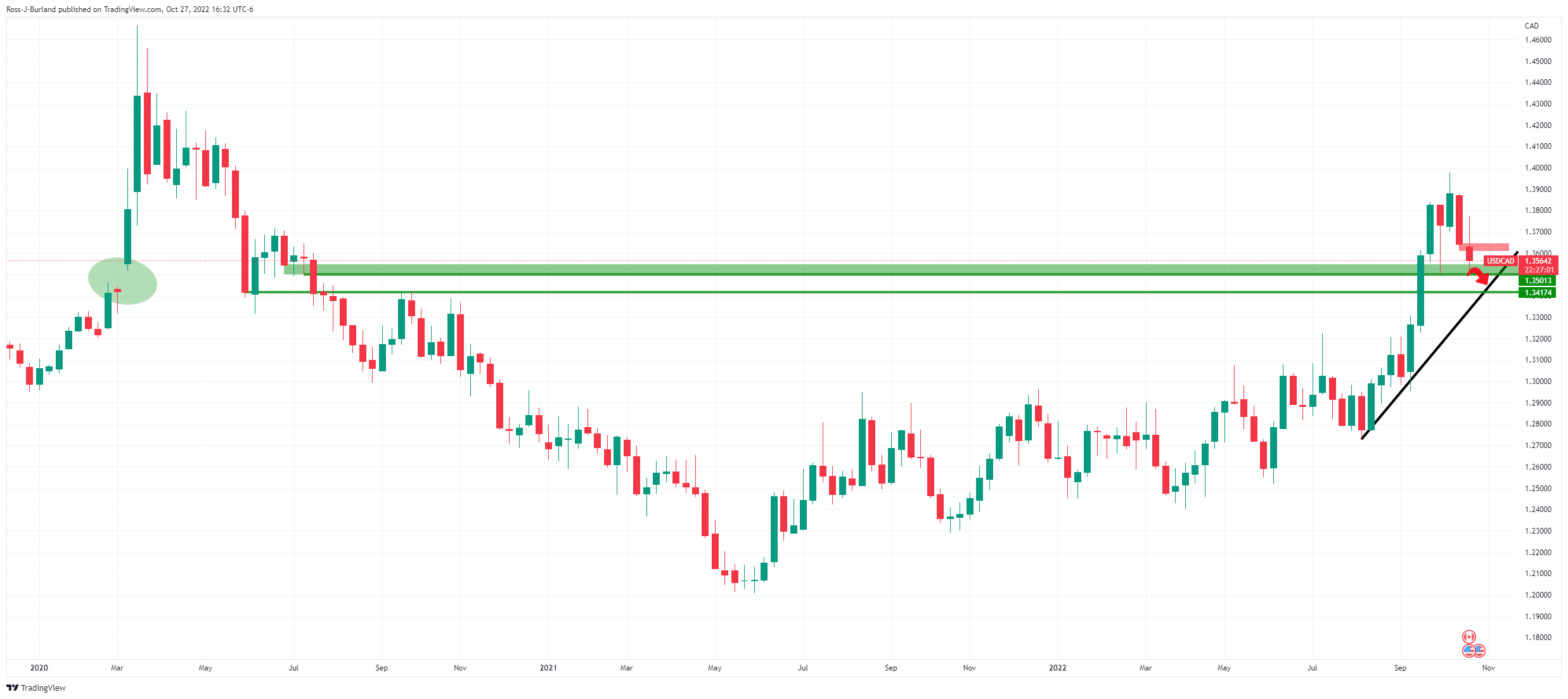
While the M-formation is a reversion pattern, there could still be a push into the trendline before the week is out:
USD/CAD outlook for the close
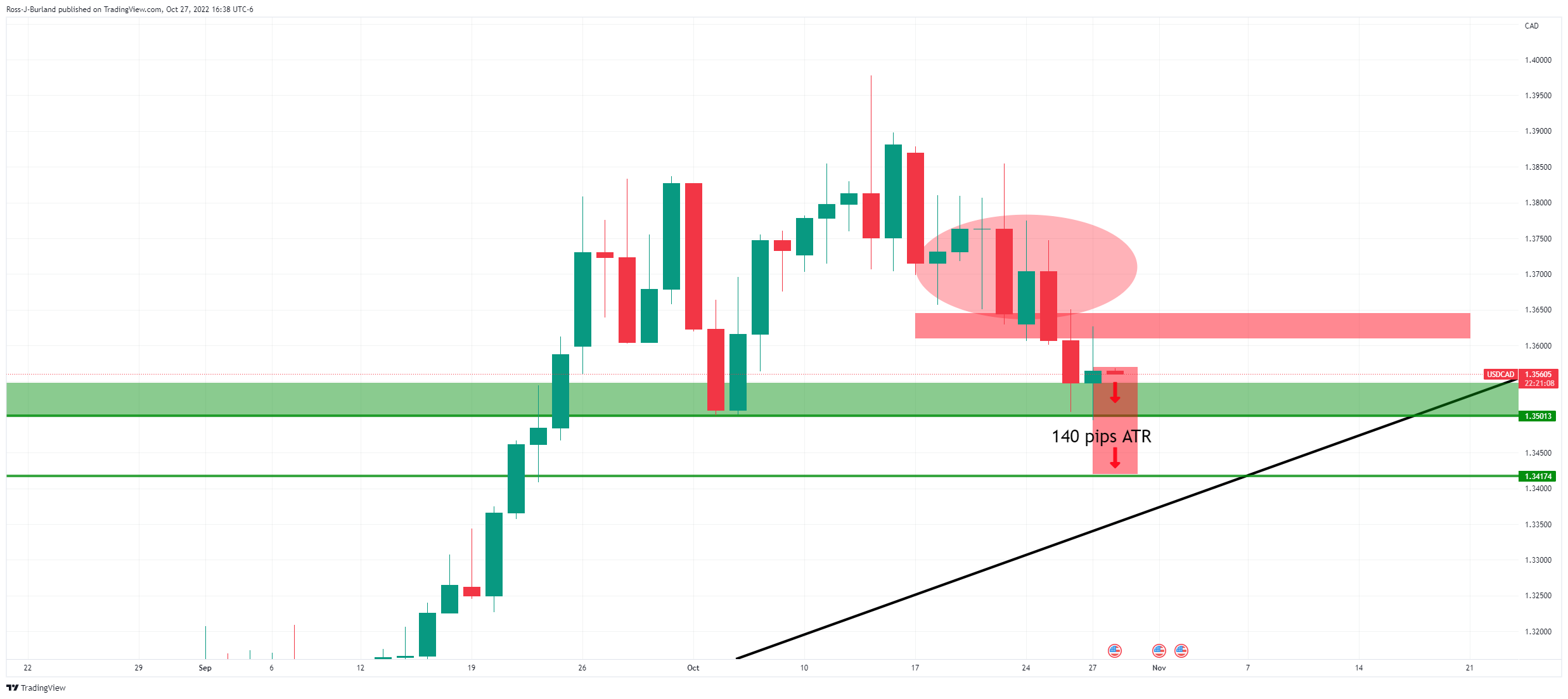
Given the length of shorts in the market and the less-than-convincing correction the prior day and considering the 140 pip daily ATR, there are prospects of a move towards 1.3420. After all, we are still on the front side of the trendline:
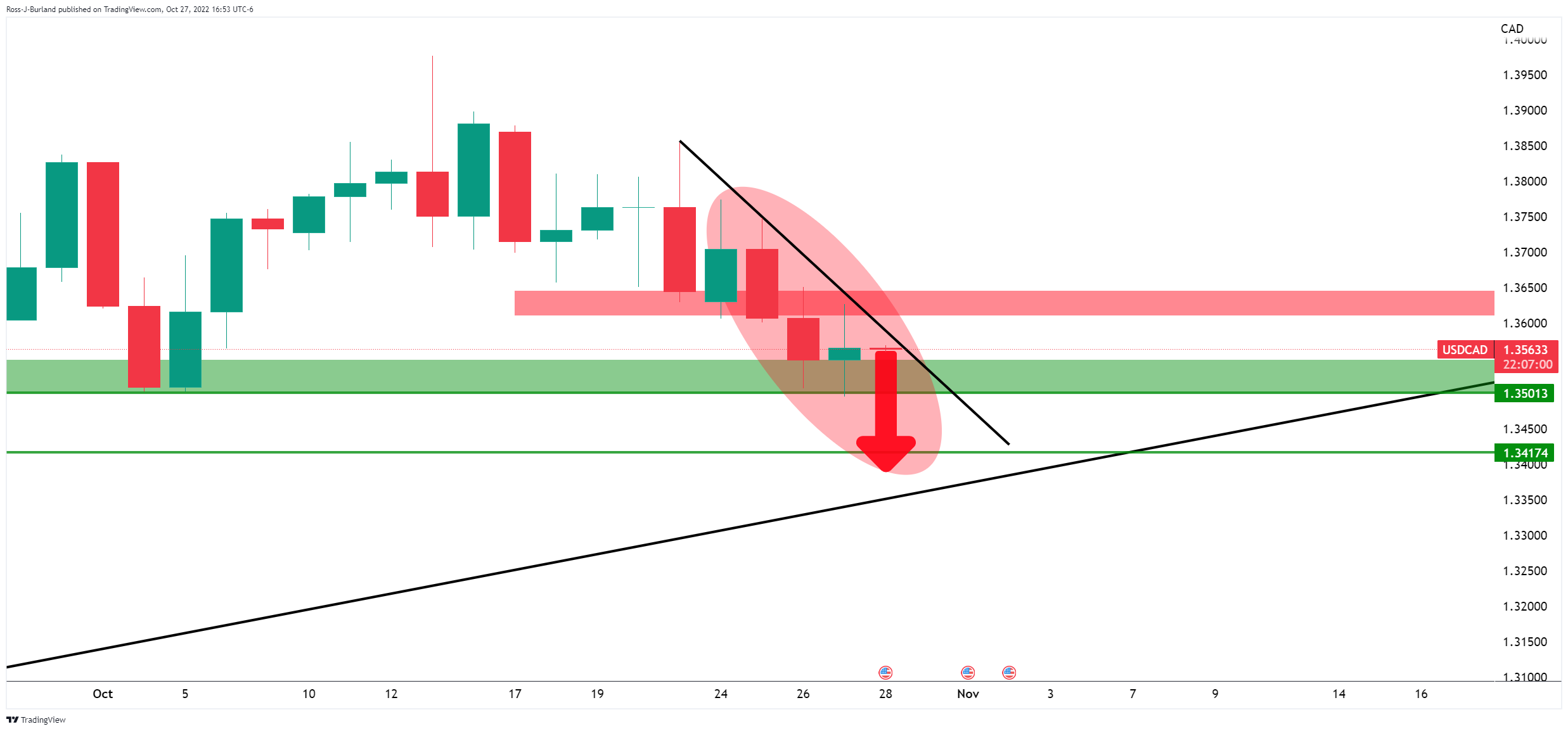
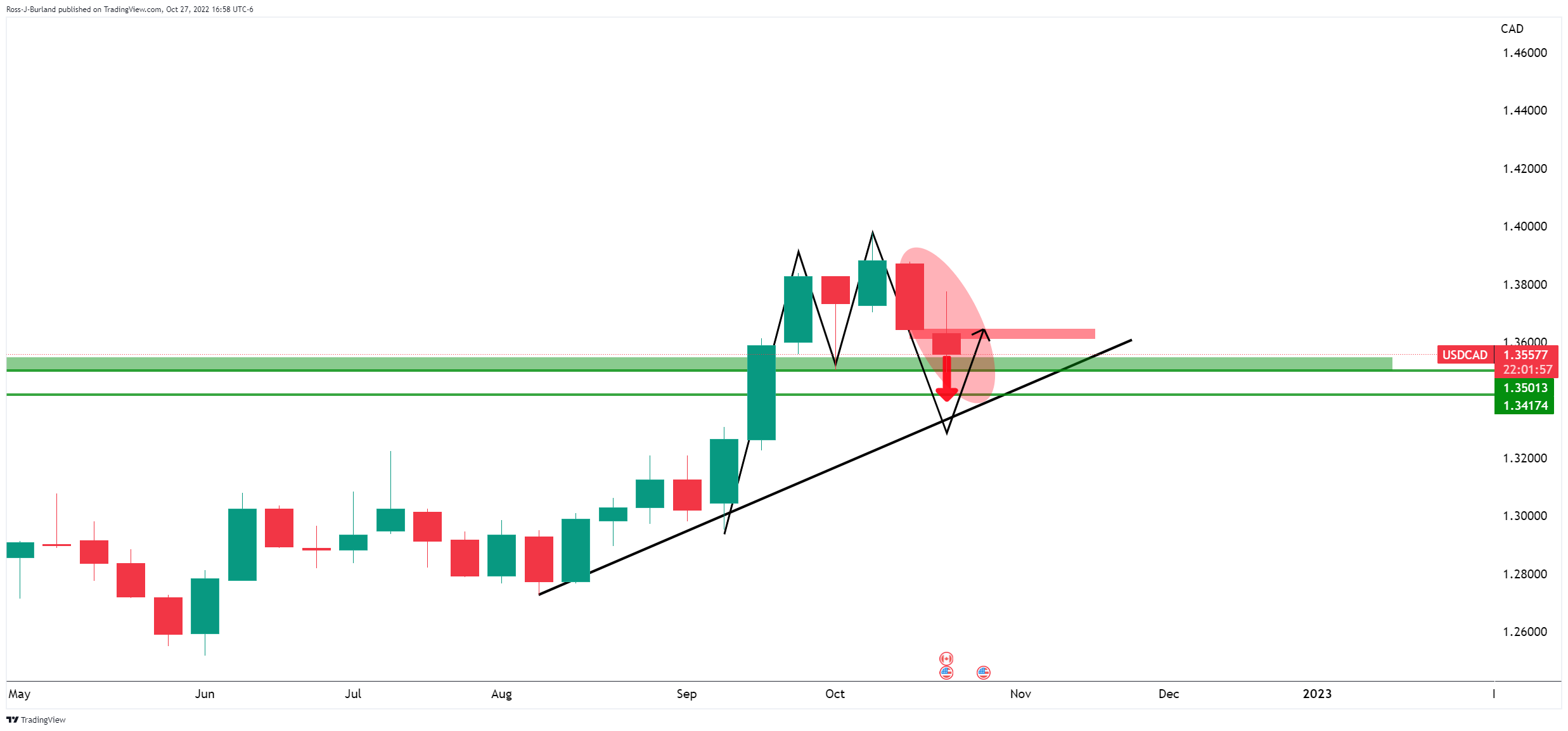
(Weekly M-formation)
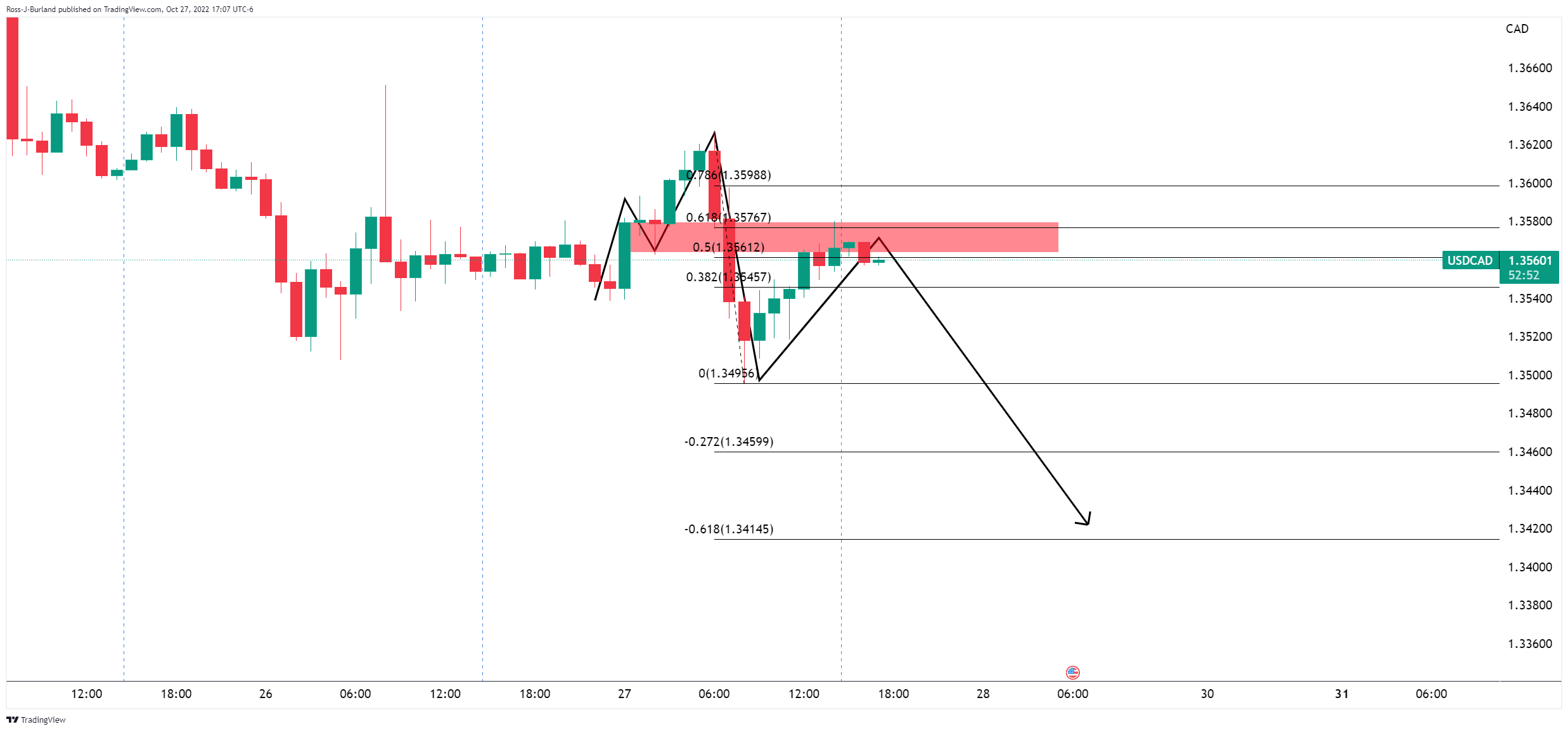
(H1 chart)
We have seen a steady correction into a 50% mean reversion of the bearish impulse and the neckline of the M-formation/resistance which leaves the path of least resistance to the downside now.
-
00:03
USD/CHF oscillates above 0.9900 amid a firmer DXY, focus shifts to Fed policy
- USD/CHF is juggling above 0.9900 as robust GDP numbers have strengthened the DXY.
- A decline in consumer spending has sent yields on a bumpy ride.
- Discussions on price mechanism between EU, the UK, and Switzerland have hogged the limelight.
The USD/CHF has shifted into a rangebound structure above the critical hurdle of 0.9900 in the early Asian session as investors are shifting their focus toward the monetary policy decision by the Federal Reserve (Fed). The asset resurfaced firmly from around 0.9840 as the US dollar index (DXY) recovered sharply after investors shifted back to the risk-aversion theme.
S&P500 snapped two-day gains after a meltdown in Meta Platforms Inc. (META) on Thursday. The tech-giant nose-dived to a five-year low amid a dismal earnings report. This triggered the danger of keeping money in the risk-perceived assets.
The DXY enjoyed sheer liquidity after an upbeat Gross Domestic Product (GDP) report. The US GDP escalated to 2.6% for the third quarter against the projections of 2.4%. A positive growth rate number snapped the contraction of two straight quarters of CY2022 from January to June.
The instrument that has been impacted after the release of the GDP report is US Treasury yields. The 10-year US Treasury yields dropped to 3.93% after the Commerce Department showed a decline in consumer spending that accounts for 70% of US economic activity. Consumer spending has expanded by 1.4%, remaining lower than the 2% growth recorded in the second quarter. A slowdown in consumer spending indicates that mounting inflationary pressures are exhausting after all.
A decline in consumer spending rate has trimmed the odds of a bigger rate hike by the Federal Reserve (Fed), if not, the projection could be less-hawkish next week.
On the Swiss franc front, discussions on the collaboration of the European Union, the UK, and Switzerland to combat soaring energy bills are in focus. The EU is planning to bring a price cap mechanism on energy prices, which may support households against soaring energy bills. The strategy is to be executed without boosting demand or delivery of electricity to foreign consumers at subsidized prices.
In response to that, the Trading bloc’s executive arm is advising EU members that such a price limit would have to be extended to power-importing countries like the UK or Switzerland for it to be effective, reported Bloomberg.
-